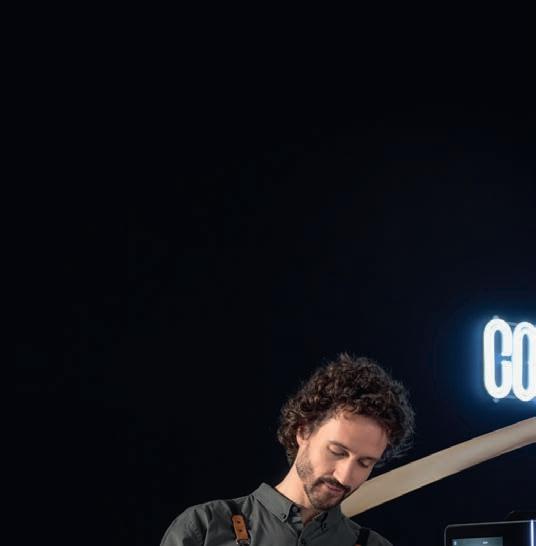
JULY/AUGUST 2025










JULY/AUGUST 2025









Pact CEO Paul Turton on his recipe for subscription success

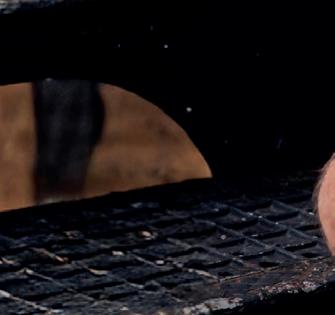
Chobani’s Arthur Karuletwa on modernising the system
Fighting fungus with fungus
On the cusp of a solution to coffee’s biggest threat
The rise of robot baristas
Will androids replace humans behind the bar?





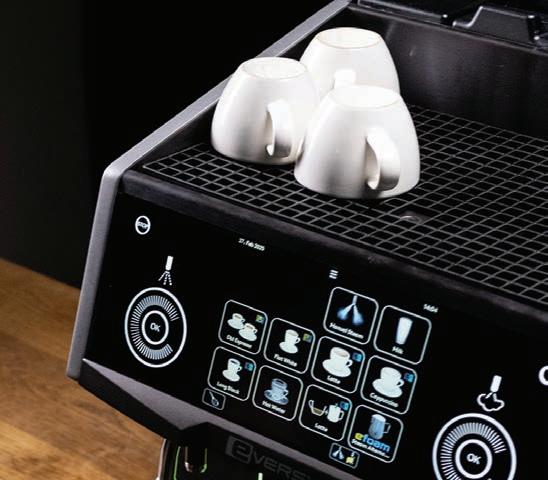





















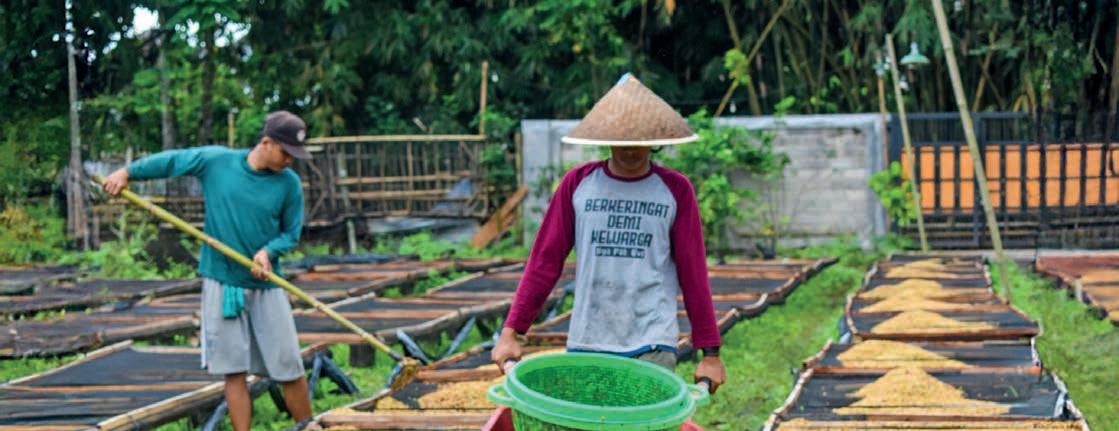
30 Beyond the café
10 A tough Pact to follow Pact Coffee CEO Paul Turton on bouncing back from COVID and the importance of fair pricing.
“The commodity market is the evil of the industry. It doesn’t work – it’s anachronistic. At some point, the coffee market will retreat and then how will farmers be treated?”
Paul Turton CEO, PACT COFFEE
14 Saving farming’s future
The average age of global coffee farmers is now above 50, with intervention needed to prevent the sector aging out.
18 Fighting fungus with fungus
Coffee leaf rust is threatening coffee harvests worldwide, but science is heading back to the disease’s source in search of a solution.
24 Regions on the rise: Indonesia
GCR spotlights one of the world’s biggest producers and why its farming sector is primed to continue its boom.


More than 11 million people wake up in hotels each morning. How is coffee helping to elevate the customer experience?
38 Can sustainability fix the supply chain?
Chobani’s Arthur Karuletwa had a vende a against coffee, and he’s using it to do good across the industry.
42 Robusta roule e
As interest in Robusta continues to rise, a new flavour wheel has been developed to evaluate the oftenunder-appreciated species.
45 Rise of the robot barista
As android baristas become more common across the globe, where does the traditional barista fit in with this technological revolution?
48 Jumping the Q
Sweeping changes are coming to the Specialty Coffee Association’s Q Grader program.
22 Barista bootcamp
Eversys brought together 12 new Brand Ambassadors for a three-day bootcamp at its Swiss HQ.



28 Arabian insights
SEB Professional reveals why modern coffee culture is rising so rapidly in the Middle East.
34 Good for the Soul
Schaerer is preparing to release a new feature to improve accessibility to its Coffee Soul machines around the world.
36 A gracious Host
The countdown to Host Milano 2025 is on, but what makes the flagship tradeshow a can’t-miss event?
50 From origin with love
Latin America’s single-origin producers received plenty of interest at MICE2025, and they’re already preparing to return next year.
58 Venice canal coffee
One café in Venice has given a new meaning to ‘a taste of Italy’.
04 Editor’s note 06 News in brief
Marketplace 56 Diary dashboard
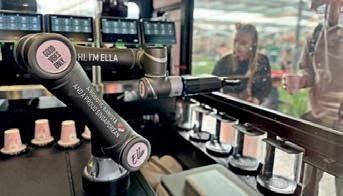

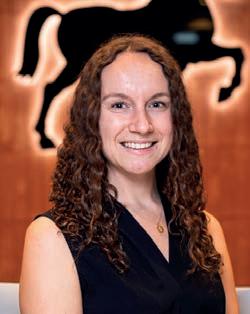
he rise of social media over the past decade has seen co ee trends accelerate at a pace I’ve never witnessed before. From canned cold brew to strawberry matcha lattes, mushroom co ee to premium decaf, just as one trend is catapulted into the limelight it’s swi ly overtaken by another.
But what happens when the fashion zzles out? Is it game over for that product or are trends not really that important a er all?
In this issue’s cover story, we explore the success of Pact Co ee in the United Kingdom, a direct-to-consumer subscription-based roaster that’s de ed the odds. While many other subscription platforms failed to bounce back a er the post-lockdown subscriber slump, ve years on the company is set for doubledigit growth in 2025.
CEO Paul Turton tells Global Co ee Report how Pact has managed to buck the trend and continued to grow the brand in the subscription space. He also reveals how the roaster has prospered despite volatility in the global green-bean market, and why communication is key to product price rises.
While trends may not be the be all and end all in terms of success, one that has recently swept the market is the introduction of pop-up cafés operated by robot baristas.
e android evolution of the traditional vending machine, which is gaining momentum in Asia and beyond, is popping up in public spaces such as
shopping centres, university campuses, and o ces. Amid the rising popularity of such venues, we ask Chinese Barista Champion Simon Sun if the robot baristas are a threat to the profession and if we’ll all soon be ordering our morning at white from a barista plugged into the mains.
Another area of the industry that could soon be seeking help from a mechanical labour force is origin. According to Co ee Consultant Gerd Mueller-Pfei er, the aging population of co ee farmers is one of the biggest challenges the sector will face over the coming years.
It’s estimated the average age of co ee farmers around the world is about 55, with that number rising to 60 in Africa. While co ee is o en a generational occupation, many younger people are seeking alternative careers in urban areas that o er better nancial opportunities. In this edition, we explore the extent of the issue and some of the programs in place to avoid an international labour crisis.
Of course, there’s lots more to dive into, including an overview of Indonesia’s rapidly growing producing sector, the rise of premium co ee experiences in hotels, and the introduction of a Robusta avour wheel.
Enjoy the issue. GCR
Kathryn Lewis Editor, Global Coffee Report
CHIEF OPERATING OFFICER
Christine Clancy christine.clancy@primecreative.com.au
PUBLISHER
Sarah Baker sarah.baker@primecreative.com.au
MANAGING EDITOR
Myles Hume myles.hume@primecreative.com.au
EDITOR
Kathryn Lewis kathryn.lewis@primecreative.com.au
JOURNALISTS
Georgia Smith georgia.smith@primecreative.com.au
Daniel Woods
daniel.woods@primecreative.com.au
ART DIRECTOR/DESIGN
Daz Woolley daz.woolley@primecreative.com.au
HEAD OF DESIGN
Blake Storey blake.storey@primecreative.com.au
BUSINESS DEVELOPMENT AND SALES MANAGER
Charlotte Murphy charlotte.murphy@primecreative.com.au
CLIENT SUCCESS
Cailtin Pillay caitlin.pillay@primecreative.com.au
PHOTOGRAPHY
David McConaghy
HEAD OFFICE
Prime Creative Pty Ltd 379 Docklands Drive, Docklands, Victoria 3008 p: +61 3 9690 8766 enquiries@primecreative.com.au gcrmag.com
SUBSCRIPTIONS
+61 3 9690 8766 subscriptions@primecreative.com.au
Global Co ee Report Magazine is available by subscription from the publisher. e rights of refusal are reserved by the publisher.
ARTICLES
All articles submitted for publication become the property of the publisher. e Editor reserves the right to adjust any article to conform with the magazine format.
COPYRIGHT
Global Co ee Report is owned and published by Prime Creative Media. All material in Global Co ee Report Magazine is copyright and no part may be reproduced or copied in any form or by any means (graphic, electronic or mechanical including information and retrieval systems) without written permission of the publisher. e Editor welcomes contributions but reserves the right to accept or reject any material. While every e ort has been made to ensure the accuracy of information Prime Creative Media will not accept responsibility for errors or omissions or for any consequences arising from reliance on information published. e opinions expressed in Global Co ee Report are not necessarily the opinions of, or endorsed by the publisher unless otherwise stated.
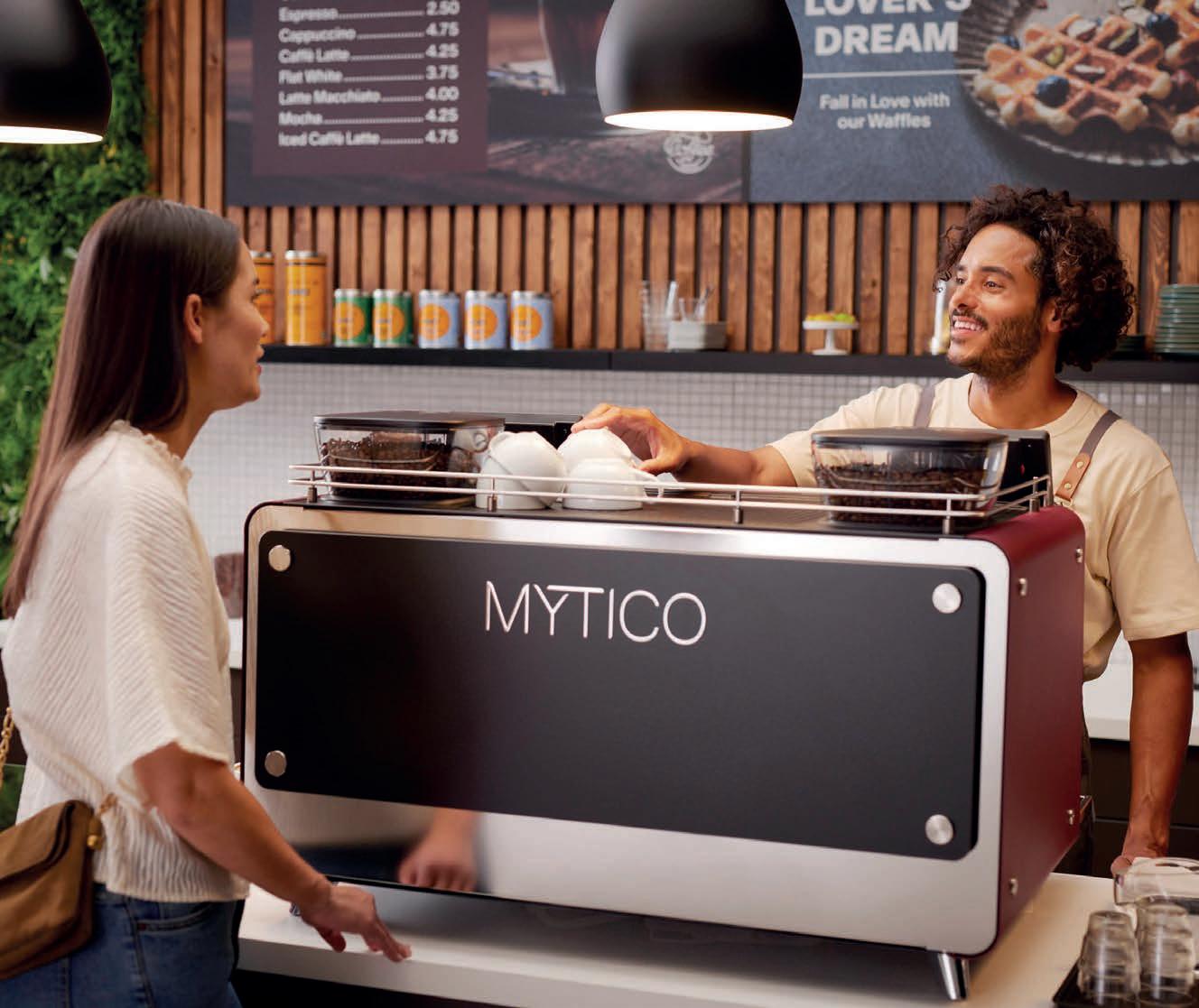
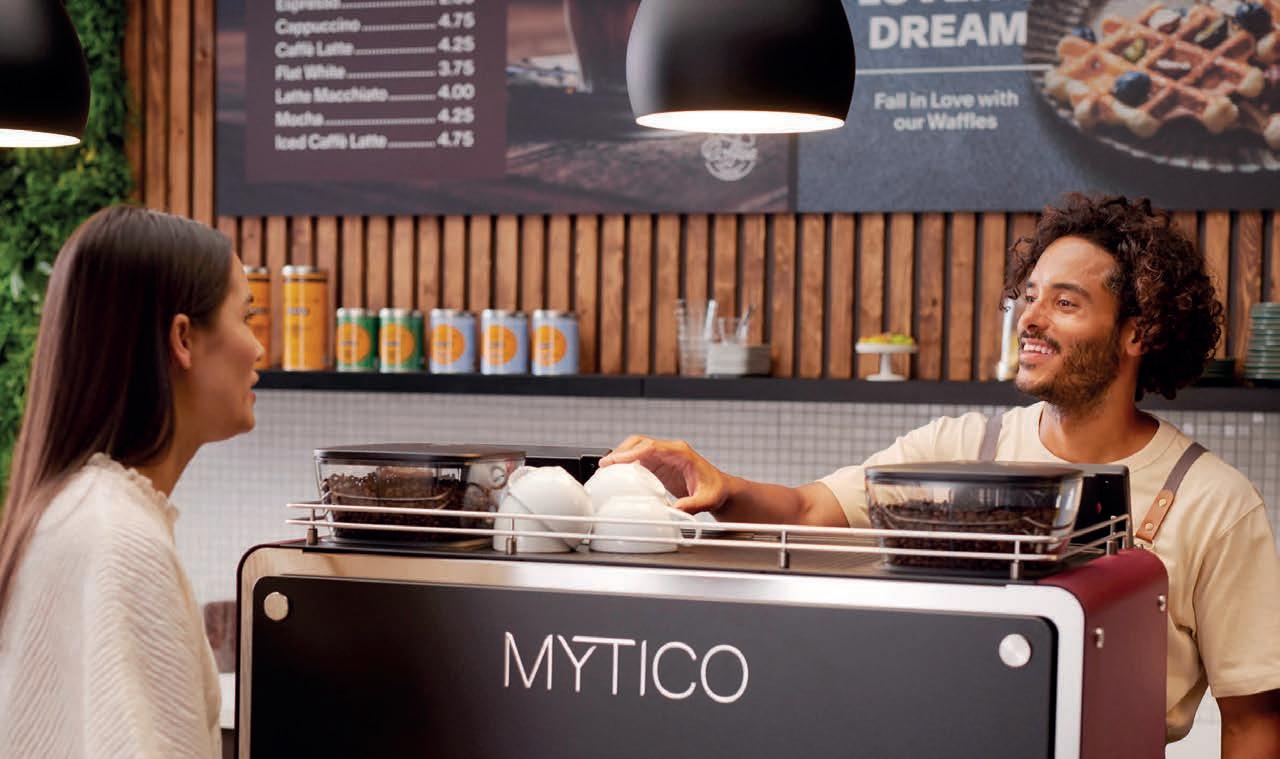








Did you know that most customers enjoy chatting with the barista?*) They are even willing to pay more if the service is friendly and welcoming. The low height of our Mytico coffee machine facilitates contact between barista and customer, ensuring perfect coffee drinks and additional sales.
*) Allegra Project Cafe Scandinavia 2023

Chobani and La Colombe Coffee Roasters’ Arthur Karuletwa is on a mission to use sustainability and traceability to make the global coffee supply chain more equitable for all that operate within it.
Karuletwa, who was born in Rwanda, witnessed the country’s genocide against the Tutsi in 1994, and has been pursuing this mission for more than 20 years at every level of the supply chain.
Through his work not only with La Colombe, but also his vocal desire to ensure fair compensation for coffee producers through the Apple TV series Omnivore and La Mazocco documentary Rise of Espresso, Karuletwa uses coffee as a bridge for reconciliation and a tool for fighting poverty to further educate and inspire action in the improvement of equity in the global coffee industry.
See page 38.
Coffee farming as a profession is at risk of ageing out according to Founder of International Coffee Consulting Gerd Mueller-Pfeiffer. He is urging the industry to align on the seriousness of the issue and more strongly a empt to prevent young people from leaving coffee production.
The average age of coffee farmers in mass producing nations sits somewhere between 50 and 60, with traditional family succession planning beginning to fail where it had previously been a bedrock of the industry.
US$38.8 billion
The projected revenue of the Middle East’s coffee industry by 2030.
Expocacer (Cooperativa dos Cafeicultores do Cerrado) in the Brazilian producing region of Cerrado Mineiro says it is seeing strong success with a pair of key programs it has implemented to address the issue, Expocacer Teens and Elas no Café. However, the global cultural nature of coffee farming means it will be difficult to replicate these programs around the world.
See page 14.
A group of researchers in Brazil are on the brink of a promising and sustainable solution to managing coffee leaf rust (CLR), a fungal disease estimated to cause billions of dollars of economic damage to the industry each year.
CLR infects the leaves of coffee plants and hinders their ability to produce cherries. After first being identified in Africa in the 19th century, it has now spread to all coffee producing countries.
The research team, initially led by Professor Robert Barreto, has travelled the world to zone in on 10 promising fungal






38

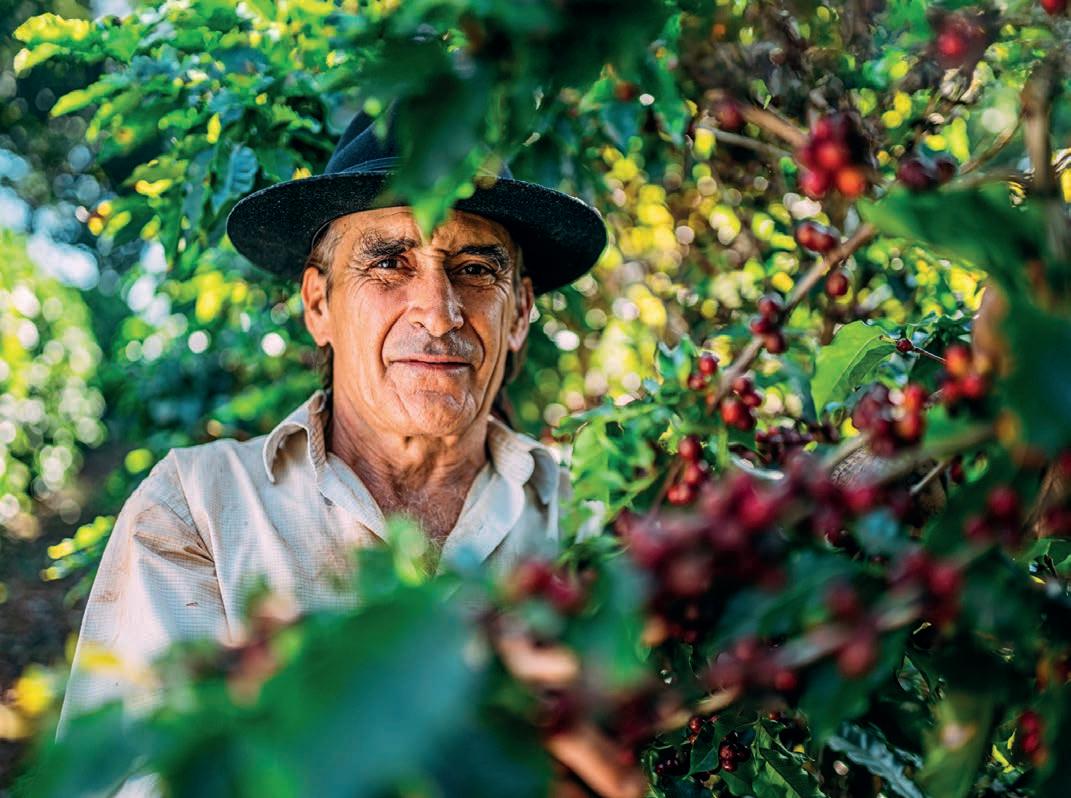

isolates they believe have the potential to help manage CLR and protect coffee plants from the disease. Despite their success, difficulties in obtaining funding could see the project grind to a halt at its current critical late stage.
See page 18.
The Specialty Coffee Association (SCA) has announced sweeping changes to its Q Grader program, making the most significant alterations to its delivery since it was established more than 20 years ago.
The impending change, due to come into effect in October 2025, has been a ributed to the SCA’s desire to more closely align the program with its Coffee Value Assessment (CVA), which was introduced in 2022 following years of development.
With high-production nations including Brazil, Colombia, and Indonesia all recently signing Memorandums of Understanding
to implement the CVA in their own national operations, the SCA hopes the evolved Q Grader program will allow producers to speak the same “quality language” as one another in order to create be er communication, prices, and alignment across coffee’s international value chain.
See page 48.
Zalkifli Hasan, Indonesia’s Coordinating Minister for Food Aff airs, has publicly stated his ambition to see the country’s coffee production capabilities increase to surpass that of the world’s second-leading producer, and fellow regional production titan,Vietnam. Indonesia’s coffee production for 2024/25 stands at 10.9 million 60-kilogram bags, almost 20 million bags behind Vietnam, which is expected to have a lower harvest yield than average due

Can the coffee industry help secure farming’s future by bringing young people back to production? Image: Nexa/stock.adobe.com.
to ongoing climate challenges.

With a steadily growing economy, increasing consumer interest in local products, a booming specialty coffee scene, and a farming network with potential to further increase crop yield, Indonesia looks to be establishing a position where it could significantly improve its coffee production outcomes. However, the three-to-four year cycle of coffee tree growth could prove a limiting factor in seeing immediate results. See page 24.
The Middle East is one of the world’s fastest-growing coffee consumer regions, yet coffee culture has been ingrained in the region for centuries. The local market is projected to reach a revenue of US$38.8 billion by 2030, with a compound annual growth rate of 4.6 per cent from 2024.
Saudi Arabia has special significance in the growing region, according to SEB

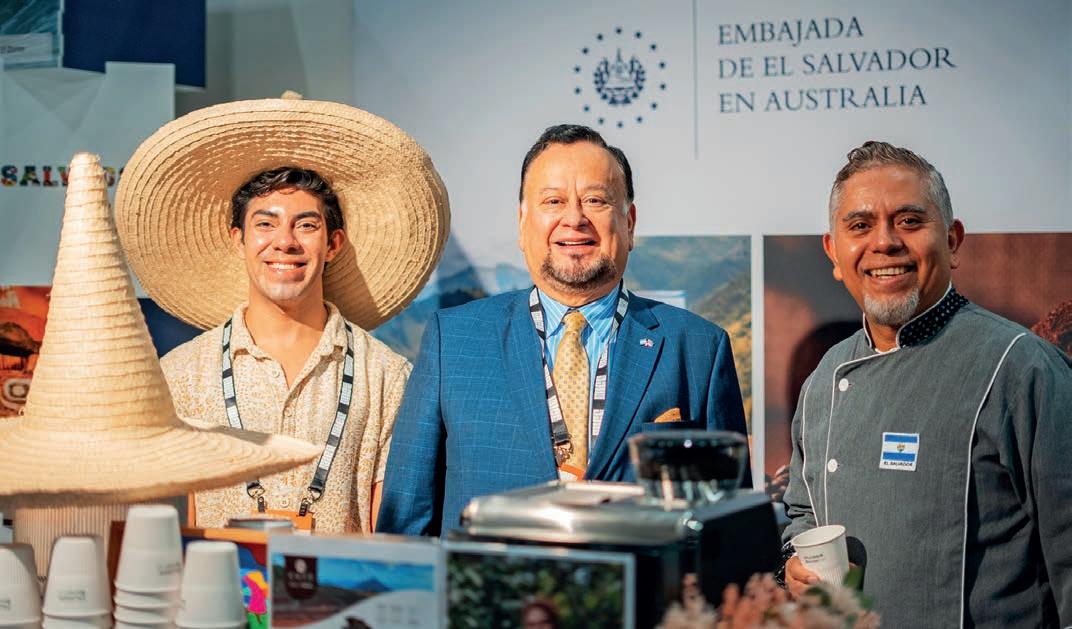
Professional Vice President APAC/MEA/ Russia Claudio Maschie o, who says its location within the broader region makes Saudi Arabia an ideal trading hub within MEA.
“These factors, combined with growing demand for specialty coffee, high levels of investment in the sector, and government initiatives to promote local coffee cultivation, are making Saudi Arabia a key player in the global market,” he says.
See page 28.
Once restricted to the lobbies of innovationloving tech companies and high-traffic public spaces, robot baristas are now becoming more commonplace in areas typically held by barista-run cafés. Asia is quickly establishing itself as the hub for this latest consumer-facing
506,974 kilograms
The amount of coffee roasted by Pact Coffee in 2024/25.
automation innovation in the coffee sector, with products such as Singapore’s Ella and China’s COFE+. The capability of these robots, and others being developed around the world, continues to rapidly expand.
Is there room for both robot and traditional baristas to operate in the café market, or are android baristas on the verge of changing the profession and café culture for good?
See page 45.
Delegations from embassies and businesses representing a host of Latin American coffee producers have praised Melbourne International Coffee Expo (MICE2025) for helping create business opportunities for their countries, with Costa Rican delegate Gonzalo Quesada saying the event culminated in 86 leads for local businesses.
Representatives from Costa Rica, Ecuador, El Salvador, and Guatemala all a ended MICE2025 with the LatinAmerican Business Council, with the latest edition of the event seeing El Salvador return to MICE in an official capacity for the first time in a decade.
After the successful introduction of the

Roasters Playground in 2025, the focus on single-origin producers is set to take another step forward at MICE2026, with MICE Events Director Siobhan Rocks detailing plans to introduce Trip to Origin as a feature for next year’s event.
Trip to Origin will shine a light on the first step in the coffee value chain, and celebrate coffee farms and farmers while educating event a endees and providing a platform for green bean traders, dedicated embassies, and coffee producers to make new business contacts and partnerships.
See page 50.
Pact Coffee was an early adopter of the coffee subscription model. Since it was established in 2012, it’s grown to become one of Europe’s largest coffee subscription services under the leadership of CEO Paul Turton, and has thrived despite the post-pandemic downturn in interest in subscription services.
The company hasn’t been immune to the rising green bean prices that have plagued the coffee industry, and previously communicated its intention to increase
prices of most bags by £1 to its customers to compensate for the rising costs. Now, despite those challenges, it is on track to achieve 15 per cent growth in 2025.
Turton believes Pact’s desire to pay a premium for its beans has made it mostly immune to price rises. He says Pact pays farmers, on average, 48 per cent more than the Fairtrade base, and sources 60 per cent of its beans from women or gender equity groups, and 34 per cent from ruralpoor farms – all while roasting 506,974 kilograms of coffee in 2024/25.
See page 10.
Eversys has hosted its inaugural Shotmasters Bootcamp at its Swiss headquarters in Sierre to further grow its connection with customers and communities in some of the more than 100 countries in which its machines are distributed.
The selected Brand Ambassadors, also known as Shotmasters, embarked on a three-day regime involving training, cupping, and creative programming led by 2017 World Barista Champion and Eversys Global Ambassador Dale Harris.
Eversys Marketing Director Miranda Caldwell says the Shotmasters were selected from a variety of hospitality and foodservice backgrounds to represent the business’ individual target markets and introduce the company to a more diverse range of perspectives.
See page 22.
Automatic coffee machine manufacturer Schaerer is embarking on a journey to make quality coffee more accessible to more people ahead of the global launch of its Easy Access function.
Designed to allow its Coffee Soul machines to be accessed by people using wheelchairs, the function involves the installation of a module that features a series of control bu ons in front of the machine’s drip tray.
A variation of the Easy Access function was released in Schaerer’s United States market in 2023, but the company is now set to make the retrofi able module available worldwide in October 2025.
Schaerer Global Product Manager Xiaoya Tan says the business has already received extensive interest in the Easy Access function from a range of offices and
convenience stores around Europe, and believes the function will also find success in hospitals and other healthcare se ings.
See page 34.
The countdown to one of the world’s most popular foodservice and hospitality events, Host Milano 2025, is on.
With more than 2100 exhibitors from 50 countries and 180,000 professional visitors from 166 nations a ending Host Milano 2023, this year’s event is set to be another massive coming together of the international Hospitality, Restaurant and Catering (HoReCa) sectors.
Coffee is, once again, set to play a key role in the event, and Exhibition Director Francesca Cavallo says the Salone Internazionale de Caffè (SIC) section of the tradeshow has been revamped to take its place at the heart of the exhibition over twin-level pavilions.
The World Barista Championship, hosted by the Specialty Coffee Association, is also returning to Milan as part of the event. Cavallo says hosting the international competition underscores Host Milano’s commitment to the global coffee community.
See page 36.



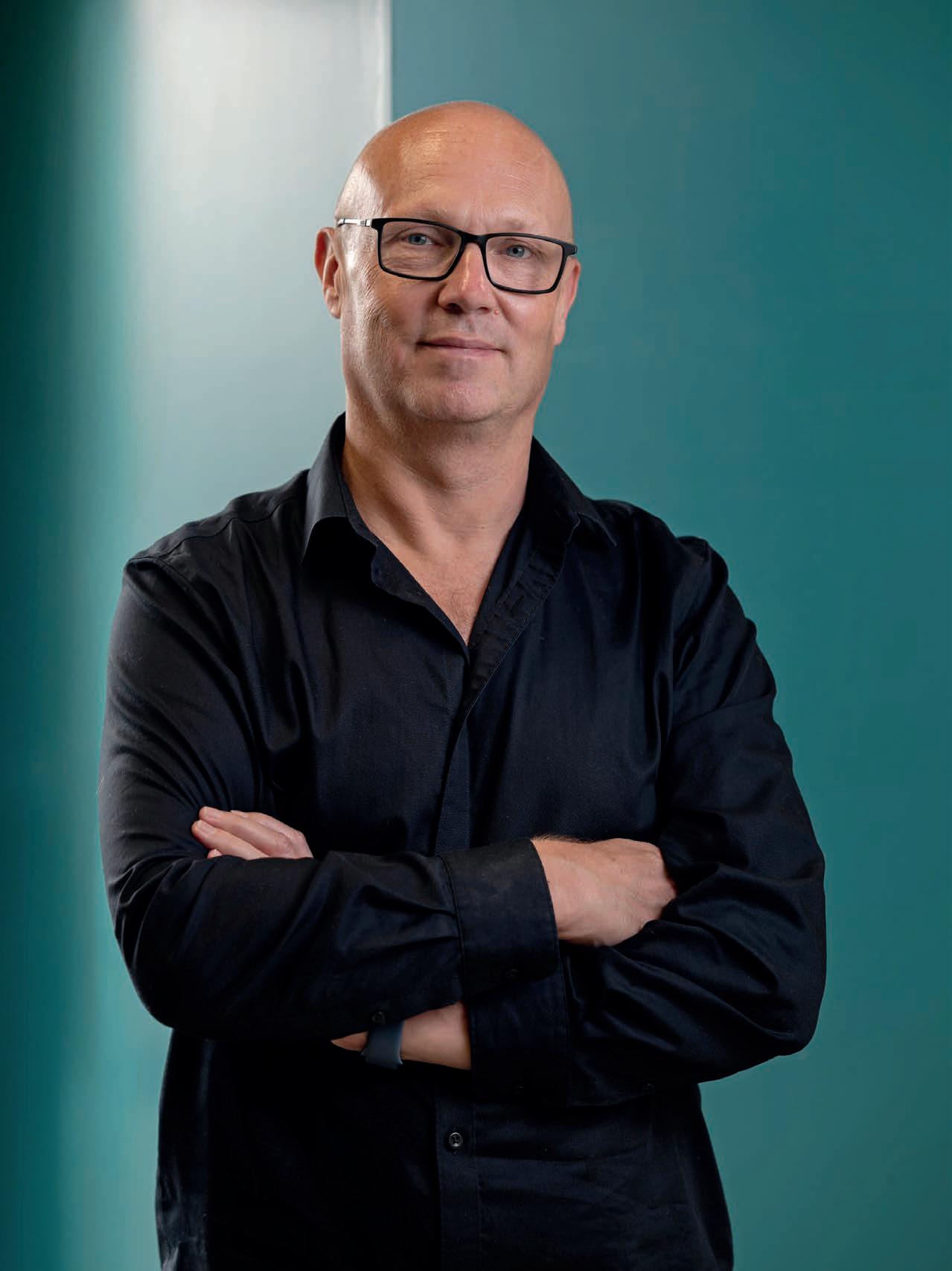


While many coffee companies have struggled to get subscription services off the ground, Pact Coffee has bucked the trend. With double-digit growth predicted for the next year, CEO Paul Turton reveals how the roaster has continued to gain momentum post-COVID and the subsequent subscription drop-off.
HERE ARE FEW companies that experienced business growth during the COVID-19 pandemic, yet for the select few already in the subscription market, having their customer base stuck at home was an opportunity for expansion.
As many struggled to shi to the new, smaller way of life during lockdowns, one of the simple joys during the period of con nement was receiving everyday luxuries such as roasted co ee, baked goods, and beauty products by post. For those who could a ord it, retail therapy lived up to its moniker. In the United States (US), for example, between March and May 2020, the retail subscription service market saw growth rates of up to 145 per cent. And this wasn’t just a solution for consumers. For retail and some hospitality services, delivering goods direct to the customers who could no longer visit their venues or their customers’ venues was a method of generating revenue. In the global co ee industry, this shi saw many roasters pivoting from B2B wholesale to B2C subscription models.
In July 2020, it was estimated that one in 10 people in the United Kingdom (UK) had subscribed to a food or drink service, with
co ee among the most popular products. Roasters of all shapes and sizes across the world launched subscription schemes and many commentators predicted the consumer preference for getting products delivered direct to their doors would outlive the pandemic.
And yet, as soon as people regained their freedom, the appetite for the subscription
services started to decline. Many co ee companies tried to keep this new revenue stream alive, but most failed to reverse the decline – except for a select few, such as Pact Co ee in the UK. One of the reasons for its continued success? It didn’t pivot.
“Pact Co ee started as a subscription service and then established a roastery. Whereas many roasters entered the
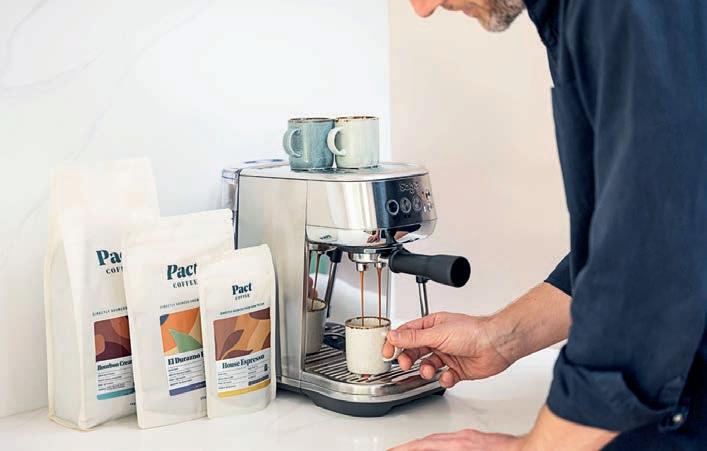
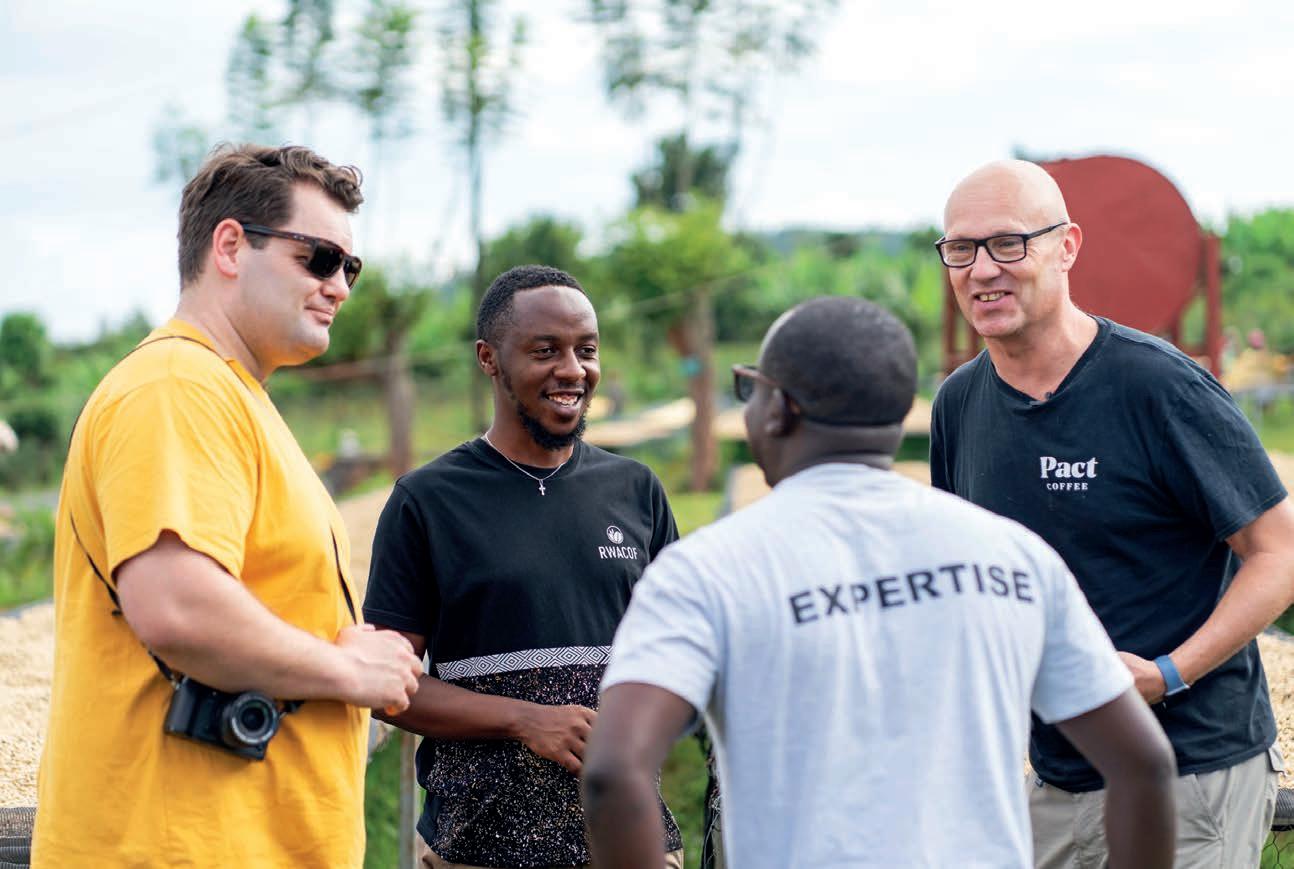
subscription market in response to COVID-19, we’d been in the industry since 2012,” Pact Co ee CEO Paul Turton tells Global Co ee Report
“Part of our success was that, in the specialty sector, we were the rst in. Our Founder Stephen Rapoport started the business from his kitchen, fed up with the problematic co ee industry. Being the early adopter de nitely helped us.”
Today, around 60 per cent of roasters in the UK o er subscription schemes, with a large proportion of those companies entering the market during the rst lockdown. For most of those roasters, subscriptions now make up a minor percentage of their revenue, yet Pact’s more than 45,000 active subscribers account for 65 per cent of its business.
“ e technology we use has been another major factor in our success. When everyone entered the subscription market in 2020, most of them launched on the Shopify platform, which does a good job but doesn’t o er the tailoring that’s needed,” Turton says.
“Our technology allows us to o er our customers several key things: the ability to change frequency to suit their schedule as well as pause their subscription at any time; a very easy method to cancel, which
is hugely important to build trust; and the option to click an ASAP button and get co ee delivered the next day, whatever point in their subscription cycle.”
e online retail platform Pact uses is bespoke, with a support team working on the site and with customers every day to keep the business ticking over.
“Subscription services are hard – it’s not a license to print money. A lot of B2B providers are disinvesting because they haven’t cracked it,” he says. “Numbers spiked massively during COVID and then they dropped o . We did experience a tail o too, but we’re once again in that growth cycle.”
Since taking over as CEO in 2017, Turton has tripled the company’s annual turnover from £5 million (US$6.64 million) to £15 million (US$19.92 million). With a background in big businesses such as O ce Depot in the US and Hays PLC in the UK, stepping into the role he wanted to utilise his leadership, sales, and marketing experience in a smaller, more innovative setting.
“I wanted to truly make something my own and take the reins of a more entrepreneurial setup,” Turton says.
“As soon as I met the team, I could feel the energy in the room – it was completely di erent from my 20-year corporate experience where more o en than not people didn’t want to be there. Everyone was very passionate about the project. Stephen had given his heart and soul to the business and it was time for him to pass that on.”
In the eight years that have passed, Turton has helped build on the original subscription business by introducing a B2B wing of the operation, which is evenly split between o ce and corporate settings and the hospitality sector such as cafés, restaurants, and bars. In 2023, Pact also entered the grocery market, with its product rst introduced to high-end supermarket Waitrose.
“It’s funny because supermarkets were our original enemy – they were the main market we were going up against. But we’d been watching Waitrose’s progress over some time and what persuaded us to partner with them was their care and consideration for the products they choose to stock,” he says.
“ ey care for the producers and they’re there for growth. We’ve been in Waitrose for 18 months now and gone from strength-to-strength. Since then, we’ve also

partnered with other luxury grocers such as Ocado, Whole Foods, and Abel & Cole.”
While expanding into grocery and B2B has accelerated Pact’s growth, the lion’s share of its revenue is still generated by subscriptions. As of May 2025, it had 45,000 regular subscribers in the UK, 30,000 of which had bought more than 20 bags of co ee from the brand. So how did Pact bounce back a er the post-COVID slump?
“Some of it was having a rock-solid proposition. From the beginning of the business, we have focused on freshness and our process means customers never receive a bag of co ee that’s more than seven days old. Generally, it’s roasted on day one and delivered by day three,” Turton says.
“We also cracked many of the retention challenges. In the early days, we were heavily discounting the rst bag and nding a lot of people didn’t stick with us past that. Now, we encourage new customers with free gi s instead, such as a V60, cafetiere, or Clever Dripper. A free gi works well because it gets the customer familiar with the proposition.”
Another string to the team’s bow has been the use of intuitive technology. Pact’s web team developed a Co ee Picker tool that helps customers select co ees that suit their preferences, which uses customer feedback as well as user data to generate suggestions.
“We normally send new customers a crowd-pleasing blend we know they’ll love rst, before starting to introduce them to more fruity and oral beans,” he says.
“Our menu is always changing and our customers typically have the opportunity to choose from more than 200 co ees over a year. It’s important to us to cater to both the co ee connoisseurs as well as mainstream audiences who are only just being introduced to specialty co ee.”
Green beans and cost increases
While the co ee industry has experienced one of its most challenging years due to high co ee prices, supply and demand issues, and shi s in consumer buying habits, Pact Co ee is on track to achieve 15 per cent growth in 2025.
“We made some important changes to protect the integrity of what we do – including a price increase of £1 on most bags – and the result has been overwhelmingly positive, with 99 per cent of customers choosing to stay with us. It’s a testament to the strength of our customer base and the value they place on quality, ethics, and transparency,” Turton says.
“We have been crystal clear with our
“Subscription services are hard – it’s not a license to print money. A lot of B2B providers are disinvesting because they haven’t cracked it.”
Paul Turton CEO, PACT COFFEE
communication that farmer welfare remains essential to our business.”
Forming direct-trade relationships and ensuring co ee farmers receive fair payment for their crop has been a pillar of the brand since day one. In the 2024/25 period, as per the company’s impact report, Pact roasted 506,974 kilograms of co ee. It paid farmers, on average, 48 per cent more than the Fairtrade base. What’s more, 60 per cent of the beans were sourced from women or gender equity groups, and 34 per cent from rural-poor farms.
“We work directly with 200 farms across the globe and can pay a premium for the co ee we source. We manage our supply chain from farm to cup and this model allows us to cut out the middleman and make a good margin while still paying farmers well,” he says.
According to Turton, this model of paying a premium means Pact hasn’t been impacted as greatly by market volatility as many other roasters.
“While the commodity market has been going crazy, we’ve been able to cope because we were already paying more for the co ee and we don’t have to deal with so many constituent parts along the supply chain,” he says.
“ e spike at the start of 2025 did give us a headache, but nothing more than a headache because we’ve been paying well over commodity rates for a long time and so the shi was less seismic for us.
“ e commodity market is the evil of the industry. It doesn’t work – it’s anachronistic. At some point, the co ee market will retreat and then how will the farmers be treated? We’re deeply worried about the impact it will have on them.”
ough Pact is currently competing for the title of Europe’s biggest co ee
subscription service with Dutch company e Co eevine, an international setup that curates beans from di erent specialty roasters, Turton says there are no plans for European expansion just yet.
“ ere’s still plenty of room for growth in the UK – not just in direct-to-consumer but also in B2B and grocery,” he says.
“Unfortunately, some co ee companies will be struggling due to green bean prices. I think we’ll see more price increases across the board and we may see some roasters cease to exist, so there may be more market share there.
“Our proposition is really robust and we’re in a strong position to take more share in all of our chosen markets.”
As interest in specialty co ee in the region continues to grow, the CEO believes there’s opportunity for high-end o erings to overtake popular products such as capsules.
“Over the next few years, I think specialty will grow faster than any other part of co ee. Pods have stagnated and that’s opening the market for high-end roast and ground products like ours. I believe we’re in the right space,” he says.
“I’m incredibly proud of what our team have achieved so far and what’s to come.
ey are a very stable, talented, and knowledgeable group that have stayed true to the foundations of the brand. We’re positive and optimistic about the future.” GCR












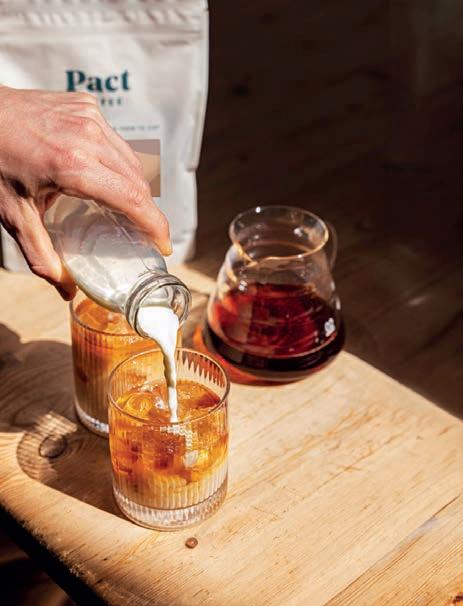
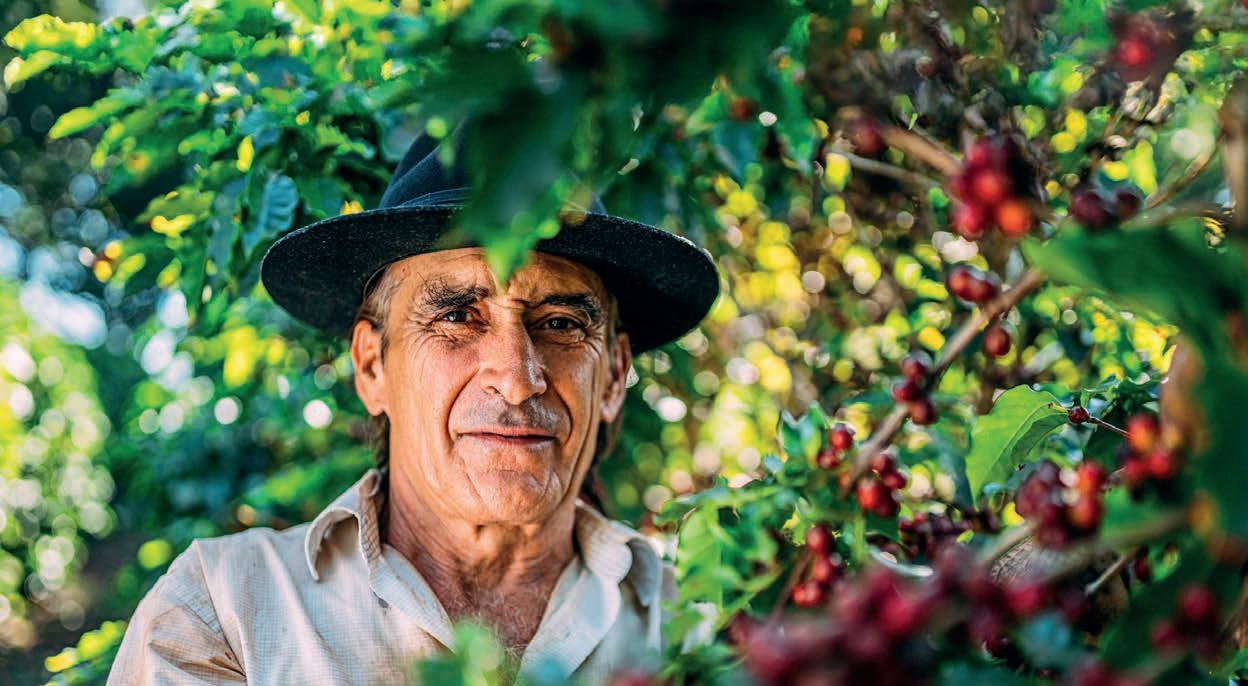


















Coffee farming is traditionally a job passed down generations, but that’s changing. Can this emerging challenge be turned into new opportunities?
ILLIONS OF DOLLARS, millions of people, and dozens of countries rely on the co ee value chain to provide economic stimulus, jobs and wages, and a point of national pride. It’s a pillar of international trade and one of a handful of key sectors in which the whole world can unite around a common means.
For all the positives the broader co ee industry can provide those who work and live in it, it would be foolish to ignore the issues that currently lie just below the surface. e continuing impact of climate change and rising green-bean prices are creating mass volatility within the production sector, while work to improve labour practice concerns remains ongoing. ere is one o en-overlooked issue that remains at large though. And if le unaddressed, its impacts have the potential to trickle through the entire co ee value chain from farm to cup.
Around the world, co ee farming as a profession is currently facing an age crisis. It’s a profession that has typically been passed down from generation to generation, but the average age of the co ee farmer is rising.
ose traditional family succession plans are hitting a wall, with fewer young people electing to pursue the careers of their parents. Should this issue continue, the already stressed global co ee markets will only be stretched thinner.
According to former Nestlé Executive and Founder of International Co ee Consulting Gerd Mueller-Pfei er, the average age of a co ee farmer in some of the world’s major co ee producers sits between 50 and 60 years of age.
He says this rapidly emerging challenge is only set to become a harder prospect to tackle as years go by.
“Co ee isn’t just a crop, it’s a generational
livelihood,” says Mueller-Pfei er.
“Many co ee farmers around the world are small holders. Since there is no formal pension system they rely on their land until they physically can’t work anymore.
“ e problem is there are not enough young people positioned to take over, and when that happens, you’re not just losing farmers, you’re losing the entire ecosystem of co ee knowledge and supply. is challenge will intensify in the future, because the pipeline is drying up in co ee production.”
Co ee production, much like many agriculture and trade professions around the world, is seeing a reduction of young people entering the industry. Rapid digitalisation has improved the ability for young people to grasp opportunities in new and emerging regions and elds.

With these new opportunities comes the challenge to established industries to innovate. In co ee production, this has presented itself through the issues it now faces in continuing family succession. e average age of the co ee farmer in Uganda, according to Mueller-Pfei er, is 55. In Colombia, it’s 56.
In Ethiopia less than ve per cent of co ee farm landowners are under the age of 35, and in Vietnam, which has a young national median age of 33.1, fewer than 10 per cent of farmers are under 35.
“Young people from co ee farming families are leaving rural areas for cities. In Colombia, no one wants to harvest co ee on the mountains when they can go to Bogotá and try to be an in uencer,” says Mueller-Pfei er.
“People are chasing education or simply a di erent lifestyle from their parents. Farming is o en seen as low income, which it is. e International Co ee Association estimates 5 million out of 12.5 million co ee farmers are living below the poverty line.
“More than 95 per cent of farmers have less than ve hectares of cultivated land, and there is not enough value in the system. It’s labour intensive, and climate risk in uences how much money you might make. Without real
investment, modernisation, or incentive, we will continue to push towards this demographic cli .
“ is isn’t a tap you can turn back on quickly once it runs dry. It’s a real issue.”
Pause for positivity
ankfully, this international issue isn’t being swept under the carpet, with major industry players monitoring and addressing the generational shi s with a number of initiatives.
As the world’s largest producer of co ee, the fruitfulness of Brazil’s co ee harvests have the potential to shape the industry. Should this succession issue become dire in the Arabica production powerhouse that is the Minas Gerais region, the results could be near irreparable.
Expocacer (Cooperativa dos Cafeicultores do Cerrado) operates in the northwest reaches of Minas Gerais, in the Cerrado Mineiro region, to promote socio-environmental initiatives to both improve the co ee produced and the lives of producers.
Executive Director of Expocacer Simão Pedro de Lima says family succession, in Cerrado Mineiro at least, is not currently a major issue.
“In this region, there is a culture focused on family succession. Few producers do
not have succession planning and we do not perceive major di culties regarding the presence of children in the family succession of the business,” says de Lima.
While Expocacer runs various programs to improve the co ee industry in Cerrado Mineiro, de Lima points to the ongoing success of two key initiatives in promoting continuing family succession: ‘Elas no Café’ and ‘Expocacer Teens’.
“ e Elas no Café program strengthens the socioeconomic sustainability of co ee production by more actively integrating women into production and management processes. It has a direct impact on co ee productivity and quality, since trained and valued women tend to invest more in sustainable and innovative practices,” he says.
“It enriches the cooperative’s human capital, promoting diversity and new perspectives in strategic decisions, and it also works to prepare new leaders, increase family engagement, diversify property management perspectives, preserve family identities and rural values, and create greater stability in the succession process.
“When all family members – men and women – are prepared and have their role recognised, succession occurs more harmoniously. It is an initiative that strengthens the present and guarantees the


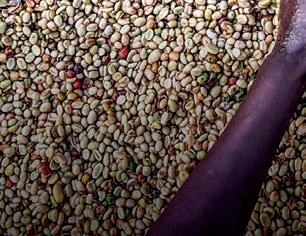
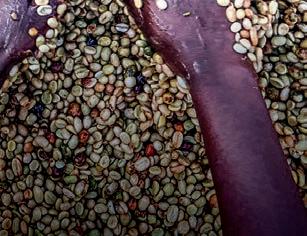

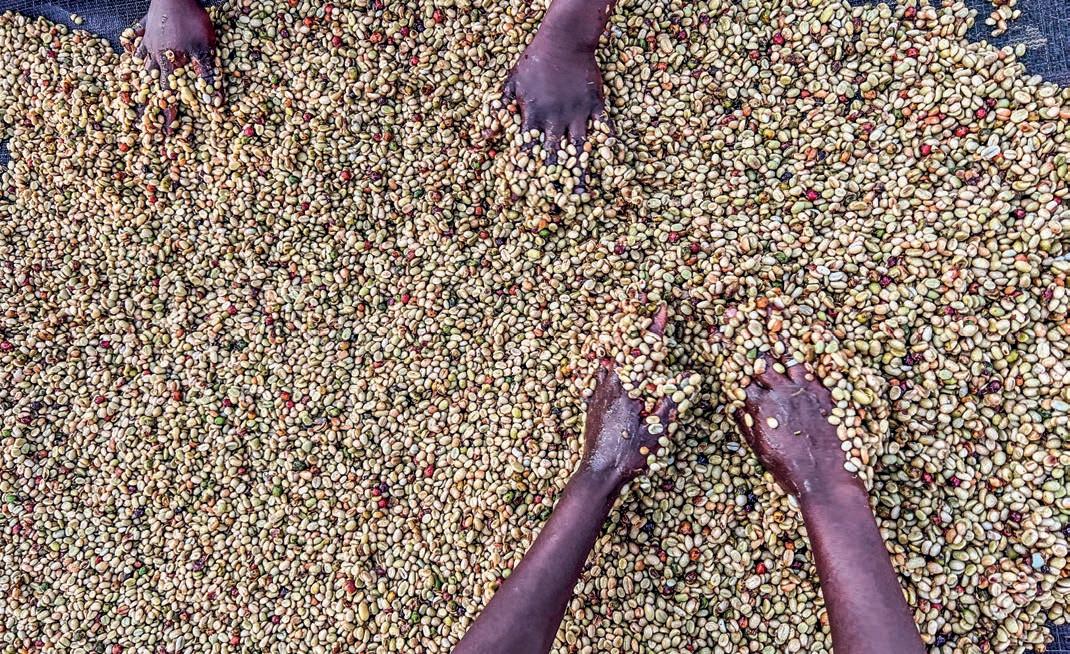


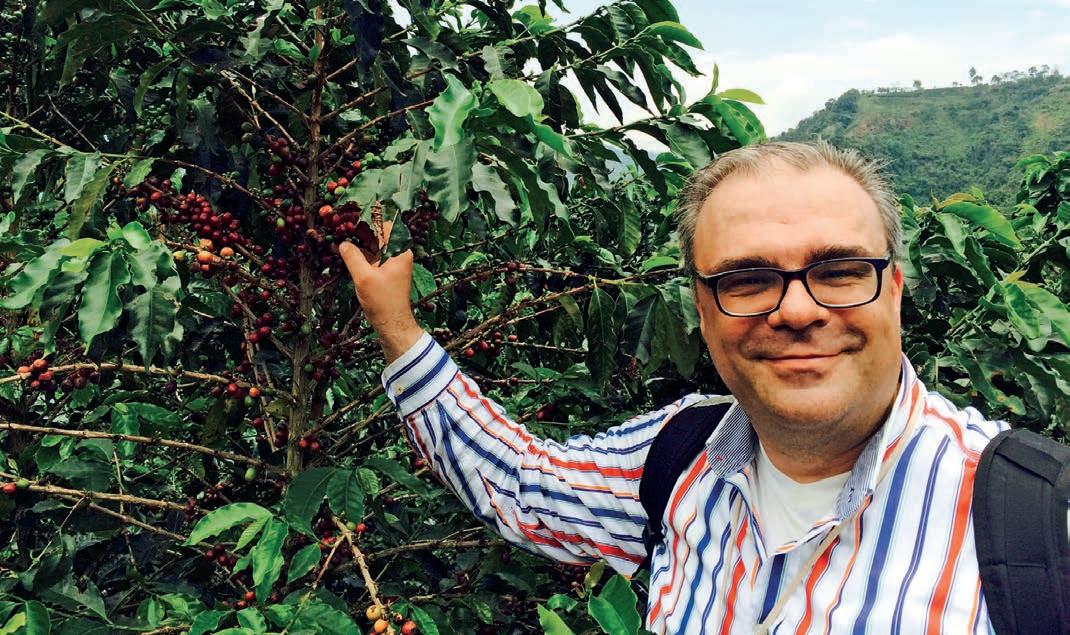
quality and future of family co ee farming in the Cerrado Miniero region.”
Where Elas no Café focuses on promoting fair, innovative, and inclusive co ee farming, Expocacer Teens looks to further involve the children of cooperative members to foster an interest in agribusiness.
“Expocacer Teens works as a school for successors. rough technical visits, educational activities, interactions with industry professionals, and cooperative experiences, young people understand and develop the skills to take on the role of managers of rural properties in the future with greater preparation, strategic vision, and socio-environmental responsibility,” says de Lima.
“When young people realise there are opportunities for development and innovation in the countryside, it becomes more attractive to remain in the co ee industry. e program directly contributes to reducing the loss of talent from rural areas to cities, promoting a healthy renewal sector.
“By being included in the agribusiness universe from an early age, young people bring new ideas, open space for more sustainable technologies and practices, and strengthen the competitiveness of regional co ee farming. Expocacer Teens is more than an educational program – it is a
strategic investment in the future of co ee farming in the Cerrado Mineiro region.”
Opportunity, but not solution e Expocacer programs demonstrate that high-producing regions can successfully guard against the potential co ee farmer age crisis, and continued investment across the many facets of co ee production could hold a key to the global co ee industry avoiding the brunt of the issue.
Since the turn of the century, Vietnam’s co ee farming sector has evolved from a relatively small player to global superpower.
Although this process has taken decades, it shows the power of targeted, long-term investment to progress co ee production.
With high-potential, small producing regions around the world preparing to boost their own production, could we soon see another shi in global market share?
Co ee was likely introduced to Vietnam in the 1850s by French missionaries, however, it took until the 1970s for the government to see it as a path to greater economic stability.
Following the political and cultural clashes that plagued the nation through mid-1900s, the Vietnamese government started to invest in its co ee sector.
As a result, today Vietnam accounts for 17 per cent of global co ee production and is
the engine room of Asia’s burgeoning co ee production industry.
Although it has taken the better part of half a century for Vietnam’s co ee industry to reach its current heights, Mueller-Pfei er says it is a prime example of how long-term government planning and investment can turn the fortunes of a country’s production.
“In the 1980s Vietnam was a relatively small producer of co ee, but a er years of government intervention and nancing it has become the second-largest co ee producer in the world,” says Mueller-Pfei er.
“Now, I see more opportunities presenting in countries like Uganda, Myanmar, Laos, and even China, but it takes time to transform the co ee production of a nation. ere is an opening for more climate resilient nations to grow their co ee production, but it takes years to form the generational knowledge required, and it’s di cult to grow without serious investment and coordination.
“I’m optimistic, de nitely ‘glass half full’, but that opportunity presents a lot of risks and is the collective task of us all.”
While Expocacer’s programs are nding strong success in Cerrado Mineiro, de Lima says there is no one approach that will work to continue promoting family succession all over the world.
“Although co ee farming is almost global in scope, each country has its own culture,

politics, and economic structure. It is not possible to have a model of practices that is universal,” he says.
“Co ee farming is a ected by the internal economic factors of each country.
ere are countries where co ee farming is developed as an economic factor for subsistence, others where it developed by the growers themselves, and others where it is developed at large scale.
“It is necessary to understand the macroand micro-structures to nd the best way to continue the activity for the future.”
Within the litany of issues currently threatening co ee farming, there is one common denominator that can help revitalise the industry: creating a care factor.
Without the care of national governments, not-for-pro ts and the world’s largest co ee brands, it will be near impossible to action the change needed.
Changes seen in co ee production over the generations must be identi ed and addressed, according to de Lima.
“Over time, co ee farming has come to be
“When young people realise there are opportunities for development and innovation in the countryside, it becomes more a ractive to remain in the coffee industry.”
Simão Pedro de Lima EXECUTIVE DIRECTOR, EXPOCACER
seen as an economic activity that involves much more than production. e co ee segment demands management, technical, nancial, and strategic planning knowledge. ese characteristics have changed the way co ee farming is understood,” he says.
“Working to reduce unpredictability, mitigate climate e ects, labour relations, environmental balance, commercial issues, and all other risk factors requires a strong
structure on each property, and wellstructured properties reinforce the macrostructure of co ee farming.” is complex issue can be distilled down to one primary driver through which to focus key decision-making processes, according to Mueller-Pfei er. Creating purpose for the farmer.
He says if the positive stories of young role models are shared and farming becomes more bankable as a business, progress will be made in overcoming this challenge.
“Without any serious push, if we don’t see any impact at scale in the next ve to 10 years and we as a society don’t do anything, I guarantee in 20 to 25 years we will run into incredibly serious co ee supply issues,” he says.
“We now have a generation that has been growing up digitalised, and that generation doesn’t want to be le isolated in rural areas. Now, you can create a lot of purpose-driven things to re-engage them and meet the rising global demand for farmers.”
“It’s a di cult challenge facing the industry and it cannot be solved in 12 to 18 months, but I believe we can do it.” GCR


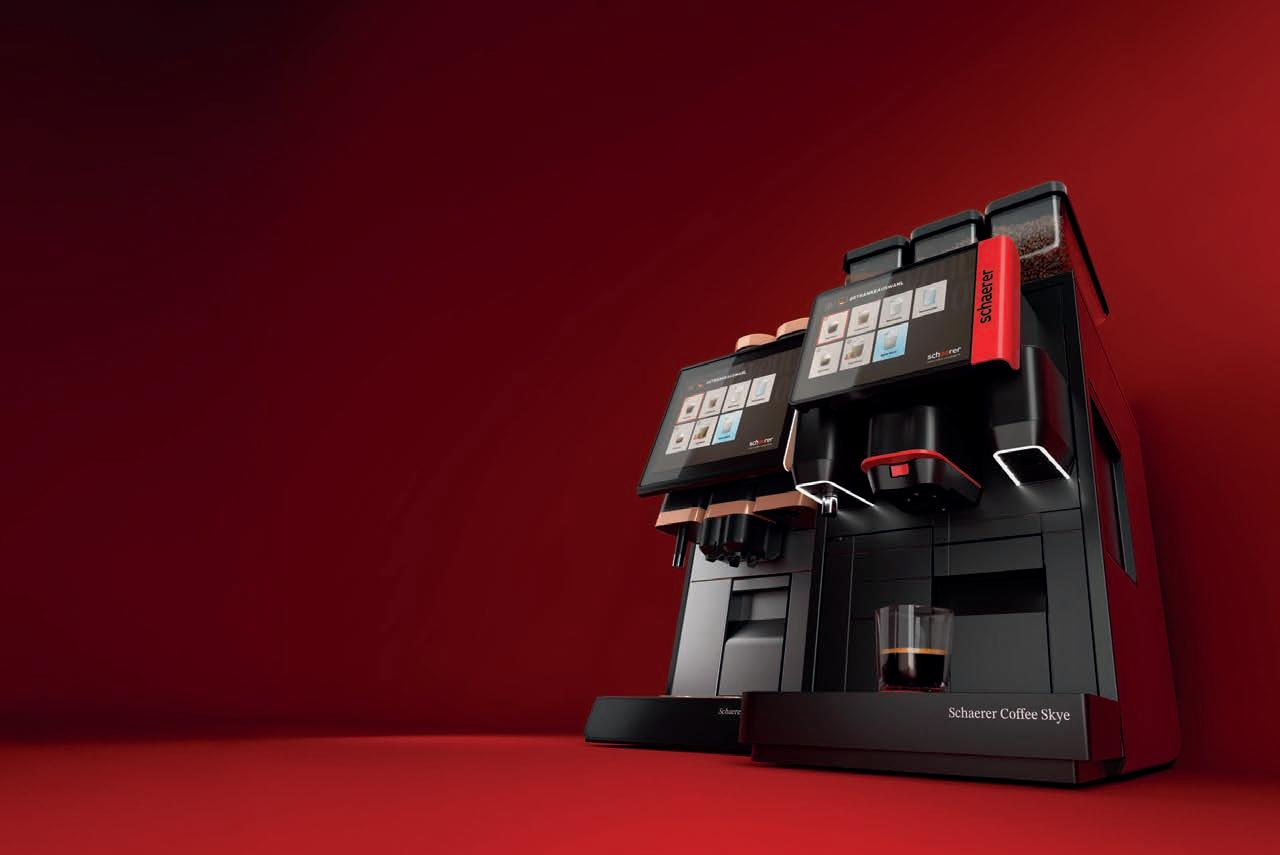






A group of researchers in Brazil are on the brink of a promising sustainable solution to one of the coffee industry’s biggest threats, yet funding issues could see their research cease if no one steps in to progress the project.
HE COFFEE INDUSTRY has overcome many challenges during its long history, from promoting regenerative farming practices to prevent soil degradation to introducing new approaches to reduce deforestation. Yet, one of its biggest threats remains at large.
It’s estimated that co ee leaf rust, also known as Hemileia vastatrix or CLR, a fungal disease that infects the leaves of co ee plants and hinders their ability to produce cherries, causes billions of dollars of economic damage to the industry each year. For farmers whose crops are impacted by the disease, this results in lost revenue and compromised quality and supply. In some cases, growers abandon the co ee trees and seek income from alternative crops or even attempt to migrate to other regions or countries.
e disease was rst identi ed in Africa in the mid-19th century and has since spread to all co ee-producing countries. It’s largely dispersed through wind currents and rain splashes. Animals and humans can also transport the fungus to new leaves and play a role in spreading the disease
from tree to tree and farm to farm.
Symptoms of CLR include yellow spots on the upper side of the leaf that darken to brown as they become necrotic and the plant tissues collapse. More evident is the orange, rust-coloured sporulation on the underside, which inspired the name for the disease. e co ee production of an infected tree can be reduced by up to 50 per cent, and some may eventually die due to the loss of leaves and inability to photosynthesise.
While the issue has plighted the industry for centuries, in the past few decades there have been several major outbreaks, including in Hawaii in 2020 which marked the rst incident in what was thought to be one of the last co ee-producing regions to be free of the disease. Other notable outbreaks include in Colombia between 2008 and 2011, which saw the country’s co ee production reduced by almost a third, and the ‘Big Rust’ outbreak in Latin America, which started in 2012 and is said to be the most serious epidemic since the one Sri Lanka endured in the 1880s.
Among the scienti c community, it is

widely acknowledged that climate change could be contributing to these recent outbreaks. Changing rainfall patterns and rising temperatures are thought to favour the worsening severity of the disease. For decades, one of the solutions to CLR has been growing Arabica co ee at higher elevations as the fungus requires warm environments, yet rising temperatures means even these greater altitudes are now warm enough to sustain it.
Over the years, many solutions have been put forward to control CLR. Traditional practices include maintaining healthy plants, removing weeds that may compete with the plant for nutrients, removing weak or diseased trees, and pruning to reduce humidity around the leaves. However, the most common treatment involves spraying crops with fungicides, a method that mycologist Professor Robert Barreto of the Federal University of Viçosa (UFV) in Brazil says may result in unwanted residues in the harvested product and negative environmental impacts.
“A lot of farmers are relying on fungicides and pesticides in general, but we know this

results in residues, both on the cherries and in the soil. e industry doesn’t want to hear about residues anymore and in some major consuming regions we’re seeing increasing restrictions, such as in Europe,” says Prof Barreto.
A more natural solution that has been relied upon is planting resistant varieties of co ee. First identi ed in the 1980s, several varieties have been championed for their resistance to CLR, including the so-called Timor hybrids and Timor hybrid derived cultivars, such as Lempira. However, according to Prof Barreto, reliance on one or few resistant varieties has proven to be a risky method of crop management.
“ ere was a major CLR outbreak in Honduras in 2017. About 45 per cent of co ee grown in the country was Lempira, which was favoured for its high productivity and resistance to CLR. But this resistance broke down and as a result the losses in the country were huge – it was a nightmare,” he says.
“Breeding has provided good bene ts in the ght against the disease and the
“Relying on resistance alone is a problem, as is continuing to move plantations up to higher altitudes.”
Prof Robert Barreto FEDERAL UNIVERSITY OF VIÇOSA (UFV ) IN BRAZIL
research in nding resistant varieties continues. However, relying on resistance alone is a problem, as is continuing to move plantations up to higher altitudes – eventually co ee farmers will run out of mountain.”
Over the past decade, Prof Barreto and his team at UFV have been working on a di erent solution that uses the power of nature to control CLR. Using his
background in fungi and fungal taxonomy, his team has explored the use of fungi as biological control agents to reduce the impact of the disease.
e research team are based in the university’s Department of Plant Pathology in Minas Gerais, Brazil’s largest co eeproducing region, which was established as one of Brazil’s responses to the CLR crisis a er it was found in the country during the 1970s.
“Up until around 10 years ago, my work focused on the use of fungi as tools for the biological control of weeds,” he says.
“Following the outbreaks of CLR in Central America in 2006, the United States (US) was very concerned about the collapse of the co ee industry and the possibility of massive migration of farmer families across Mexico into the US. At the time, colleagues based in the Centre for Agriculture and Bioscience International (CABI) suggested the rust crisis might o er the opportunity for an entirely novel approach to tackle CLR.
“An emergency CLR summit was
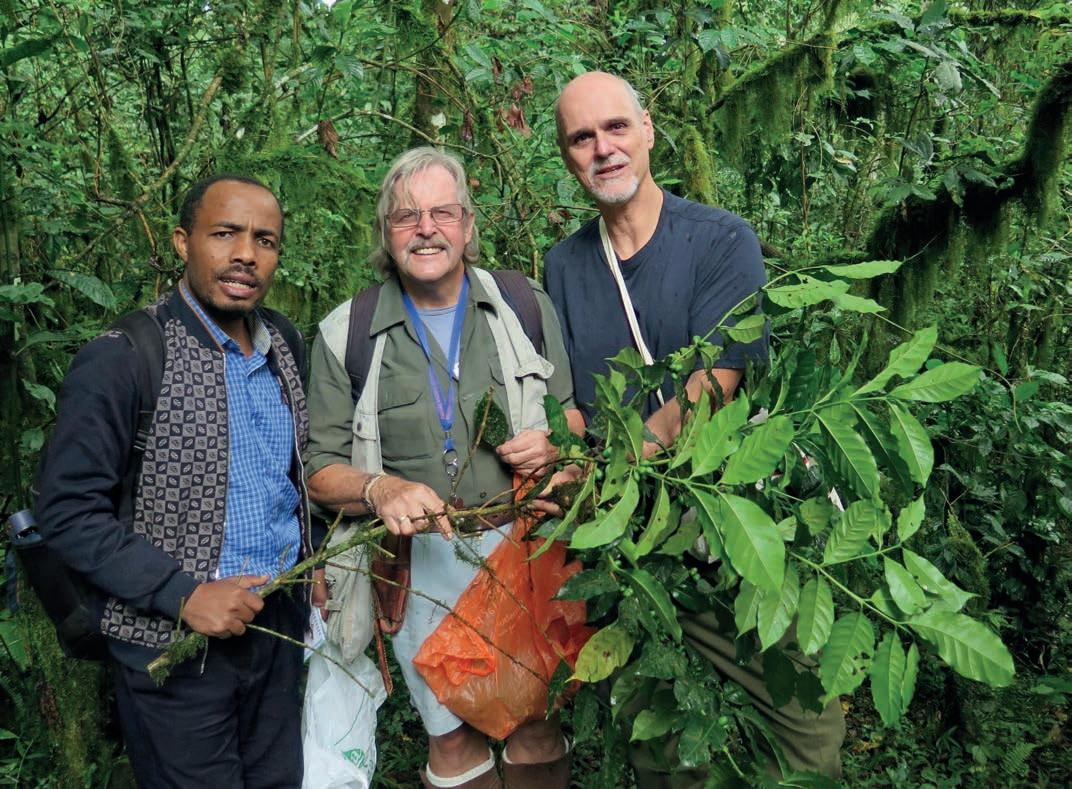





organised by PROMECAFE and took place at their headquarters in Guatemala City, where I presented the suggestion of using classical biological control against CLR. at’s where this research project really began.”
Every organism has natural enemies that help promote balance in nature. e use of these natural enemies to control undesirable and o en invasive species is called biological control. e modern biopesticide approach provides products to control pests in agriculture, but the earlier approach, called classic biological control (CBC), has been in use for more than 100 years.
CBC is applied biology at play and is far from an exact science. One of the most notorious examples of the method’s failure was the introduction of cane toads to control the cane beetle in Australia in the 1930s, which saw the toad quickly
adapt to the environment and become an invasive pest.
Because of incidents such as this strict protocols now surround CBC, but Prof Barreto believes a mistrust of the method remains.

researchers started their search for natural enemies of CLR alongside African research partners. e team journeyed to the wild co ee forests of Ethiopia, Kenya, and Cameroon on the hunt for CLRghting fungi.
His team have hypothesised a natural enemy of CLR may have been “le behind” in Africa as the CLR fungus spread to the rest of the world, and CBC could have a role to play in managing the disease.
“CLR is an exotic pathogen, and the classical biological rule is to nd a coevolved natural enemy from the centre of origin and then collect it, study it, clarify whether it’s reliable and safe to use, and introduce it to the diseased populations to reestablish the equilibrium,” says Prof Barreto.
With initial research funding from World Co ee Research (WCR), in 2015 Prof Barreto and a team of Brazil-based
“It was a fascinating experience. We visited forests where co ee still grows spontaneously – some of the old trees towered above our heads,” says Prof Barreto.
“It was in these forests we found a diversity of things we’d never seen before. e Trichoderma genus of fungi is considered one of the stars in the eld of biological control agents, and in Africa we identi ed and collected 16 di erent Trichoderma species either growing directly on CLR lesions or naturally growing as symbionts inside healthy co ee plants.
“Our conjecture was that these might behave as bodyguards for the co ee plants,


protecting them from CLR as well as other aggressors”
e team also visited parts of South America, particularly areas where co ee occurs spontaneously inside forest fragments and abandoned plantations nature has reclaimed. ey were surprised to nd these searches resulted in complete absence of Trichoderma, the total opposite to the observations in Africa.
“ e discovery of the novel Trichoderma in Africa may explain why Africa has not experienced as aggressive CLR epidemics as other regions,” says Prof Barreto.
From this collection phase of the project, the team assembled a list of about 1500 isolates. An elimination process brought that number down to 600 of the most interesting pathogens and fungi, which were then tested under controlled conditions in the laboratory, and then in greenhouses, to see if they had an impact on CLR. Now, a er ten years of hard work, that list has been whittled down to 10 promising fungal isolates.
“ ere are some very exciting isolates in the nal group. For example, we found that a species of Cordyceps belonging to a group that includes many insect pathogens, is e ective against CLR and greatly reduced the disease in infected plants,” says Prof Barreto.
In controlled tests, several other fungal isolates, including Aspergillus, Calonectria, Clonostachys, Fusarium, and Trichoderma, reduced CLR severity by up to 90 per cent.
The field trial hurdle
e decade-long body of research has now reached the small eld-trial stage, in the hopes the best lab and greenhouse results can be repeated in realworld situations. From here, the research has the potential to be turned into a series of viable products that can be deployed on farms across Brazil and beyond. However, the project has hit a roadblock: it’s run out of funding.
“It is becoming increasingly di cult to obtain funding for research such as this. Traditionally, grants would be acquired from the public sector, but unfortunately the tide has changed,” says Prof Barreto.
“We have found several very promising isolates that we believe can help manage CLR. It is now the time for the industry to step in and fund this research as this is hugely important to the whole co eeproduction chain and a signi cant market for the biocontrol industry as well.”
“This is a vital turning point for the coffee sector. Across major origins, producers face rising pressure to reduce chemical inputs due to increasing environmental concerns.”
Hanna Neuschwander SENIOR ADVISOR, WORLD COFFEE RESEARCH
Hanna Neuschwander, Senior Advisor at WCR, which was involved in the initial stages of the project, believes continuation of the work stands to bene t the entire industry.
“ is is a vital turning point for the co ee sector. Across major origins – from Central and South America to Africa – producers face rising pressure to reduce chemical inputs due to environmental concerns and increasingly strict residue regulations,” she says.
“A cost-e ective, naturally derived solution to CLR ts perfectly into
a broader push for sustainability, especially when combined with existing breeding programs and integrated pest management approaches. ese fungal ‘bodyguards’ could signi cantly reduce reliance on synthetic fungicides, stabilise yields, and preserve the ecological balance on co ee farms.
“ ese products could be a key resource for the industry but bringing them to market requires continued screening of additional isolates, establishing rigorous safety protocols, and making these biocontrol products broadly available to farmers.”
Although he retired last year, Prof Barreto is still very much involved in keeping the project alive.
“It is time for the whole project to be taken over by someone else. e potential of what we’ve found to date is so great that the industry should be interested and inspired to get involved,” he says.
“ is is an urgent issue and decisionmakers need to think outside the box. e concern of the co ee industry with the path towards a sustainable future for co ee needs to be directly linked with action towards the innovation in the natural management of weeds, pests and diseases.
“Without their support, academia can only advance slowly. ese projects take time and won’t provide an instant solution, but what we have found is very exciting and should be continued to be explored. e potential is very clear.” GCR

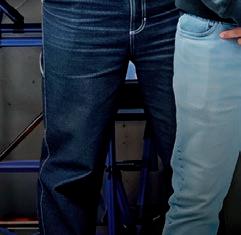
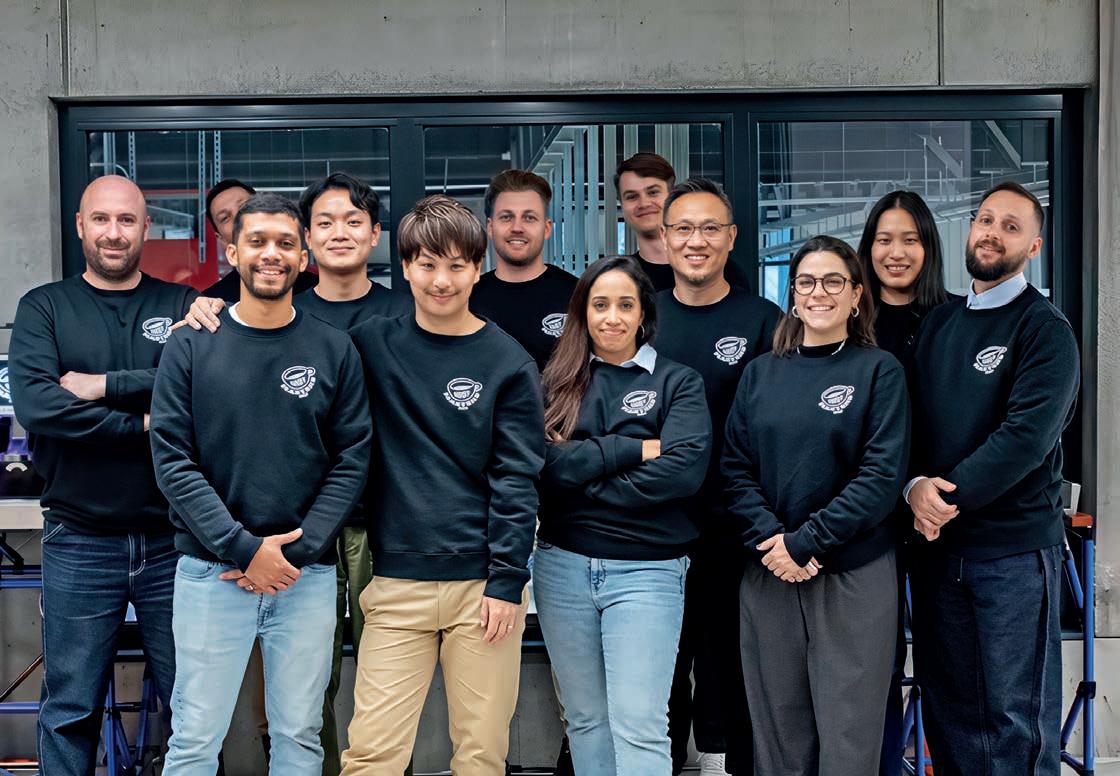

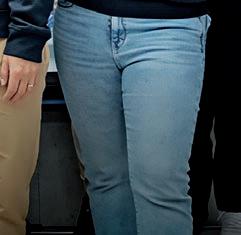





In March 2025, Eversys hosted the inaugural Shotmasters Bootcamp at its Swiss headquarters. Indonesian Barista Champion Yessylia Violin shares her experience and what it means to be a Shotmaster.
S AN INTERNATIONAL brand with its super-automatic espresso machines distributed in more than 100 countries, connection is a key component of what brings Eversys together. Being able to connect with people that use its machines and unique co ee communities all over the world is a central pillar of the brand’s ethos and success.
at’s why connection was the perfect theme for the company’s inaugural Shotmasters Bootcamp.
Hosted at Eversys’ headquarters in Switzerland in March 2025, the rst ever bootcamp saw 12 new Brand Ambassadors – also called Shotmasters – from all corners of the globe descend on Sierre for three days of training, cupping, and creative programming led by Global Ambassador and 2017 World Barista Champion Dale Harris.
Ultimately, the event served as a crash course in how to best use Eversys’ intelligent machinery while sharing ideas, knowledge, and experience with other Shotmasters.
“We’ve had an amazing group of Global Ambassadors for several years, but we
wanted to connect more closely with our regional audiences and people in new markets. Introducing a larger and more varied group of Brand Ambassadors around the world allows us to show up in our communities,” says Miranda Caldwell, Eversys Marketing Director.
“As well as having boots on the ground, our ambassadors help us to understand the
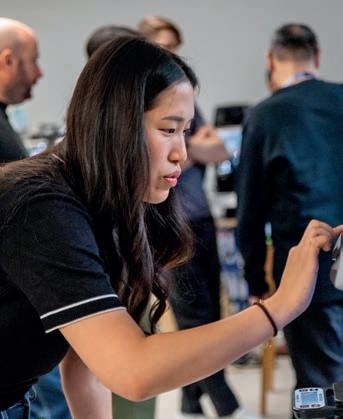

unique needs of their market.”

e brand’s pool of ambassadors now includes hospitality professionals from Australia, France, China, Greece, Indonesia, Japan, South Africa, South Korea, Spain, Switzerland, the United Arab Emirates, and the United Kingdom.
With so many talented individuals dispersed across the international hospitality industry, how does a company go about selecting just 12 to represent an iconic brand like Eversys?
“Funnily enough, it’s largely about feeling. We look at our individual target markets to see what’s going on there and then reach out to some of the key players. We want people who are aligned with Eversys, our products, and our community, but also those who think outside of the box,” says Caldwell.
“We also look for people with di erent perspectives. For example, our Brand Ambassador for France is a restaurant consultant who works with top chefs. He has a di erent perspective and adds diversity to the group, which is also a goal of ours. e co ee industry can be quite young and male dominant, so it
was important to have a range of genders and ages.”
Yessylia Violin, Roastery Manager of Common Grounds Co ee Roastery and 2022 Indonesian Barista Champion, was one of the new faces to take part in the Bootcamp.
“I was excited to be asked to be an Eversys Brand Ambassador. I had worked with the brand previously at a tradeshow in Indonesia and was intrigued by the capabilities of its espresso machines,” says Violin.
“I wanted to see exactly how the machines work, discover what kind of espresso they could create, and question some of the assumptions people have about super-automatic machines. Attending the bootcamp meant, as a group, we could answer these questions and share ideas.”
Drawing on his experience with the machines, especially the Cameo collection, Harris hosted in-depth tutorials on the equipment and how to produce the nest possible cup.
e aim of these tutorials was to help the Shotmasters get to know the machines – inside and out – so they could take the knowledge back home and share it with their local co ee communities.
“We wanted the ambassadors to get to know each other and get comfortable with the machines – kind of like a summer camp experience. We asked everyone to bring co ee, either their own or from their home country, which was a great way to get the conversation owing,” says Caldwell.
“ ere were also discussion sessions in which everyone shared ideas and insights from their markets, which was hugely valuable to us. It was fascinating to learn how we could better serve our co ee communities around the world.”
For Violin, this shared space of connection was one of the highlights of the experience. With some of hospitality’s top minds all in the one place, she says it was important to engage with people of diverse professional backgrounds to share tips and tricks of the trade.
“Most people had a co ee background, but there were a few people who were in sales and others from restaurant and hospitality settings. It’s great to be able to chat to people who know di erent things about and have di erent perspectives on co ee – someone might be really knowledgeable about water whereas someone else might know a lot about processing,” she says.
“Before this experience, I didn’t know how the machine actually worked and how exactly it extracted the coffee. Seeing the factory and ge ing to know the machines in the Shotmaster sessions was really valuable.”
Yessylia Violin
ROASTERY MANAGER, COMMON GROUNDS COFFEE ROASTERY
“It was also interesting hearing about the cultural di erences in each market, as well as the reception of super-automatic equipment like Eversys’ machines.”
e Shotmasters also received a tour of the Eversys factory to watch the machines being manufactured. is tour was vital for developing a deeper understanding of how to use the machines even more e ectively, according to the Barista Champion.
“One of the most surprising things was most of the people working in the factory were women, many of them having previously made watches. e intricacy of their work was fascinating – there are many ne details and small parts to assemble,” says Violin.
“Before this experience, I didn’t know how the machine actually worked from
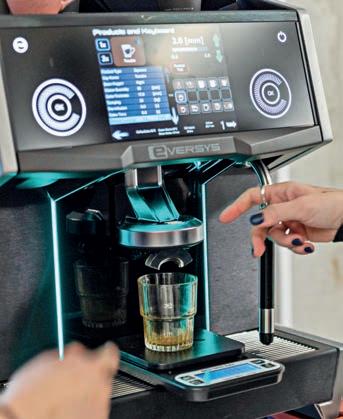

the inside and how exactly it extracted the co ee. Seeing the factory and getting to know the machines in the Shotmaster sessions was really valuable.”
By the end of the three-day experience, the knowledge gained by Violin and the other Shotmasters about Eversys’ super-automatic machines was ready to be taken back home to their local co ee communities.
“I knew it was a high-quality machine, but I didn’t expect it to produce a very beautiful espresso – as good as a traditional machine or even better,” she says.
“One of the biggest operational issues at cafés is consistently producing a great shot. You can dial it in and get it perfect, but you then need to keep on reproducing that standard with di erent people throughout the day.
“With a traditional machine, there are many variables that can prevent that from happening, using a super-automatic machine minimises the chances of them occurring.”
Co ee as an industry is always on the cusp of the next great innovation, whether that be in the creation of new machines, roasting styles, signature drinks, or anything else along the value chain.
According to Violin, there is still some apprehension around investing in the new era of super-automatic machines in Indonesia – but those wheels of innovation are starting to turn.
“Some people are still a bit afraid of the investment in this type of technology as they are o en more expensive than traditional machines. However, I’m already seeing a big change in perspective. Café operators can see the bene ts in terms of consistency and extraction,” she says.
“ ere’s a common misconception that super automatics produce shots with less viscosity than traditional machines, but I discovered at the bootcamp that notion just isn’t true. I’m excited to prove people wrong with Eversys’ machines and introduce more baristas to the potential of this technology.
“Representing a brand and getting people to connect with their products is now much more than giving out cups of co ee at a tradeshow. We want to provide more tailored experiences, like hosting workshops with customers to make sure they’re getting the most out of their equipment.” GCR

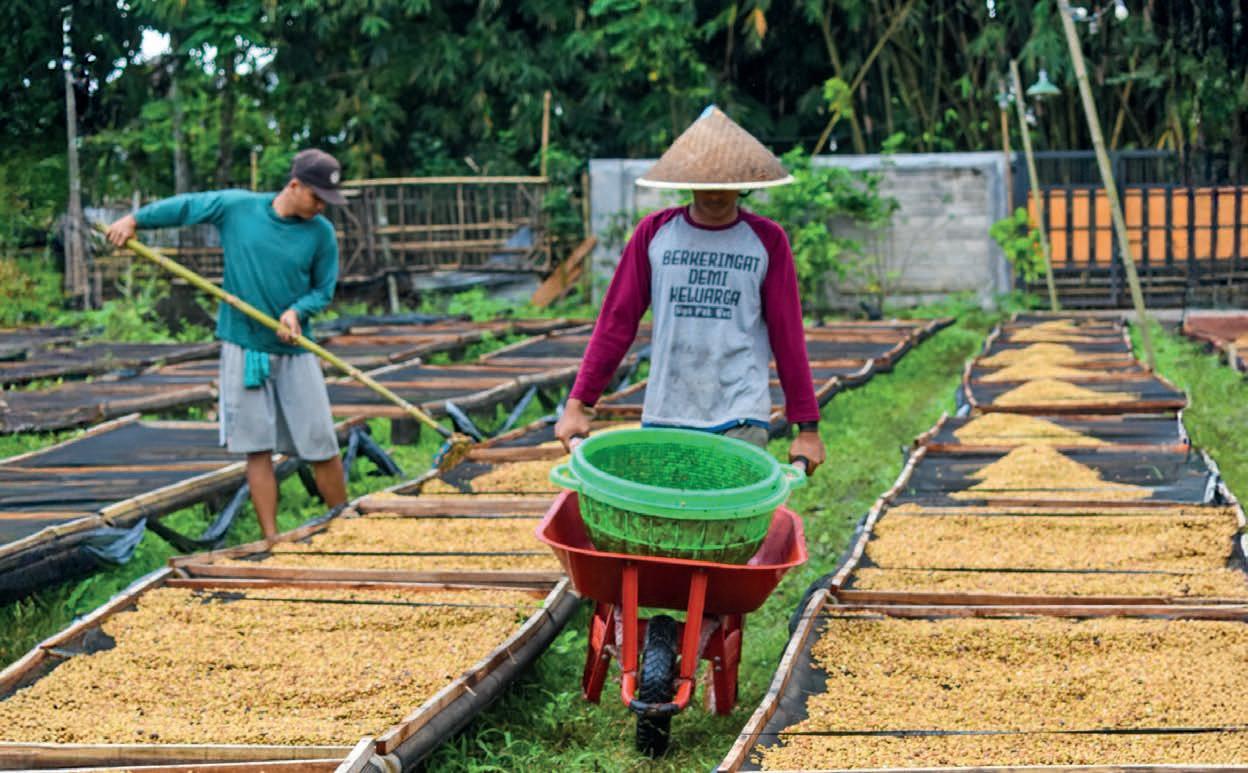

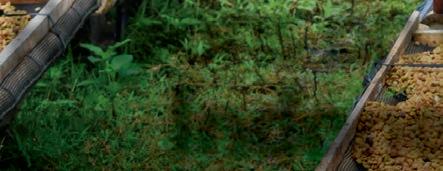
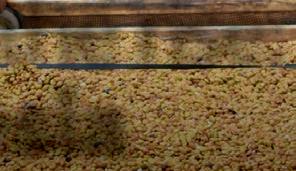
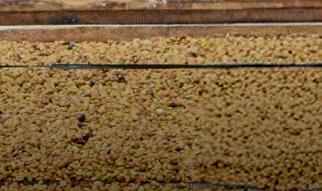
Indonesia is already one of the four largest coffee producers in the world, but could the rise of specialty coffee, a booming consumer culture, and improvement in farming methods prime it for steeper growth?
NDONESIA is already one of the world’s major co ee producers, but if recent comments from the country’s Coordinating Minister for Food A airs Zulki i Hasan are anything to go by, co ee production in the archipelago nation could be set to soar.
During the World of Co ee Asia event in Jakarta in May 2025, Hasan stated his desire to see Indonesia’s co ee production surpass that of its northern neighbour, Vietnam.
Currently the world’s second-largest producer of co ee, Vietnam is enduring a di cult farming year, with drought issues tempering future harvest expectations.
Despite this year’s expected smaller harvest, growth of the Vietnamese co ee farming sector over the past 40 years is an example of how producers – backed by government support, sustainable and
“There is this amazing balance of coffee producing and coffee consuming in an economy that is super dynamic and growing so fast.”
Shae Macnamara FOUNDER, EXPAT. ROASTERS
industrial progress, and quality products – can disrupt the industry and emerge as a new superpower.
With Indonesia’s government likely to
bolster its production sector, alongside an already established industry and untapped farming potential, the question quickly becomes not if Indonesia can increase its global production share, but how?
The perfect storm
Historically, co ee from Indonesia has typically taken the form of commercial Arabica beans grown around the Sumatra region, but that’s changing – and fast. e consumer shi towards specialty co ee is growing in scope around the country, while farmland that previously chopped and changed between crops is starting to take a longer-term view of the potential of co ee.
Outside the traditional growing regions of Sumatra, Java, and Sulawesi, farmlands in areas like Bali and Flores are increasingly

producing high-quality and specialty co ee, according to Expat. Roasters Founder Shae Macnamara.
While the opportunities in the Indonesian co ee value chain are beginning to capture more attention, Macnamara was an early admirer of the archipelago’s potential.
A er founding the business in 2016, Expat now services more than 700 wholesale partners – with plans to grow that to 1000 by the end of 2025 – and operates cafés across Indonesia with new locations, including a rst international site in Malaysia, launching soon.
Macnamara says the marriage between Indonesia’s co ee production potential and interest in its consumer scene have created an environment ripe for development.
“Right now, there is this amazing balance of co ee producing and co ee consuming in an economy that is super dynamic and growing fast,” says Macnamara.
“Mix that with a huge population that has a high percentage of Muslims who can’t drink alcohol and an emerging specialty co ee industry, I think it’s the perfect storm of it all coming together.”
at perfect storm was on display at this year’s World of Co ee Asia.
“I’ve travelled the world and been part of these types of events for a long time, but I’ve never seen the sort of excitement that was at a show like what was just in
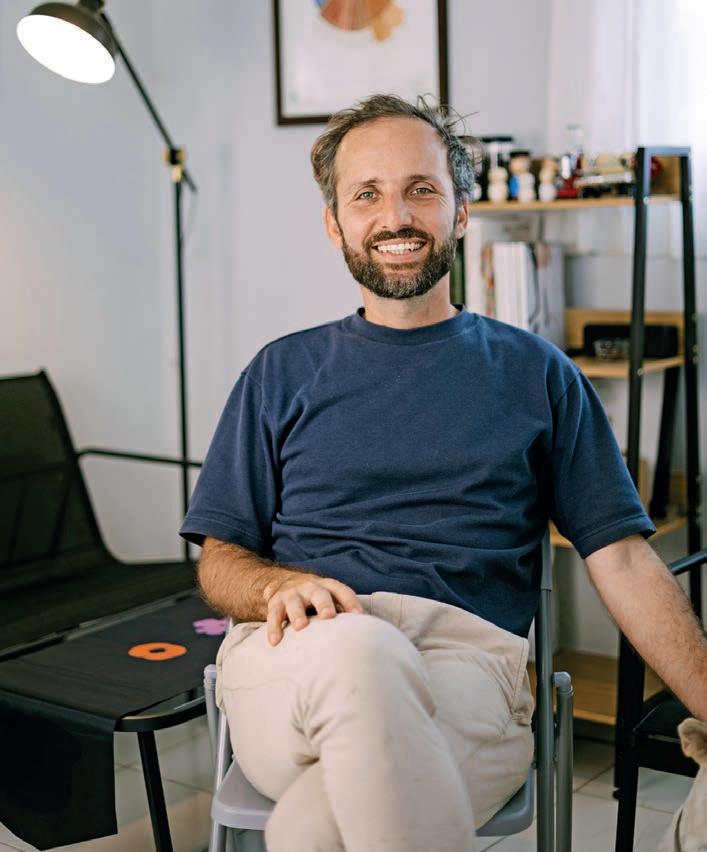



Jakarta,” Macnamara says.
“ e Brewers Cup Final announcement felt like a rock concert. e energy in the room was electric, with the crowd yelling, jumping around, and banging on the chairs. It was incredible.
“I’ve competed, judged, coached, and spectated at these competitions for 25 years, but I have never felt anything like that. It was amazing.”
The task at hand
Tanamera Co ee has been active in Indonesia’s wholesale and specialty co ee markets for more than a decade, and started with a dream of growing Indonesian specialty co ee’s fame in the international landscape.
e team at Tanamera work closely with farmers to improve the quality of co ee and strength of yield coming from both Indonesia’s established and emerging regions. Co-Founder Ian Criddle says the country’s environment means the perhectare yield will struggle to rival some of the other large producers.




Indonesia produced approximately six per cent of the world’s co ee harvest in 2024/25 according to the United States Department of Agriculture, equivalent to 10.9 million 60-kilogram bags. at gure is behind only Colombia (seven per cent), Vietnam (17 per cent), and Brazil (38 per cent).
Due to its sprawling chain of islands, the country spans more than 1.9 million square kilometres, with not even a quarter of that being land. On that land, volcanoes and mountains extend up to the clouds, and thick, heavy forest covers the regional territories.
“Our lowest yield of plantations is probably Flores, which is around 300 kilograms of green beans per hectare,” says Criddle. “ e highest is up in Sumatra, which is circa 1200 kilograms per hectare.
“If you look at Brazil as a country, the national average is 2500 kilograms per hectare. Because all our co ee plantations are grown on the slopes of the volcanoes, it’s like a jungle – it’s up and down. Brazil is, generally, more like a at vineyard at lower altitudes.”
Per-hectare yield is far from the only
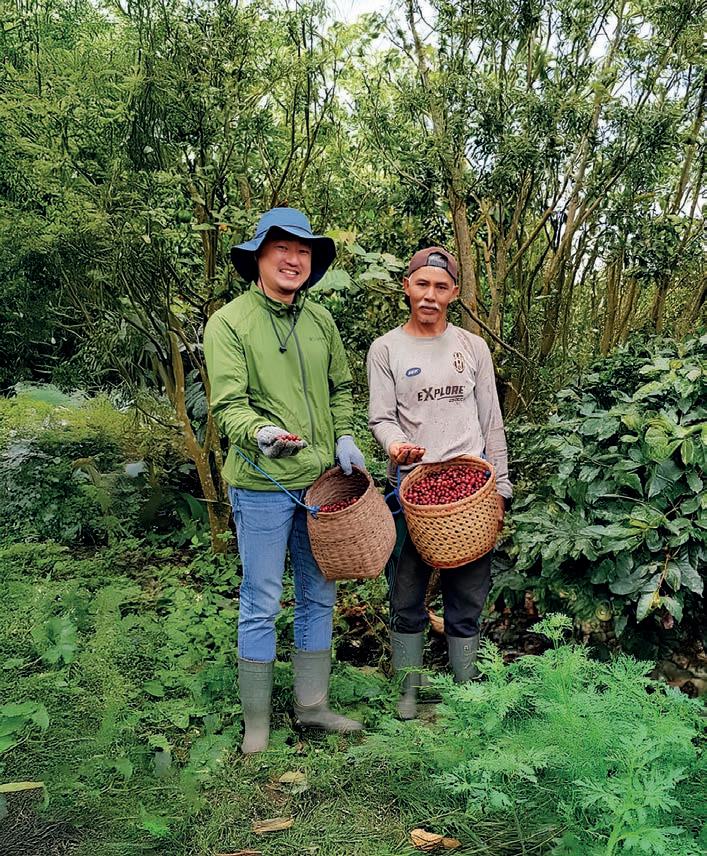




method to ascertain growth in co ee production, though.
Koro Roasters is a relatively new player in the Indonesian scene e name draws inspiration from the Italian word ‘coro’, meaning ‘choir’ or ‘collaboration’, while also creating a connection to co ee roasting –‘kopi’ being the Indonesian word for co ee.
Founder Alain Scialoja is a former robotics engineer who has found his calling in co ee. He says Indonesia is already, in part, achieving that lo y goal set by Minister Hasan.
“Indonesia actually surpasses Vietnam in several important metrics already, it has more land dedicated to co ee production, it produces more Arabica co ee, and it has a much stronger domestic market,” says Scialoja.
“Where Vietnam leads signi cantly is total production volume. at di erence primarily comes from Vietnam’s Robusta sector, which it has developed through a
highly centralised, export-focused approach with intensive farming methods.”
Scialoja believes Indonesia won’t be able to match Vietnam’s co ee sector in terms of pure yield, but sustainable growth in production will continue to help the nation boost its co ee standings internationally.
“I believe Indonesia can certainly grow its production sustainably, perhaps by 50 per cent or more over the next decade, but rather than focusing solely on outproducing Vietnam in volume, I see more value in becoming the leader in sustainable, highquality, traceable co ee that commands premium prices,” he says.
“Indonesia could overtake Vietnam in value terms by focusing on its competitive advantages: incredible diversity of origins, unique processing methods, and rich cultural heritage. What’s more, this approach would more greatly bene t smallholder farmers than a pure volume play.”
With co ee so susceptible to climate change, and markets around the world feeling the impacts of droughts, oods, and rising temperatures, fostering a more sustainable industry is paramount to not only co ee’s continued progress but also its survival.
is desire to improve sustainability trickles through the entire supply chain, with roasters like Expat, Koro, and Tanamera all playing their own roles in promoting sustainable practices.
Over the past decade, Tanamera has placed massive importance on its relationships with farmers across Indonesia and seeks to help them implement modern and sustainable practices.
John Lee, Director of Tanamera Co ee, oversees the business’ quality control and bean sourcing, which sees him travel between smallholder farms around the country to help improve farming practices.
“I spend a lot of time in our farming areas from Sumatra to Flores to maintain good relationships with our farmers. Even if it’s small, we always want to keep investing in our farming areas, work with farmers, and invest in machinery and education,” says Lee.
“At Tanamera we’re crop to cup, from the very beginning on the farm to the very end serving your cup of co ee. We have the customer interface, we have the experience with what people want internationally, and what people want in Indonesia for specialty grade co ee. ere are apparently two million co ee farmers across Indonesia, and we can communicate all of our customer feedback with them.
“Some of them have small holdings, and some are essential processing. We help them improve their yields and the quality of the plantations to get the gains in the co ee quality.”
Criddle says the best approach to introducing new sustainable practices is to make them tangible to the farmer.
“It’s all interlinked,” he says. “John spends a lot of time with the farmers and repeats things over and over again so we can start to see tangible results. Every year, if you’re getting someone to change they have to be able to see that change.
“It’s doing things out of harvest, like pruning and weeding around trees and fertilising to get the yields up – that’s tangible to the farmer and they can see the di erence it makes.”
Koro, on the other hand, makes a point of seeking out producers already
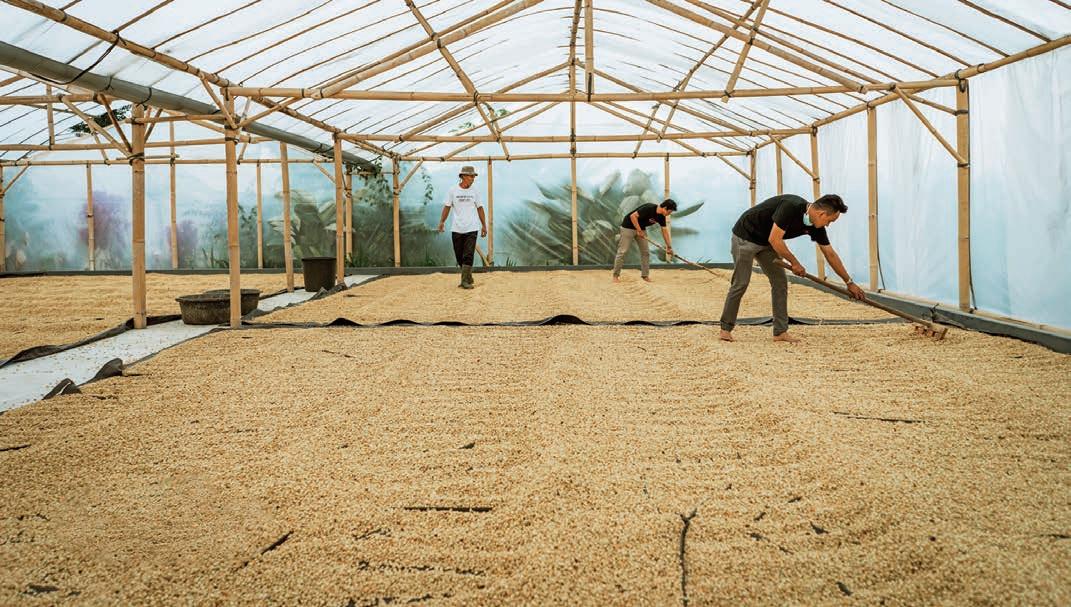


implementing sustainable practices.
Scialoja says the most e ective frameworks recognise what farmers are already doing right.
“Indonesia has a unique opportunity to lead in the sustainability space because so many of its co ee farms are already inherently sustainable,” he says.
“ ey’re small-scale, diverse, and o en organic by default. e challenge is documenting these practices in ways global markets recognise without imposing excessive burdens on farmers.
“By building on Indonesia’s existing sustainable farming traditions while selectively adopting appropriate technologies, we can create a model that balances productivity, sustainability, and farmer livelihoods.”
The coffee connection
e Indonesian co ee scene, regardless of whether it reaches Minister Hasan’s aspirations, is still primed to continue its upward trend for both producer and consumer.
Its uniquely fanatical co ee culture is only growing – borne out of a connection that threads its way from farmer to cup.
“One of the things that attracted me to do something here was the fact the baristas and the people who are serving co ee have got an attachment to the co ee itself,” says Macnamara. “It’s their communities that are growing co ee.
“When I rst started here, I would ask someone the type of co ee they used and
“Indonesia has a unique opportunity to lead in the sustainability space because so many of its coffee farms are already inherently sustainable.”
Alain Scialoja FOUNDER, KORO ROASTERS
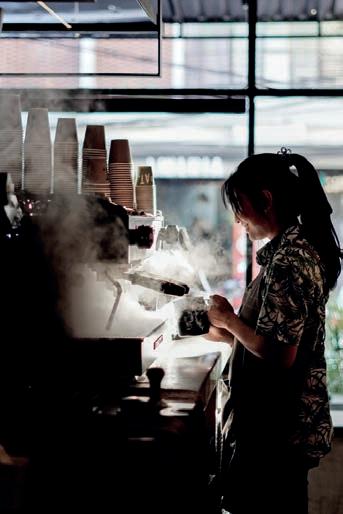

they would say usually say Arabica, but they would then say it’s from Sumatra and go on to call out the regions in those areas it was grown.
“Coming from Australia, they would say it’s Campos, Toby’s Estate, ST. ALi, or Grinders. In Australia, the roaster would give the education around the beans. Cafés are not partnered with the farmer, they’re partnered with the roaster.
“In Indonesia, there’s an incredible connection to origin that most places around the world don’t have, and I think that’s because of the proximities to the farming regions and the understanding people have of the farming.”
Macnamara says the opportunities in the industry are tangible, and it’s only a matter of time before the rest of the world catches on to Indonesia’s burgeoning co ee sector.
“ ere’s a xed potential to what is happening here. With co ee prices being higher, more people are holding co ee at the moment and not switching to other crops, and that’s exciting. We’re hoping that education around holding co ee crops for longer is going to start impacting the producing areas even more,” he says.
“ e advancements in co ee farming that are processing new varietals, all within a consuming and growing economy, it’s a great situation to be in.
“We want to keep Indonesian co ee in Indonesia, but I think you’ll soon be seeing it on many more menus all around the world.” GCR
By 2030, the coffee sector in the Middle East and Africa (MEA) is expected to reach a projected revenue of US$38.3 billion. Image: Chaudhary Umair/stock.adobe.com.








With a new showroom in Saudi Arabia and an office in Dubai due to open in late 2025, SEB Professional explores the unrelenting rise of the Middle Eastern coffee market.
HE GATHERING of people to enjoy a cup of freshly brewed co ee has been a part of Middle Eastern culture for centuries. In the 1400s, Yemini mystics believed drinking co ee induced spiritual intoxication, while during the Ottoman Empire co ee houses were social hubs where debates took place and business deals were struck.
While co ee culture has long been ingrained in the region’s rich cultural fabric, over the past few years the Middle Eastern co ee market has seen dramatic growth – with more predicted over the next halfdecade. According to the latest statistics from Horizon Grand View Research, by 2030 the co ee sector in the Middle East and Africa (MEA) is expected to reach a projected revenue of US$38.3 billion, with a compound annual growth rate of 4.6 per cent from 2024.
Claudio Maschietto, Vice President APAC/MEA/Russia at SEB Professional, says while the whole region is one of the fastest growing markets in the world, Saudi Arabia is of particular signi cance.
“Not only does the country have a rich co ee culture, but its strategic location also makes it an excellent hub for co ee trade within the MEA,” says Maschietto.
“ ese factors, combined with growing demand for specialty co ee, high levels of investment in the sector, and government initiatives to promote local co ee cultivation, are making Saudi Arabia a key player in the global co ee market.”
As part of the Government’s Vision 2030 program, the country aims to boost tourism by attracting visitors with authentic Saudi co ee experiences and related activities. It’s also supporting the local co ee cultivation sector, with the Ministry of Environment, Water and Agriculture launching a series of programs to enhance the production, manufacturing, and marketing of Arabica co ee.
As such, in 2024 the Saudi Sip of Excellence Competition was established through a partnership between Saudi Co ee Company and the Alliance for Co ee Excellence. e opening ceremony of the second edition in 2025 was attended by His Royal Highness Prince Muhammad bin Abdulaziz bin Muhammad bin Abdulaziz, Deputy Governor of the Jazan Region.
“ e growth of the co ee industry is supporting local farmers and encouraging sustainable farming practices, especially in regions such as Jazan, which are renowned
for co ee cultivation,” says Maschietto.
In response to the growth of the local market and the demand for intelligent automated technology, SEB Professional has teamed up with the local distribution partner Co ee Culture, which will open a dedicated showroom in Jeddah. e new hub is due to open in late 2025 and aims to establish the brand as a centre of innovation for catering and co ee in Saudi Arabia.
“ e idea is to get closer to our customers and support them with solutions that help them run their businesses. Co ee Culture’s showroom in Jeddah will be an important part of this, providing a space where we can engage with our customers and showcase our product o ering,” says Abdul Karim Turki, CEO of Co ee Culture.
“ e premises can also be used for training and development purposes. In this way, we also aim to help raise standards in the industry in the long term.”
e team’s focus will be on supplying o ces and hotels with its fully automatic machines from house brands including Schaerer, Curtis, La San Marco, and Zummo, as well as introducing its WMF espresso NEXT by WMF Professional to specialty venues. e award-winning semi-automatic machine was designed to
combine the world of traditional porta lters with the advantages of automation.
“With the WMF espresso NEXT, SEB Professional has a semi-automatic porta lter machine in its portfolio that combines all the bene ts, including the design, look, and feel of a traditional porta lter machine, with the undeniable advantages of a modern fully automatic co ee machine,” says Karim Turki.
“Its inner workings ensure all timeconsuming and error-prone tasks – such as grinding and tamping the beans or frothing the milk – can be carried out automatically if required.”
As well as opening the new Jeddah facility, SEB Professional will also establish a new o ce in Dubai, United Arab Emirates.
“ e regional o ce will capitalise on Dubai’s status as a hub for regional headquarters, signi cantly improving our proximity to customers. Locally, our team will provide excellent service, drive technical support, and continue to grow our business,” says Niccolo Rossi, Business Development Manager MEA & CIS at SEB Professional.
“A new o ce in Dubai completes SEB Professional’s presence in the region and takes our market development to a new level.”
Across Saudi Arabia, Dubai, and the wider MEA region, the increasing interest in both the growth and consumption of co ee has resulted in a boom of cafés and co ee-serving venues, which have become
a lucrative business venture in the region. As part of this, the specialty sector is seeing substantial growth, especially among younger generations.
“Appreciation of high-quality specialty co ees continues to grow. Cra co ee shops and artisanal roasters are becoming increasingly popular, o ering a wide range of single-origin beans and bespoke blends, with cold beverages also gaining in popularity,” says Maschietto.
“Along with quality and taste, customisation is key. Guests want to personalise their co ee drink, whether through di erent types of milk and milk alternatives, signature avours, or artisan preparation methods. For Generation Z in particular, there’s a desire for innovative and exciting co ee o erings that go beyond the classic cappuccino – creative recipes, new technologies, and fresh store concepts make all the di erence.
“ at said, price remains an important consideration. In general, consumers expect a ordability and value without compromising on quality and enjoyment.”
Alongside the trends for chilled and customisable drinks is a demand for e ciency and convenience. According to Maschietto, this has cultured a preference among co ee shop and hospitality venue owners for automated equipment.
“ e trend is clearly towards automation. Co ee chains in particular, but also hotels and o ces, are looking for solutions that
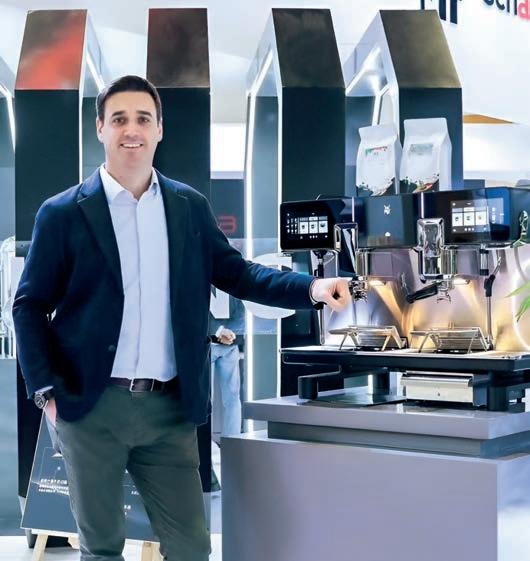
allow them to streamline their processes and increase their productivity,” he says.
“At the same time, the ability to be as exible as possible in the preparation of co ee also plays an important role.”
At the new centre, customers will be able to experience SEB Professional’s automatic products rsthand and choose the right solution for their business. e team also hope the training sessions hosted at the space will build customer loyalty and facilitate the progression of the co ee skillset in the city.
“ e showroom will house its own Co ee Academy, providing a live, dynamic, and interactive experience for our attendees,” Rossi says.
“Jeddah is the leading city for gastronomy and co ee in Saudi Arabia and sets trends for the entire market. e city is an import hub for co ee from Ethiopia, Colombia, Brazil, and numerous other co eegrowing countries, o ering a wide range of international and local cafés and promoting its already rich specialty co ee culture with innovative concepts.
“ e entire MEA region is one of the fastest growing co ee markets in the world, as per capita co ee consumption continues to rise. e new sites in Saudi Arabia and Dubai are crucial for SEB Professional to be a key player in the region.” GCR
For more information, visit groupeseb.com/en/professional
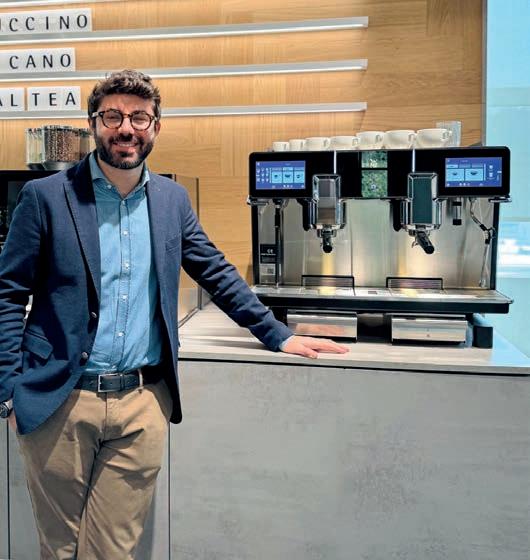
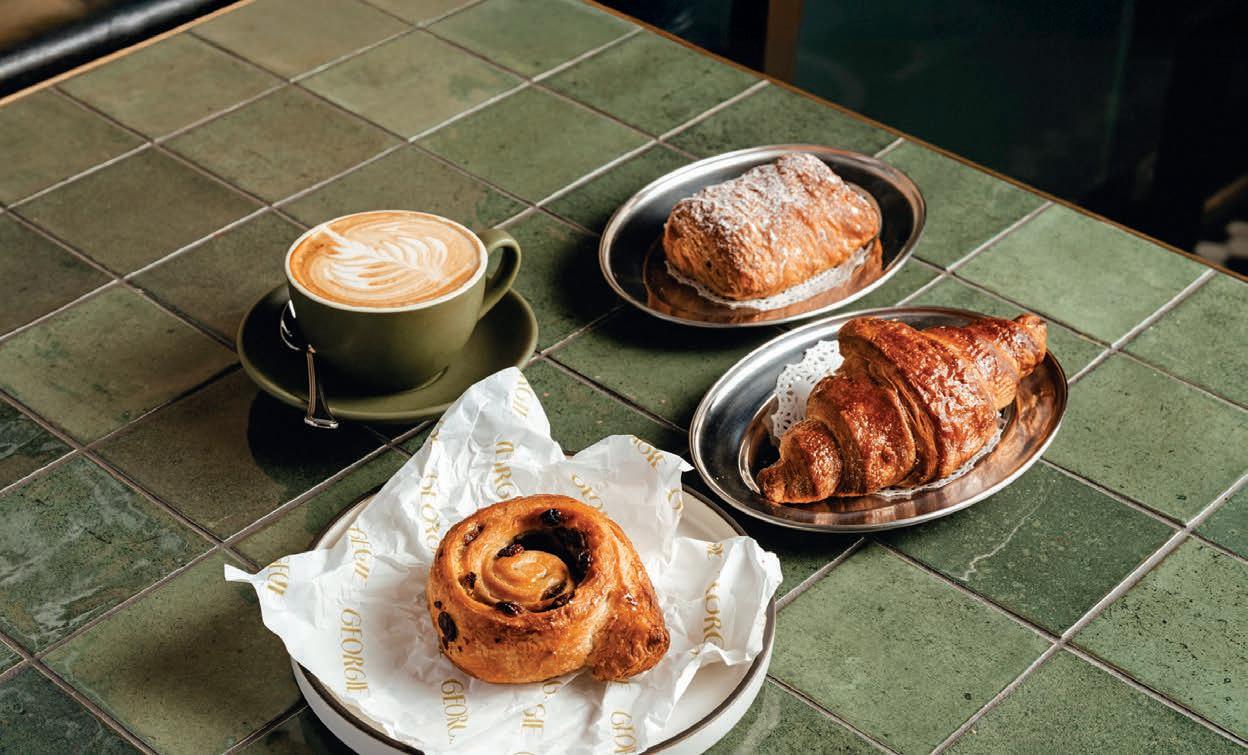



















STARTING THE DAY with a cup of co ee is a morning ritual for billions of people globally. Yet, until fairly recently, it seems few hotels paid much attention to the beans served to their guests, despite about 11 million people waking up in hotels each morning.
Most guests were happy to make an instant co ee at the beverage station in their rooms or use the capsule machine at the breakfast bu et. e few co ee a cionados who were particular about their morning cup became accustomed to searching for their x elsewhere.
However, over the past decade, consumers have become far more discerning about the co ee they drink. e specialty movement has raised standards across the board and many co ee drinkers now expect to nd a quality experience in all manner of settings, especially hospitality venues such as hotels and restaurants.
It’s a trend that’s been observed and acted on by many major players in the



Quality coffee is no longer limited to café se ings. GCR explores how the hotel sector is switching on to the power of a premium cup.
”For us as hotels, if we can provide a great cup of coffee the traveller can feel confident they can get their day started right and feel good.“
Adrian Williams COO, ACCOR PACIFIC
hotel sector, including Accor, one of the largest hospitality groups in the world with more than 5000 hotels and resorts in 110 countries. Adrian Williams, COO of Accor Paci c, says there’s been a noticeable shi in consumer expectations around food and beverage, including co ee.
“When I rst started in the industry,


co ee wasn’t really thought about and therefore not a lot of e ort was put into it.
ere was a lot of bulk brew co ee and the quality was average, but that’s what people expected. However, consumer demand has seen the approach to co ee from hotels shi ,” says Williams.
“Being from Australia, my interest in co ee has become a bit of an obsession, so for years when travelling I would bring my own setup – beans, a hand grinder, and an AeroPress – especially when overseas. I wanted to know I’d always be able to get a good co ee wherever I was. Like me, many consumers have become increasingly interested in the quality of the co ee they’re drinking. As a company, we no longer have the luxury of not thinking about our o ering.”
e shi has been a gradual evolution over the past decade, according to Williams, with hotel groups like Accor taking note of consumers’ expectations.
“We have to think about co ee because our

customers want us to. ere’s a fear of going to a new city and not knowing where to get a good co ee, and if they’re unsatis ed that has a real impact on their whole experience of staying with us,” he says.
“For us as hotels, if we can provide a great cup of co ee the traveller can feel con dent they can get their day started right and feel good. Being able to o er a reliable, quality experience now has a weighting on hotel preference.”
Accor has more than 20 brands in the Paci c, ranging from economy hotels such as ibis to premium and luxury venues such as Pullman and So tel. Of the group’s 440 venues in the region, the Food & Beverage department provides a range of co ee experiences, from in-bedroom beveragemaking facilities to artisan co ee shops and ne-dining restaurants. Over the past few years, Williams’ team have invested in providing an elevated co ee experience for all guests in all its venues.
“We’re increasingly putting more into training our teams, providing better quality equipment, and securing better quality co ee partnerships so we can provide an amazing co ee experience wherever our guests travel,” he says.
“We serve 30 million cups of co ee in the region each year – that’s a lot of opportunities to get it wrong if we don’t pay attention. erefore, our teams are as focused on and as passionate about co ee as I am. We have 30 million opportunities each year to make an impact on a customer that will re ect their travel experience with us.”
Accor recently entered a new partnership with JDE Peet’s to supply its hotels across the Paci c with a range of co ee experiences. e global co ee company’s local brands include Campos, Hummingbird, Piazza D’Oro, and L’Or –each paired with Accor’s hotel brands to o er a tailored co ee experience.
“Regardless of the hotel they’re staying in, customers see co ee as an everyday luxury. It doesn’t matter if they’re staying at an ibis or a Pullman, they still deserve to have a great cup of co ee,” says Williams.
“We don’t have the same facilities across all our hotels, but we still have an obligation to provide barista co ee cra ed by someone who’s well trained. In our premium hotels, we typically o er specialty-grade co ee in a café environment, whereas in a conferencing setting our focus is on large scale and quick service.”
Whereas previously it was rare to nd an espresso-based option in some hospitality
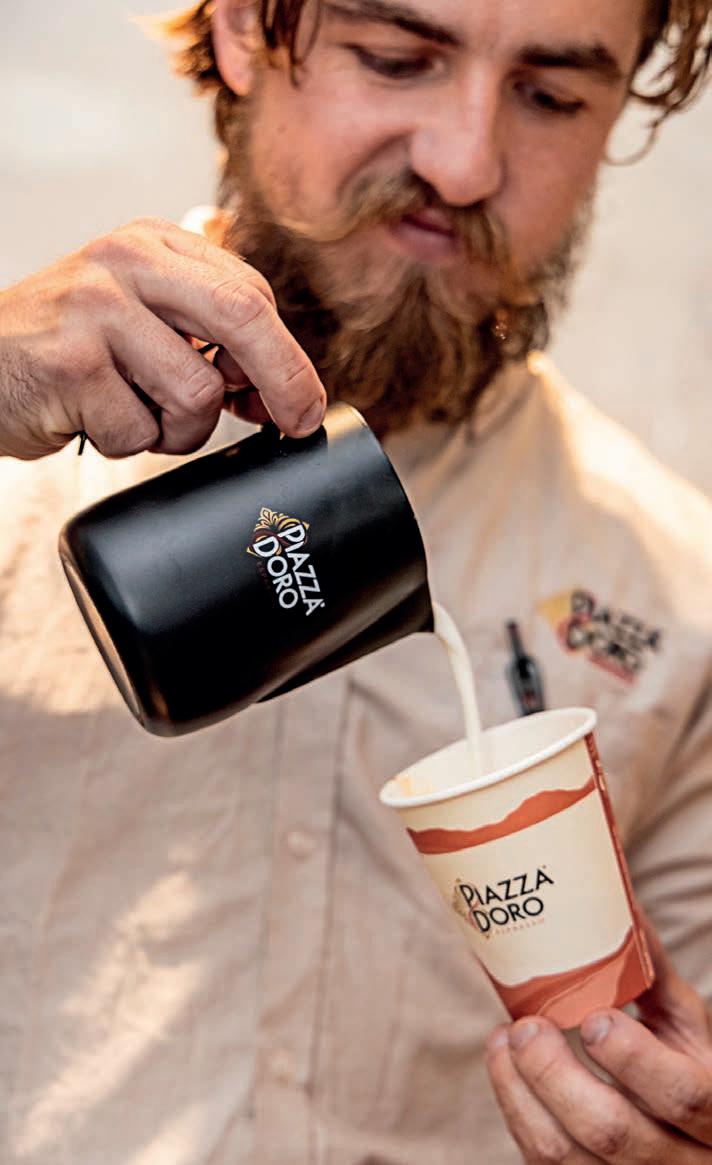
settings, pourover and batch brew o erings are now available alongside espresso in some hotel cafés and restaurants. At Swissôtel in Sydney, a specialty café is adjoined to the hotel as an independent venue that can be enjoyed by both guests and the public.
“You wouldn’t know the café is run by the hotel as it mainly serves the general public, but that experience is also available to our overnight guests. It’s inspired by the Sydney specialty co ee experience and serves an excellent batch brew from local roaster Single O – probably one of my favourites
in the city,” says Williams.
“ is ties into the shi ing role of hotels in general – they are no longer just places to sleep. We are seeing people using the restaurants, cafés, and communal spaces in our hotels as less formal meeting places and we’re actively encouraging people to use them as a community space. Co ee is very much an important part of that interaction.”
While co ee has become an essential element of Accor’s food and beverage strategy, Williams admits the objective of this focus isn’t driven by revenue.
“It’s not so much that co ee is a revenue

source but instead a means to creating an experience. Yes, we get great revenue from co ee, but we also want to create a more social environment and co ee is a vital part of that.”
Finding a new co ee roaster to work with was no easy feat for the Accor team. With a variety of venues in their stable, they needed a partner that could provide a range of styles and blends to service its di erent hotels. ey also sought a company that shared its focus on sustainability.
“ is is a big part of our global purpose: pioneering the art of responsible hospitality and connecting cultures with heartfelt care. When we talk about pioneering, that extends to creating amazing co ee experiences and pushing the boundaries, but doing so in a responsible way,”
Williams says.
“When choosing a co ee partner, they had to share this vision. JDE Peet’s sustainability program and approach to sourcing demonstrates their commitment.”
A perfect match?
Accor is far from the only large-scale hotel group placing greater emphasis on providing a quality co ee experience for its guests. Hilton, with its own range and scale of hotel brands, is doing the same. e Australian owned and inspired United States (US) co ee roastery Bluestone Lane provides co ee for one of its newest brands, Tempo by Hilton, targeted at midtier health- and lifestyle-conscious guests.
With Bluestone providing beans for Tempo’s four existing sites, and with eight more under construction and up to 60 more in the pipeline, there has been a clear intention from Hilton to o er quality co ee to its Tempo customers from the very inception of the brand’s existence.
Brand Leader of Tempo by Hilton Kevin Morgan says the ability to provide quality co ee to customers has been a key part of ascertaining where Tempo ts into the hotel landscape.
“Hilton has 24 brands and a focus on building brands organically. To do that we wrap the brands around what we call a design target,” says Morgan.
“In Tempo’s instance, our brand targets a guest muse named ‘Mark and Maya’. We know speci c attributes around these individuals, and then we report back and gure out how to build it out.

“Each brand is built in a di erent traveller segments all with di erent needs. If you stay at a Hampton you want consistency from every location. As you go up the
brand stack, those needs change, and you start to see more bespoke o erings. Tempo sits right in the middle of that stack.
“Where Hilton has put Tempo, it targets a traveller that, when they’re at home, is typically healthy, however, when on the road their routine is disrupted . We want customers to walk through the door to see brands that are re ective of what they are, and one of those is Bluestone Lane.”
Morgan says research conducted by Hilton has found an overwhelming desire for guests to start their day with some kind of co ee or ca einated beverage, and it’s up to the hotels and brands themselves to distinguish which type of co ee should be supplied and which sites meet guest expectations.
“If you look at co ee as a whole, about 76 per cent of people start their morning routine with a co ee. How they want their co ee is di erent at a Hampton versus a Tempo versus a Waldorf, but we still found 92 per cent of people want some kind of co ee, tea, or hydration,” he says.
“Tempo was built around the lifestyle traveller who wants the things they have at home, things like a plant-forward menu, great co ee, and access to a well-equipped gym. at’s where the importance of co ee plays into this brand.”
Bluestone Lane currently operates more than 55 stores around the US. From downtown Los Angeles to New York and Washington D.C, the roastery and café chain holds a national presence across its retail and wholesale commercial operations.
Since introducing the brand to market in 2013, Founder Nick Stone says he has aimed to provide stellar consistency through Bluestone’s products.
“ e way we’ve engineered our co ee program is very, very portable,” says Stone.
“We’re very structured in how we make our co ee. You could be the best brewer in the world, but if you work at Bluestone you will make it our way – not because we’re obnoxious but because we’ve designed it to be so consistent.
“Bluestone is very much built around being a lifestyle brand. at alignment has led to a great understanding of the Tempo brand and the compatibility of the two companies.”
Morgan believes the desire to create high-level consistency in its product lends well to Bluestone’s model and supplying the hotel market.
“Hilton is a brand-led company, and when you look at what goes into protecting the brand, quality assurance and standards
”[In hotels] you’re introducing your product to hundreds, if not thousands, of people that may have never tried it .“
Nick Stone FOUNDER, BLUE STONE LANE
make sure there is a rigorous process that sits behind the processes and teams behind it,” he says.
“When we look at our partnership with Bluestone, it also means we must deploy resources to support Bluestone, whether that’s the right recipe card templates, or ensuring our team members are able to execute when they’re standing in front of the ingredients and the co ee machine.
“When you talk about scale, you want to make processes that are e cient and repetitive in nature. Bluestone’s process lends itself to allowing the co ee to be made the same way every time to ensure there is consistency in the cup.”
Where Hilton and Tempo are bene ting from Bluestone’s desire to create consistency in its product, the roastery has also seen gains from the hotel chain’s introduction into new markets.
One of the major advantages of this existing collaboration, according to Stone, is the ability to assess its products in new
environments with a captive audience.
“It’s a valuable way to drive trial and to understand the portability of your brand. If you are presented within a hotel in a new market and your product resonates well, it gives you a leading indicator on whether your retail proposition will be accepted by your target customers there,” he says.
“You’re introducing your product to hundreds, if not thousands, of people that may never have tried it. It’s extraordinary to think about the amount of e ort and investment it would take to conduct a trial of that scale.”
Stone says Bluestone’s growing presence in Nashville, Tennessee, is the perfect example of how a co ee roaster introducing its product into a hotel environment can strongly bene t both parties.
“We had reasonable conviction that Nashville could be a great market for Bluestone Lane, but we received insightful data and validation about the consumer and where they were coming from through our partnership with Tempo,” he says.
“Are the locals captive in the hotel? What percentage of tra c is coming to the café externally? What are they ordering? Do they like co ee? Do they like matcha? How popular are iced lattes?
“Firstly, our partnership with Tempo acts as a huge catalyst to drive trial, grow brand awareness, and to reach existing customers in new markets. Second, you get to enjoy the commercial bene ts of selling your wholesale beans and other proprietary products. irdly, it provides valuable market insights that can help scale your company’s licensed or retail strategy.” GCR



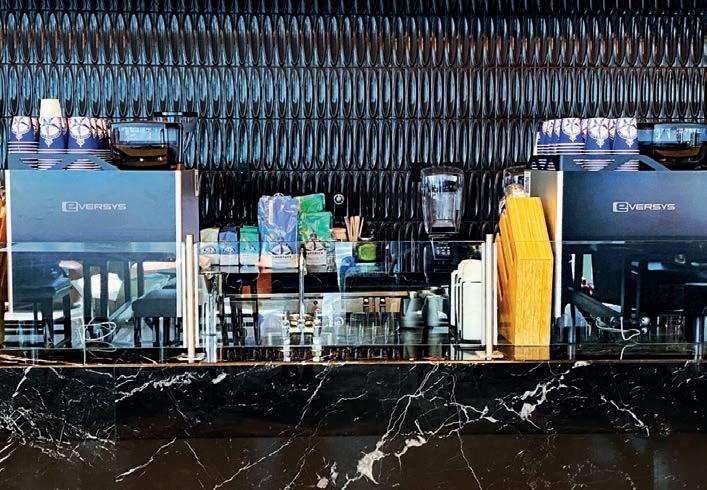








Great coffee should be accessible to everyone, and Schaerer is embarking on a change that will help more people use its Coffee Soul machines.
IN THE PURSUIT of creating a world t for all who inhabit it, it can be the simplest of acts that foster the greatest sense of independence.
For some people, this independence can be achieved through things many take for granted, such as having a job or driving a car. But, for others, it can be as simple as getting your own cup of co ee.
e rise of automatic co ee machines has made quality co ee more accessible than ever. From o ces, hospitals, and convenience stores to universities, mechanics, and car dealerships, good co ee has become a service expectation around the world.
Yet, this growing accessibility to highquality co ee is not necessarily available for all, even if there is a machine to use. With menus and controls o en located towards the top of machines on high benches, independent access for wheelchair users is o en di cult – if not impossible.
Schaerer has been at the forefront of co ee machine innovation for more than 100 years, and the manufacturer is now seeking to improve the accessibility of its Co ee Soul machines with a new Easy Access module that will be available worldwide in late 2025.
e new system features a series of buttons at the front of the machine’s drip tray, rather than at the top. ese additional buttons can be used to select beverages from the existing menu, meaning wheelchair users will be able to easily select their own drink independently, when and where they want it.
Schaerer has already released a comparable model to the upcoming Easy Access in the United States (US) to great success. Global Product Manager Xiaoya Tan is responsible for the creation of the new module.
She says the upcoming international release of the feature ties into Schaerer’s desire to use small things to create big change.
“As far as I know, there are no other similar features on the market. is feature is not new for the Schaerer Co ee Soul as we launched the US integrated model in 2023, but now we are making it available globally,” says Tan.
“It is important for us to foster a society that everyone can participate in on an equal basis. We see that as a critical part of our social responsibility. is includes improving accessibility for wheelchair users to help them navigate the world
as accessibly as someone who does not use a wheelchair, and that includes being able to start the day with a cup of co ee, independently.”
She adds accessibility improvements in other areas of society have helped motivate Schaerer to create this change within its products.
“We see train stations as a great example of large-scale changes in creating a more accessible environment for wheelchair users, and we want to create a similar solution with our machines,” she says.
“Clearly this is not a feature that will double our business results, but that isn’t our only target. We want to create social change.”
Tan describes the functionality of the Easy Access module as comparable to a set of arrows on a computer keyboard. It includes le and right buttons to navigate the beverage selection menu, a button to activate the machine once the beverage has been selected, and a cancel button.
It is designed to be used on machines that are set to self-service mode, as opposed to sta mode, or frequent user mode.
e new module can be retro tted to a range of Schaerer Co ee Soul machines that feature touchless outlets and, once
released, will be able to be included in new machine purchases.
e inclusion of the automatically adjustable touchless outlet is an important safety feature according to Tan, who says the Easy Access system can be simply installed on existing machines by a Schaerer technician.
“ is feature is easily retro ttable, and we recommend the machine already has the touchless outlet,” says Tan.
“ e touchless outlet is also retro ttable, so it is incredibly simple to have both features tted to your existing machine. It ensures there is no splash risk to the user, because if the outlet is quite high and dispensing into a small cup, that becomes a risk to consider.
“ e technician needs no more than 30 minutes to install Easy Access to an existing machine.”
Although the applications for the Easy Access feature range as far and wide as wherever self-service Schaerer machines are in use, there are three key sectors in which this technology could be a potential game changer.
Its application in medical facilities including hospitals, aged care facilities, and rehabilitation centres could add a new and empowering element of independence for those enduring signi cant medical and social challenges.
e ability to get your own cup of co ee in a time of great change and stress may seem small, but it could have a signi cant impact.
O ces and convenience stores, where
self-serve automatic co ee machines are already popular, are also key markets in which Easy Access stands to make a huge di erence to a range of employees, clients, and customers.
Tan says the application of the technology across these settings is already drawing extensive interest from key global markets.
“Any machine set to self-serve mode where we see users in wheelchairs is an important use case for this feature,” she says.
“We’ve already received enquiries from large o ces around Europe a er we demonstrated the feature at INTERNOGA in Hamburg in March, and we’ve received enquiries from convenience stores.
“In this case, if a wheelchair user is going grocery shopping or stopping in a convenience store to pick something up and nd themselves wanting a co ee, Easy Access enables them to get a cup by themselves.”
Tan adds the international release of the technology has been a priority for the brand.
“It’s something we see in our own o ce; we have wheelchair users here and the reality is it’s a target group that needs the attention of the co ee industry,” she says.
“We have a backlog of features we want to be able to implement in our machines, but this has been a priority. It aligns with our ‘small things with a big impact’ slogan, but also ‘we love it your way’. ‘Your way’ cannot just apply to the privileged few, it needs to include everyone.”
With a global rollout of the Easy Access
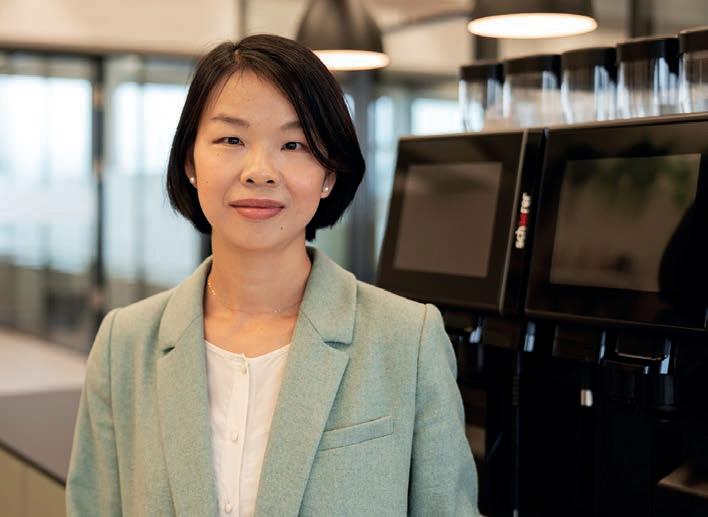



feature currently planned for October, Schaerer is set to embark on a fresh campaign to inform the co ee industry about the new application.
“We are currently testing the product in Europe and seeing very good results,” says Tan.“It will be compatible with all Soul 10 and 12 machines set to self-serve mode. We are con dent in the o cial release timeline.”
Attendees of Host Milano in Italy will be able to see the Easy Access application in use at the tradeshow in October.
“As a company we focus on innovation. We have a long history of making co ee machines and we are still putting that innovation at the heart of what we do,” she says. “We were one of the rst to integrate a modem into a machine to enable connectivity of a co ee machine, we introduced barista-like milk foam from the revolutionary patented Best Foam milk system, and we are still pursuing features that will make high-quality co ee available to more people.” GCR
For more information, visit schaerer.com

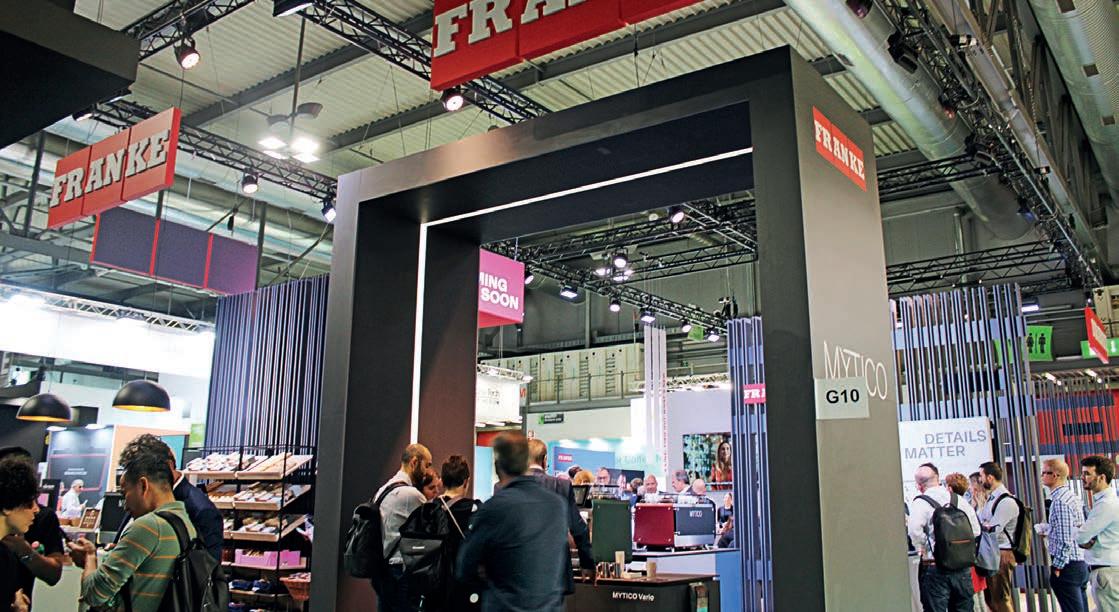
It’s almost showtime for one of the world’s flagship foodservice and hospitality tradeshows – the countdown to Host Milano 2025 is on.
MILAN IS one of the world’s most iconic cities. It’s home to Leonardo da Vinci’s e Last Supper, globally renowned high-end fashion labels, and the rst Starbucks Reserve Roastery outside of the United States. However, every two years the city transforms into a global foodservice destination when tens of thousands of industry professionals descend upon the Fiera Milano Exhibition Centre for the biennial Host Milano tradeshow.
is year’s event is set to be no di erent. Taking place between 17 and 21 October, Host Milano 2025 will bring all corners of the Hospitality, Restaurant, and Catering (HoReCa) sector together to help shape the industry’s future.
Co ee will play a key role at this year’s exhibition. Historically, Host Milano has proved a key reference point for all aspects of the co ee industry through the Salone Internazionale de Ca è (SIC) section, according to Exhibition Director Francesca Cavallo.
“SIC plays a crucial role in showcasing the technical innovation, trends in specialty co ee, and global market development across co ee’s entire value chain,” Cavallo tells Global Co ee Report
“ e co ee industry is renowned for anticipating innovations that subsequently



extend across the out-of-home and hospitality sectors, and Host Milano 2025 is where to nd them. Within this framework, SIC serves as a central hub.”
One key change from previous events for 2025 is the relocation of the SIC section, which will now be placed at the heart of the entire exhibition.
is year, SIC will feature across a pair of connected pavilions and extend into other co ee- and café-adjacent sectors.
“ e central positioning of SIC will facilitate a more intuitive and streamlined visitor experience, enabling smoother cross-tra c between related sectors such as co ee, bar equipment, gelato, and pastry,” says Cavallo.
“It’s a strategic move designed to enhance the synergies between various sectors of professional hospitality. e new layout positions SIC across twin-level pavilions 8 to 12 and 16 to 20, which are connected by a bridge, with an extension into pavilion 18, where it integrates into the gelatopastry area.
“ e new con guration improves the physical ow between halls and places collaborative sectors in closer proximity. is not only makes navigating the fair more intuitive but also encourages unexpected discoveries and crosssector connections that can spark new business ideas.”
Cavallo says the long-awaited return of the World Barista Championship (WBC) will take centre stage at this year’s event.
“Hosting this prestigious event at Host Milano underscores our commitment to the global co ee community and provides a platform for the world’s best baristas to
showcase their skills,” Cavallo says.
e return of the WBC to Milan represents Host Milano’s continued celebration of tradition, which will be presented alongside a range of industry innovations, including those at the revamped Milano Pane Pizza Pasta (MPPP) section.
is marriage of heritage and emerging opportunities showcases some of the best of what Host Milano has to o er, says Cavallo.
“A standout feature of the event is undoubtedly the synergy between traditional sectors and cutting-edge innovation. e revamped MPPP area exempli es this by integrating advanced technologies into the art of baking, while the WBC brings a dynamic, competitive edge to our co ee sector,” she says.
As advancing technology and new innovations continue to shape the global co ee industry, Host Milano will showcase some of the latest marvels that have the potential to change the face of foodservice.
“One of the most anticipated developments is the growing integration of smart automation and arti cial intelligence in co ee machines,” Cavallo says.
“ ese technologies are transforming how co ee is prepared and served, enabling realtime customisation based on individual preferences, greater consistency, and more e cient use of resources. Consumers today expect a more personalised experience, and AI-driven equipment is making that not only possible but scalable across various service formats.”
Also on display at Host Milano will be immersive technology such as augmented and virtual reality, and Internet-of- ingsenabled machines that provide detailed insights into usage patterns, maintenance needs, and consumer behaviour. is data-driven approach is helping operators optimise performance and reduce downtime as businesses adapt to the rapidly changing landscape of global consumption.
However, it appears these advances in technology don’t come at the expense of the continued push towards creating a more sustainable industry.
“ e co ee industry is responding to environmental concerns with innovations that reduce energy and water consumption, introducing more e cient brewing methods, and promoting the use of recyclable and compostable materials,” says Cavallo.
“ is re ects a broader shi in consumer values and a demand for greener practices, even in out-of-home co ee consumption.”
“The coffee industry is renowned for anticipating innovations ... and Host Milano 2025 is where to find them.”
Francesca Cavallo EXHIBITION DIRECTOR, HOST MILANO 2025
With more than 2100 exhibitors from 50 countries and 180,000 professional visitors from 166 nations ling into Host Milano 2023, the show’s 2025 edition is expected to be another signi cant event that will touch on almost all aspects of foodservice and hospitality.
Cavallo believes the success of previous editions, and the expectation of another stellar Host Milano, comes from its standing as “the place where the future of hospitality is written”.
“Host Milano stands out as one of the world’s most successful tradeshow events because it has consistently demonstrated the ability to evolve in sync with the hospitality industry’s rapid transformation, while o ering an experience that is both global in scale and deeply curated in content,” she says.
“But scale is only part of the story. What makes Host Milano truly unique is


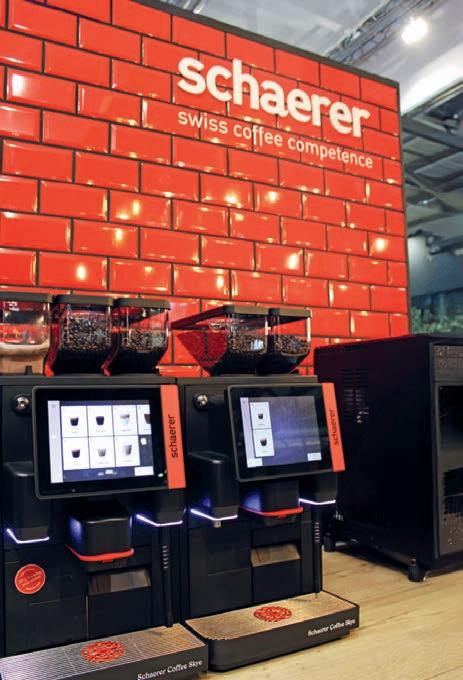

its ability to create a marketplace where innovation, education, and business converge seamlessly. Companies see the exhibition as the ideal setting to launch cutting-edge solutions, whether in automation, sustainability, or digitalisation.
“Visitors, on the other hand, value the opportunity to discover those innovations while engaging in targeted meetings through tools like MyMatching, attending trend-focused events, and gaining strategic insights into new consumption formats.”
For those looking to most e ectively tackle the sprawling event at Fiera Milano in October, Cavallo has some advice on how make the most of their time at Host Milano 2025.
“If you operate in the co ee sector, it’s essential to approach the event with a lot of curiosity, plus a bit of strategy,” she says. “An ideal day might begin with SIC, where you can engage with the latest innovations in co ee equipment, discover new roasting technologies, and experience live demonstrations.
“Between scheduled meetings, you might attend a talk on sustainability in co ee or sample new product launches, before ending the day with informal networking moments or live competitions – like the World Barista Championship – to add an extra layer of energy and inspiration to the experience.” GCR
Host Milano 2025 will be held at the Fiera Milano Exhibition Centre from 17 to 21 October. For more information, visit host.fieramilano.it

Arthur Karuletwa’s mission is to make coffee more equitable for all. Image:
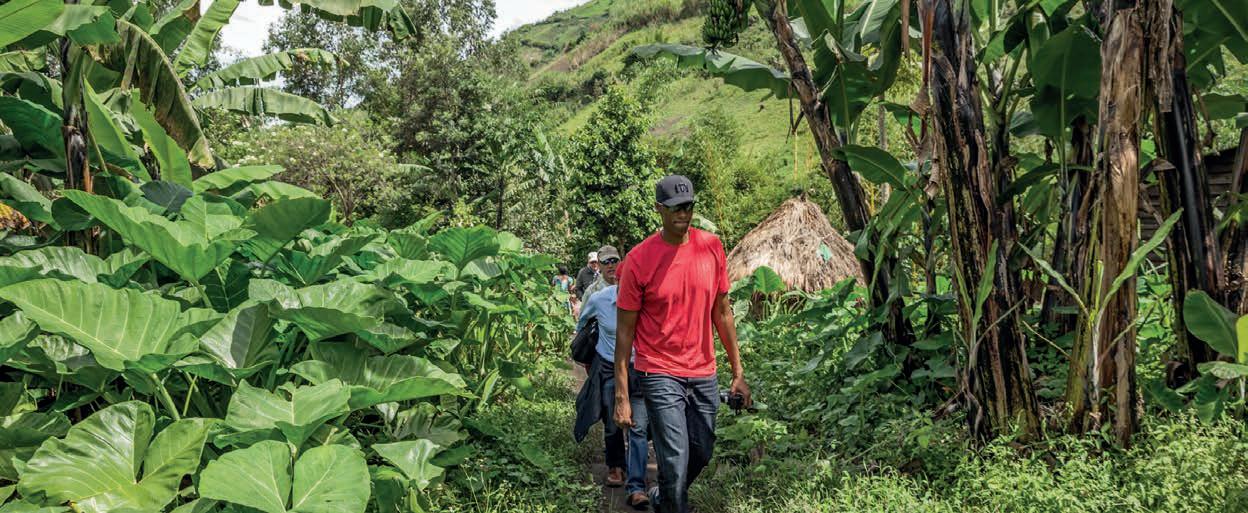







The coffee supply chain isn’t working for everyone, according to Arthur Karuletwa. The VP Sustainability and Impact at Chobani discusses how his experience of witnessing genocide inspired him to use sustainability and traceability as tools for change.
ANY PEOPLE are inspired to pursue a career in the co ee industry because of their love of the beverage. For Arthur Karuletwa, VP Sustainability and Impact at Chobani, it was the opposite.
“I had a vendetta with co ee. Not to be mistaken with the sensory aspects of co ee that most people dislike co ee for, but my dislike for co ee was di erent. It was the ‘origins of co ee’ I detested,” he says.
“While there are many people who don’t like the taste of co ee, I didn’t like the fact that, among other historical aspects, it systematically played a role in one of the most horri c incidences in my mother country’s history – the 1994 Rwanda Genocide against the Tutsi.”
ere were many historical, political, and social factors that played a role in the years leading up to the devastating incident, yet poverty was one of the major in uencers.
“Poverty has a way of eroding a person. It starts with engul ng your identity, then it su ocates your self worth, until your dignity is subdued. is is the moment
you become invisible, and now ‘kill or be killed’ becomes rational. e rationality that justi es the notion, if nobody sees me, I can’t possibly see myself. Until you’ve lived it, you don’t realise there’s a problem that needs to be xed,” says Karuletwa.
“But what does co ee have to do with it? Co ee is the backbone of Rwanda’s economy – it’s the nervous system, the fabric of our society. I feel co ee played a major role in the genocide because of the way it was introduced to Rwanda and how it sustained a cognitive wheel of impoverishment.”
German missionaries rst introduced co ee as a crop in Rwanda in 1904, but it wasn’t until the late 1920s that Belgium expanded its commercial production in the country. As part of their push for production, the Belgians introduced three laws around co ee.
“ e rst was that it didn’t matter how big or small the land, people had to grow co ee, which o en meant reducing the portion of their land dedicated to food crops. e second was that it was illegal

to cut down a tree without permission,” he says.
“ e third was probably the most debilitating: Rwandans could not consume co ee as it was considered ‘for export only’. People were told the myth that it was a Western medicinal product that wasn’t good for them. Local scribes [storytellers] would be used to spread the message around communities.”
It’s said that during the harvest seasons the scribes were given a cup of very potent co ee brewed using a Turkish pot. ey were instructed to drink at least three ounces, which would o en cause heart palpitations due to their unfamiliarity with ca eine. With this rst-hand experience, the scribes were then encouraged to retell their experience far and wide to discourage Rwandans from drinking co ee.
“ ese three laws created a cycle of poverty so dangerous we saw its ugly face in the 1994 genocide,” Karuletwa says.
“I came to terms with the fact that most solutions usually lie at the heart of their problem. And since co ee was the
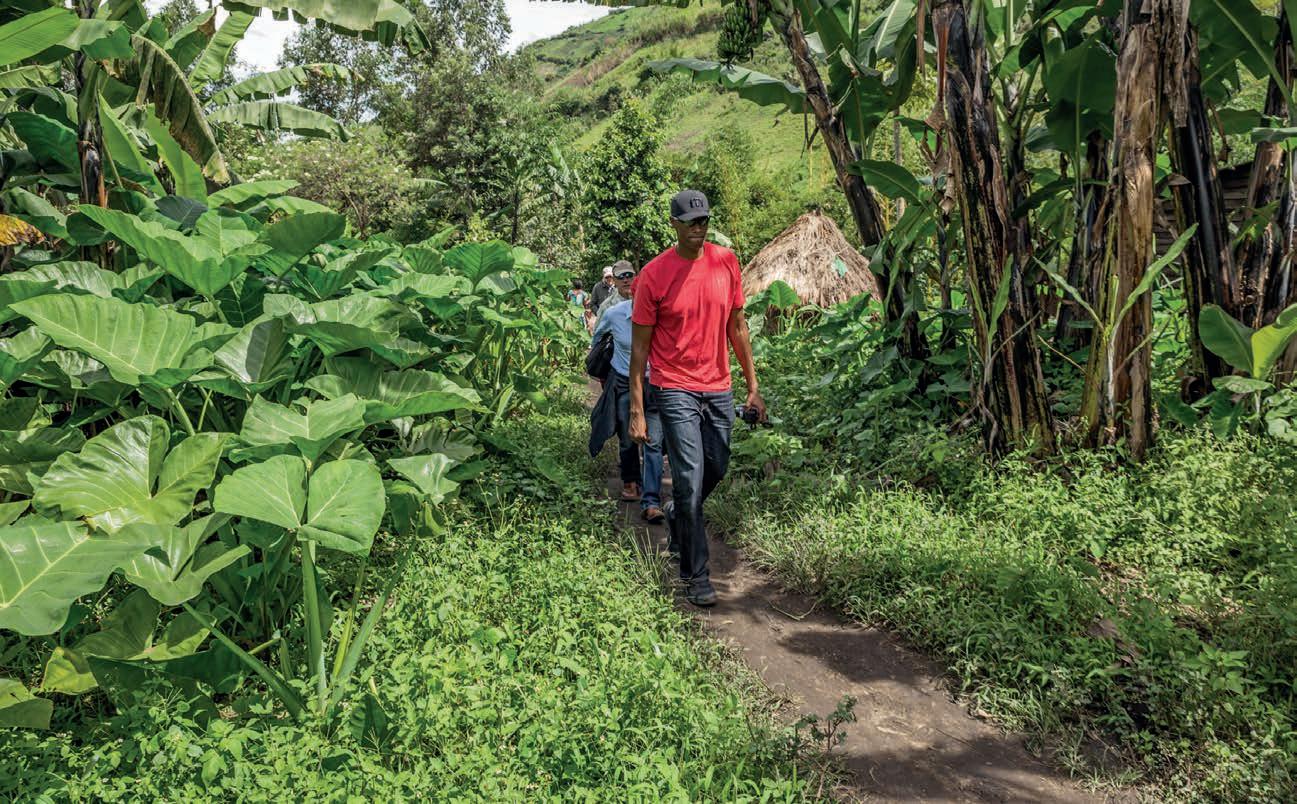
both the protagonist as much as it was the supporting cast, I believed it had the solutions to restore the humanity we had once lost. It is here I decided to wage a war on poverty and use co ee as the instrument I would go to battle with.”
Growing up as a refugee in several East African countries, Karuletwa was awarded a school scholarship to play basketball in the United States soon a er the 1994 Rwandan genocide. A er nishing his education, he sought to ful l his mission through a career in the heart of the co ee supply chain.
“I had an unquenchable purpose that turned into a profession and now it’s a relentless passion,” he says. “I’ve been in co ee for 23 years and worked at every level of organisation – corporate, governmental, and non-governmental – up and down the supply chain. I felt before I could understand what was ailing the supply chain, I needed to complete a full diagnosis.”
Experiencing every element of the supply chain was intentional. Karuletwa wanted to learn every facet of the chain, map it, and understand it at a granular level. rough this extensive experience – which includes time at the Rwanda Ministry of Agriculture, Starbucks Co ee, Westrock Co ee, and now at Chobani, which acquired La Colombe Co ee Roasters in December 2023 – he’s concluded that the co ee supply chain on which the more than US$200 billion industry was built on is no longer working.
“If I was to compare the supply chain to a team sport, it would not be doing well. In a sport like basketball, you win together and lose together, and there is an understanding you are all rowing in the same direction. In co ee, a lot of people win but a lot of people also lose, so we are not playing as a team. Over time it has become imbalanced – some of the supply chain has cracked and broken away,” he says.
“We need to appreciate that in the times we live in, the archaic model we have been using for decades cannot uphold the demand that is now required. ere are many variables that have shi ed the market, from climate and geopolitical issues to the needs and desires of not only the consumers but also the younger and more educated populations in the producing countries who want change.”
Karuletwa believes sustainability and traceability are tools that large co ee companies can use to help rebalance the supply chain. He describes the industry as a living organism that won’t ever stop shi ing
“The archaic model we have been using for decades cannot uphold the demand that is now required.”
Arthur Karuletwa VP SUSTAINABILITY AND IMPACT, CHOBANI
and evolving, thus players in the industry must learn to adapt and pivot. One method he thinks can help them is digitalising the supply chain.
“My hope is that if we can digitalise the supply chain – not just upstream where the co ee is roasted and consumed but also where it is grown – we can better link producers to consumers and quickly diagnose any issues, just like you would in a living organism,” he says.
“Connecting the producing south with the consuming north is imperative in terms of how we understand the well from which we draw our product. A lot of brands struggle to communicate this with their customers because the supply chain is so complex, but it doesn’t have to be that way.”
With climate change increasingly impacting harvests and the rise of disease resistant crops, Karuletwa is con dent a digitalised supply chain can aid the industry’s sustainability e orts.
“Changing weather patterns are not just hampering harvests but in uencing a
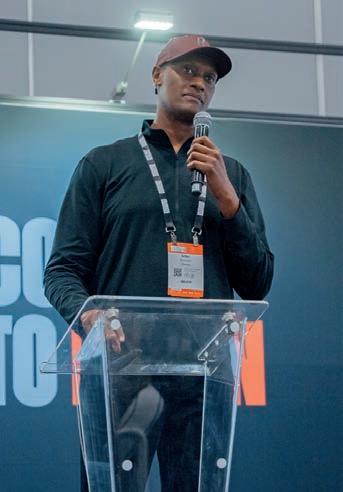

multitude of diseases that are multiplying at a rate we cannot keep up with,” he says. “However, there is a new generation of not just farmers but also roasters and consumers who are more informed and have a desire to change, which is causing big co ee companies to reassess the archaic supply chain.”
Another issue in the current format, according to the VP, is sustaining the labour force at origin to keep up with the increasing demand for co ee. e average age of a co ee farmer varies by region but is around 55 globally. According to the International Co ee Organization, the average age of a co ee farmer in Africa is 60. e cultivation of co ee has long been a generational tradition, yet many young people in co ee-growing communities are seeking opportunities elsewhere.
“We need to look at how we’re going to incentivise the next generation producer to stick around. We need to ask simple questions: are they meeting their cost of production? Are there incentives around premium co ee so they don’t just live but can thrive?” he says.
“Co ee farmers are innovative and are now saying: ‘We understand what it costs for you to deliver cups of co ee to your customers. We’re not going to ask you to pay more than this co ee deserves, so we expect the same for us – we expect to earn what we deserve’.”
Meeting co ee farmers in more than 15 countries around the world over his career, Karuletwa says many tell him the same thing: ‘I love growing co ee, not because it’s going to make me extremely wealthy, but because where the co ee is grown is my wealth, my homeland, my soil. It’s a re ection of generations of culture and traditions. My culture is my wealth’.
“However, if they can’t feed their families, they will be forced to do something else. ey will chop down the co ee trees and grow something else, or they’ll nd a di erent income,” he says.
In 2024, Karuletwa’s work in the industry was brought into the spotlight in the Apple TV series Omnivore. e documentary series narrated by chef René Redzepi explores key ingredients that have built societies and in uenced history. Episode seven delves into the world of co ee, including Karuletwa’s work on tracking the traceability of Rwandan co ee from tree to cup and ensuring producers in the chain were fairly compensated for their work.
“Many big co ee companies are doing what they can to ensure farmers are being
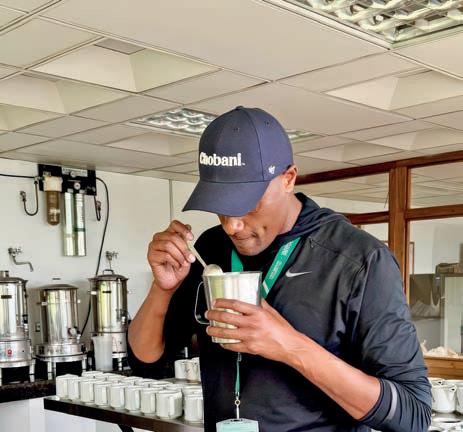
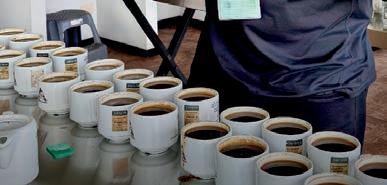



paid fairly, yet it comes back to the fact the supply chain on which they stand is old and brittle,” he says.
“Do these companies have the will to change the supply chain? I think so, but it’s a heavy li and I think it’s going to take the entire industry working together to
discuss and de ne its future in a way that brings equilibrium.”
A er watching the episode, Barry Moore, Managing Director of La Marzocco Australia, was struck by Karuletwa’s work and the powerful storytelling of the series. Karuletwa also featured in the Rise of the Espresso, a lm created through the vision of La Marzocco CEO Guido Bernardinelli.
Moore was so inspired by the two documentaries that, as a member of the Melbourne International Co ee Expo advisory committee, he organised for Karuletwa to speak at the industry tradeshow in Australia to get his story in front of even more people.
“Arthur’s story is extraordinary. A survivor of the Rwandan genocide and former refugee, he has turned co ee into a bridge for reconciliation and a tool for ghting poverty,” says Moore.
“ rough traceability, his mission is to transform an outdated system into something sustainable, reminding us all of the role we play in our daily co ee choices that help develop the lives and communities of co ee farmers around the world.”
As part of his role at Chobani and La Colombe Co ee Roasters, the sustainability
and impact expert continues his work in tackling poverty through co ee and building a supply chain that better bene ts all who interact with it.
“Chobani’s Founder Hamdi Ulukaya has an incredible story that reminds me of the roots from which I came from as an immigrant. He moved from Turkey to the US and built an incredible company through the lens of the soul of people and learning learn from history,” says Karuletwa.
“Products are so culturally ingrained in us, and being able to bring that sense of culture through a product like yogurt can be used as an antidote to connect people and remind us of the humanity we have in us. In parallel, he is challenging us to do the same in co ee, so I was very attracted by his mission and vision.
“Co ee is a commodity that turns into an experience – people have an emotional connection to the product. If you spend any time on a farm, you’ll feel it, you’ll see it, you’ll hear it. So, my question is, how do we upli our supply chain to give it a sense of dignity and hope, and how do we restore one of the most valuable assets that even you and I have – our identity?” GCR





Don’t miss the latest coffee industry news, market reports, must-read features, leader interviews, and more. Global Coffee Report’s weekly newsle er delivered direct to your inbox.















FOR YEARS, the Specialty Co ee Association’s Co ee Taster’s Flavor Wheel has been a badge of honour displayed in roasteries and cafés across the world. e iconic illustrative chart, originally developed in 1995, has become a symbol of the specialty co ee scene as well as a tool to help tasters and roasters describe the kaleidoscope of avours in Arabica co ees.
Yet, despite the Co ee Taster’s Flavor Wheel’s popularity and widespread use, Arabica’s close cousin, Robusta, didn’t have a comparable descriptive tool of its own –until now.
In the early 1990s, Robusta accounted for about 28 per cent of global co ee production, but that’s now climbed to almost 44 per cent. As climate change hampers Arabica harvests globally, many producers are turning to Robusta which thrives in hotter, more humid, and lower elevation environments. e rise can also be attributed to the growth of the Vietnamese co ee industry, which is an ideal origin for the species.
With production rates of Canephora (Robusta is a variety of the Canephora species) growing every year, a team of researchers led by Dr Fabiana Carvalho of the University of Campinas in Brazil determined it was time to develop a Co ee Canephora Flavour Wheel.
“ e initial motivation came from
the realisation that co ee graders in the specialty co ee market were struggling to assess the quality of specialty Canephora species,” says Dr Carvalho. “ is insight emerged during a comprehensive online course we hosted during the pandemic, which attracted co ee graders from around the globe.
“ e course featured two cupping sessions of both low-grade and specialty Canephora samples. It became evident these graders had di culty articulating the attributes of high-quality Canephora co ees.”
e di culty was so pronounced, in fact, that one of the participants later reached out to Dr Carvalho to express surprise at how he scored a speci c sample.
“I received an email from one of the
participants, a grader from Japan. He shared his thought process during the sensory evaluation and expressed his astonishment at a speci c sample he absolutely loved, yet he ultimately scored it as non-specialty,” she says.
“ e grader noted the sample had umami and woody notes. He had learned to classify these avours as o -notes, which led him to give the co ee a low score.”
To produce a avour wheel to be used as a descriptive tool for evaluating the sensory qualities of Canephora, Dr Carvalho and her research team undertook a study to identify the aroma and avour descriptors of the species.
To do this, they recruited a team of 49 professional co ee graders from Brazil
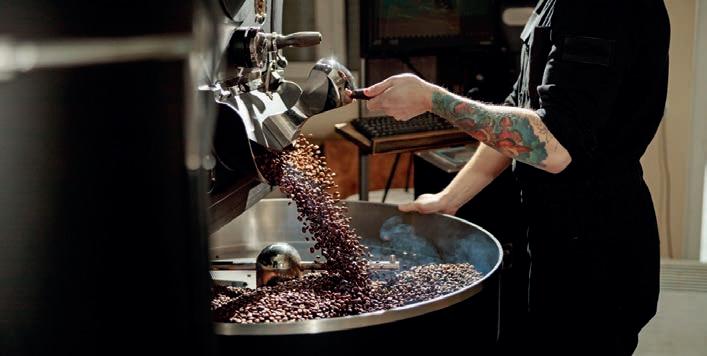

and Europe to represent exporting and importing regions. In three cupping sessions, the graders tasted 67 samples of varying qualities from 13 di erent countries of origin that had been subject to multiple post-harvest processes.
To assess the overall aroma, avour, body, and a ertaste, as well as the nal quality score, the graders used the Rate-All- atApplies list in combination with the Co ee Quality Institute standard cupping protocol.
From this methodology, the group detected 202 descriptors that were then whittled down to 103 to create the threetiered Co ee Canephora Flavour Wheel. is reduction was largely due to merging of terms, such as butterscotch, fudge, and to ee being merged with caramel. Likewise, fruit varieties were condensed to general fruit names, such as cantaloupe and honeydew being listed under melon.
Dr Carvalho says the identi cation of those 202 descriptors showcased just how di erent Canephora’s pro le is to Arabica.
“Having a look into the SCA’s Co ee Taster’s Flavor Wheel, I found out the lexicon on which it had been developed used 105 co ee samples of specialty and low-grade co ees, but only low-grade Robusta was used. us, any positive aroma and taste of Canephora co ees have not been represented in the co ee lexicon nor in the most recent version of the avour wheel,” says Dr Carvalho.
“It is basically a avour wheel developed from and for Arabica co ees. Attempting to t a Canephora co ee into the Arabica framework is di cult simply because it does not align.”
She uses the analogy of referring to the di erences between white and red wines, with Arabica perceived as ‘more delicate’ and Canephora as ‘deeper’.
“A white wine avour wheel, which presents the positive and negative attributes for white wines, is not an appropriate tool for the evaluation of red wines,” Dr Carvalho says. “High tannin, high woody, and high brown spicy notes are positive for red wines, but negative for white wines.”
In line with the Co ee Taster’s Flavour Wheel, the descriptive terms in this new wheel are organised in hierarchical categories. Tier one features broader avour categories such as fruity, tier two features more detailed subcategories such as stone fruit, and tier three features the most speci c descriptors such as plum.
Dr Carvalho and team hope the wheel can be used as a tool to “identify, understand, and map the sensory characteristics of
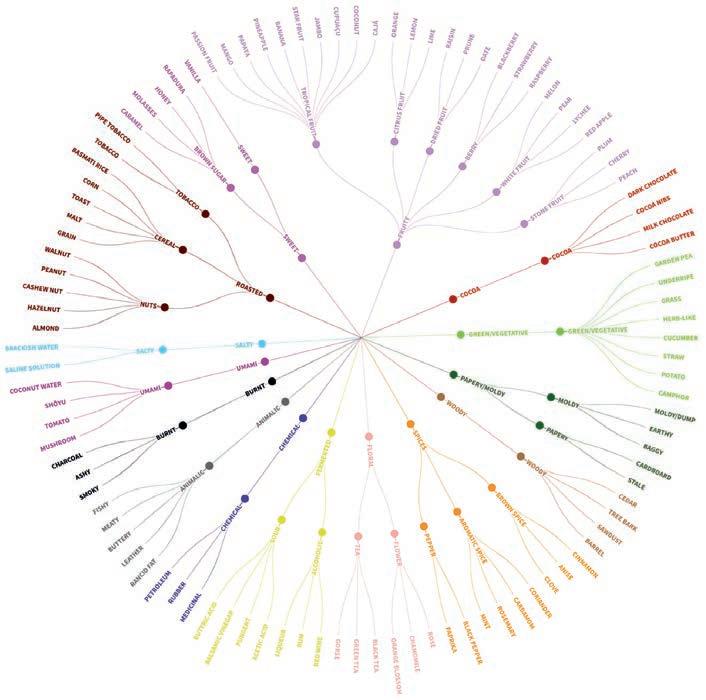
Canephora”. ey believe standardising the terms used to describe the aromas and avours of the species will not only bene t the co ee industry but also scientists working to improve quality.
“Historically, Canephora has been less valued than Arabica for being mistakenly considered to be a worse product in terms of quality, forcing it towards highly commoditised markets. is assumption of low quality has de ected the capture of Canephora by alternative supply chain mechanisms and weakened the motivation for quality improvements,” she says.
“ e avour wheel was developed to simplify and standardise the description of Canephora co ees. As a descriptive tool it can be used to identify, understand, and map the sensory characteristics of Canephora that are most important or valued in di erent markets. e standardisation in the descriptive analysis is important not only for the co ee industry, but also for scientists working on quality improvement.”
e research team are also hopeful that the development of the Co ee Canephora Flavour Wheel can continue to highlight quality Robusta co ees.
“Canephora has not even been referred to as ‘specialty’. e division has been so remarkable that when referring to high-
quality co ee, the term ‘specialty’ speci cally concerns Arabica,” says Dr Carvalho.
“I believe opinions are shi ing. Research has shown Canephora grown in di erent terroirs and subjected to controlled postharvest fermentation processes can achieve improved cup quality. ese ndings suggest opportunities for sensory pro le diversi cation and the potential for acceptance and recognition of Canephora in the specialty co ee market.
“It is crucial for graders to understand there is a market for specialty Canephora. e avour wheel aids in facilitating communication among the various players involved in co ee production and trading.”
Now the new avour wheel has been developed, Dr Carvalho hopes Canephora will no longer be in Arabica’s shadow. Yet, her research into the species doesn’t stop here.
“ e expansion of avour wheel research is its application to understand di erent markets and how to promote specialty Canephora,” says Dr Carvalho.
“It is very important to narrow the gap between the industry standards and consumer demand for Canephora co ees.
“Our future research will de nitely include consumer testing to characterise the consumer’s sensory vocabulary, as well as understand acceptance and preference.”


THE LATEST INTERNATIONAL COFFEE INFORMATION, DELIVERED TO YOUR DOOR
Global Coffee Report is the leading business magazine covering the international coffee industry. In-depth features explore on-the-ground developments at origin, coffee pricing issues, technology updates, research breakthroughs, and much more.
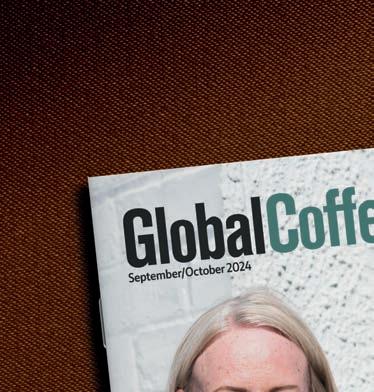
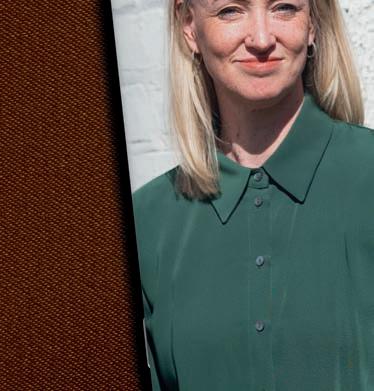
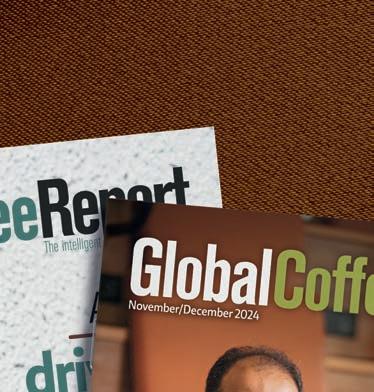

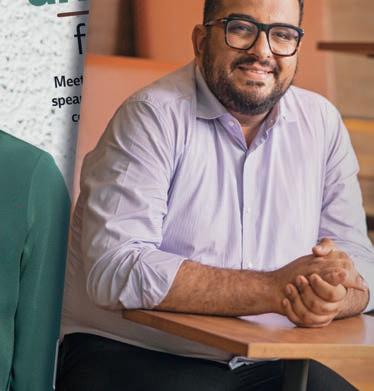



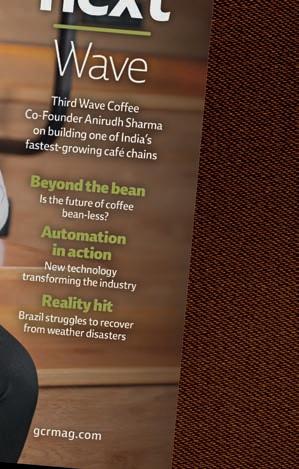


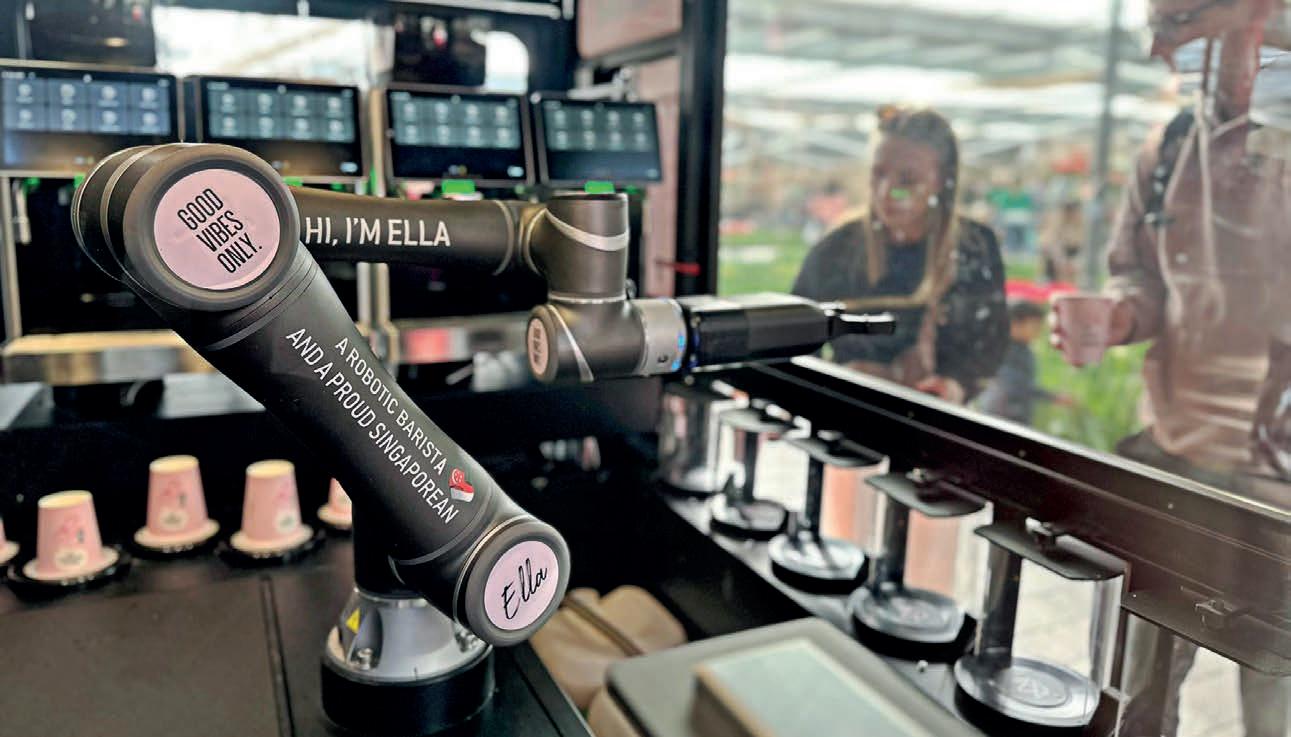
gcrmag.com/subscribe

ROBOT BARISTAS









Automation is becoming more commonplace in cafés and coffee service, but is new technology here to take part or take over?
RE THE DAYS of the traditional barista coming to an end? e short answer is no, but robotics and arti cial intelligence stand to signi cantly and perhaps permanently alter the profession as we know it.
Robot baristas are on the rise. No longer restricted to the lobbies and o ces of techforward, innovation-loving organisations, they’re becoming more commonplace in public and communal spaces, and o er a quick and easy ca eination station for those looking for a at white or cappuccino on the go.
Asia is at the forefront of this technological innovation, but there are a range of established companies and brighteyed startups popping up across the world angling to be the leader in the next great foodservice frontier.
Whether it be Chinese company HiDolphin taking its COFE+ robots into new international markets, or Kazakhstani so ware engineer Ismail Karankin earning $150,000 in Silicon Valley investment for his Oli Robotics startup, the robot barista revolution is not just coming, it’s already here.
ere’s also Houston’s Rice University partnering with Cerēs to place a robot barista on its business school campus, or Crown Digital’s Ella robot expanding
through Singapore and Southeast Asia.
But how will this ongoing change impact the current café landscape and shi the role of the barista in the co ee experience?
The café conundrum
e ongoing skilled labour shortage in hospitality is not restricted to any single nation. It’s a problem impacting the sector all over the world, with only few potential solutions on the table.
With labour shortages o en comes higher labour costs and high turnover rates, all of which continue to feed into ongoing di culties being absorbed by the sector at large.
Keith Tan, the Singaporean entrepreneur behind Ella, initially created the robot as a solution to the labour shortage problems he was experiencing in his own cafés.
Since then, Ella has evolved to its sixth generation and is gaining traction around its native market of Singapore. e robot, whose name takes inspiration from Tan’s wife, Ellie, and the hit Rihanna song Umbrella, is now found in locations around Singapore and has expanded into the Philippines. Its technology has also been showcased in global hubs like Silicon Valley, Dubai, and Tokyo.
Tan says his understanding of cafés as a business model enabled him to build Ella to
not only meet the demands of a café setup but also the demands of the customer.
“As a café owner, I understand the business and I understand my customers. My rst café largely served an o ce crowd, so I would know ‘John’ would come in every day and want his at white a certain style, and that never changed,” says Tan.
“‘John’ would want speed and would not want to be standing there waiting. Because I knew his order, I could see him walk in and start making the co ee. He didn’t have to say a word.
When Tan built Ella, he knew the robot had to be fast, so he integrated two Eversys Enigma machines for a total of four brew heads to make four cups simultaneously.
“Our regular customers are on the Ella app and signed on with our subscription deals. ey are ordering on their phones before arriving to pick up their co ee. is convenience is where Ella really makes a di erence,” he says.
“Ella isn’t just a robot, she is part of an intelligent platform that includes a proprietary mobile app, remote diagnostics, real-time analytics, and cloud orchestration.”
While co ee vending machines have already taken o around the world, Tan says the inclusion of the high-quality Enigma machines along with independently
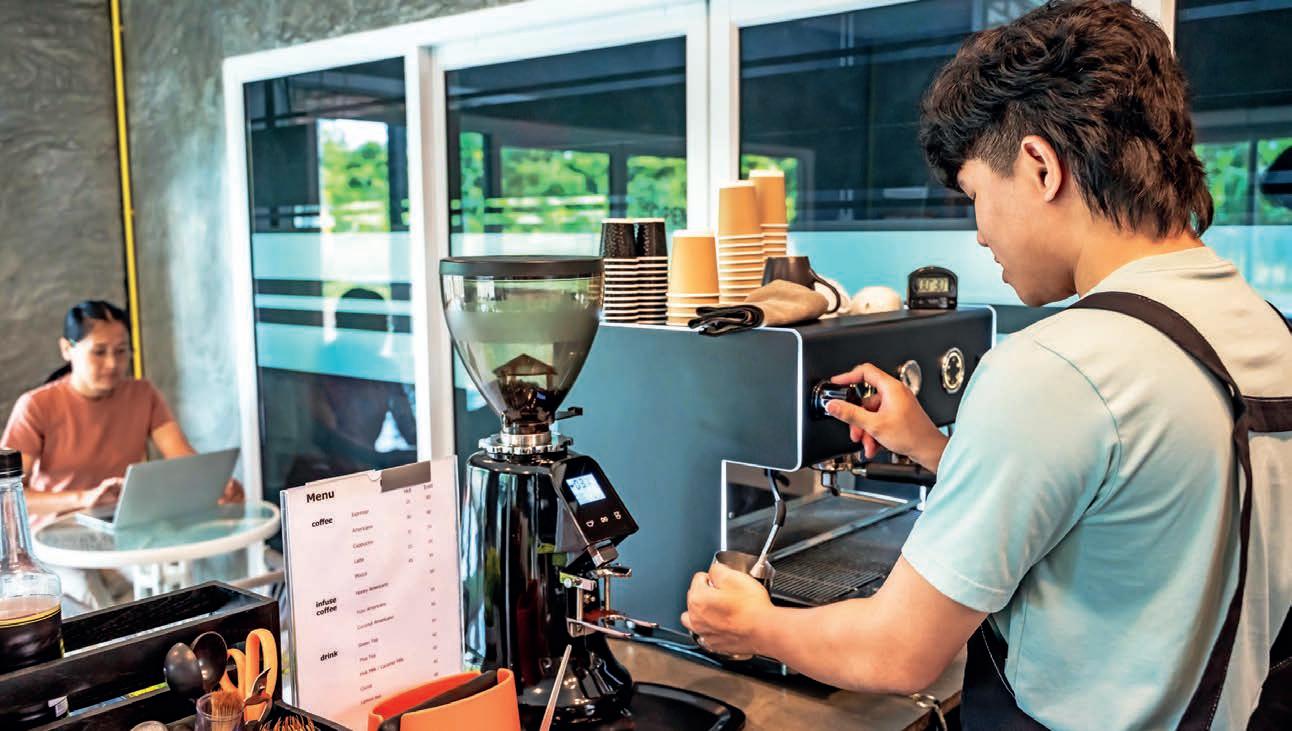
sourced products can make a fast co ee to the same standard as a barista.
“We use fresh milk and a full-bodied 20 per cent Indian washed Robusta blend we get roasted in Italy. e machine can churn out high numbers of co ees 24/7 at a consistent quality,” he says.
“ e average consumer will recognise a good co ee if it’s strong enough. We found the kind of taste that hits the palate of the mass majority, and it’s a full-bodied, balanced, chocolatey taste.”
One of the most common criticisms of the incorporation of robot baristas in traditional café settings is the potential to detract from the ‘café experience’. e co ee industry is one steeped in tradition, and for all the speed, e ciency and potential cost-saving measures a robot barista can o er, the human touch is unable to be replicated.
Former Chinese Barista Champion, Simon Sun, operates Marus Co ee and Marus Co ee Academy in Suzhou, China. He believes while there is certainly a place for robot baristas in the global co ee landscape, their primary function remains di erent than that of a traditional barista at a café that promotes specialty co ee.
“I think robot baristas could be a good choice for a commercial brand that’s looking to make a signi cant number of co ees per day, but it is very di cult to match a specialty co ee experience,” says Sun.
“ e biggest challenge is the robot
barista cannot serve the emotional value to consumers when they buy something, it’s just a totally di erent business model.
“ ey are incredibly useful for hightra c markets, but I think there are two challenges that must be considered in that we have to balance the income and the cost of the robot, and the category of products served can’t be overly complicated.” is high-tra c location logic is no more evident than in the use of Chinese company Hi-Dolphin’s COFE+ models.
According to an automated sales pitch received by Global Co ee Report, COFE+ operates in some of China’s most famous tourist attractions including the Terracotta Warriors, Shanghai Bund, Oriental Pearl TV Tower, and East Nanjing Road, with robots that have been continuously operational for more than 1500 days.
Tan believes applications of robot baristas will soon shi from these high-tra c locations into in-house café settings, but the results will be positive for much of the existing labour force.
“People shouldn’t be worried robots are going to take away barista jobs. Highly repetitive work everywhere is being automated, so where does that leave the human labour? I believe you’re going to see human baristas really stepping up their game in the next ve to 10 years,” he says. “ ey are going to be the ones creating the best user experience, sourcing the best beans, creating the best drinks, and be the masters of that. en they can teach the robot to replicate what they do.
“When it’s rush hour in a café and the
barista doesn’t have time to talk to you or even look at you, there’s no human touch there. Robotics means cafés will be able to pay head baristas and high-quality creators more money to cra and curate their menu.
“I see there being a shi towards humans being able to do what humans are meant to do, which is create. Not do the repetitive tasks that can easily be achieved – o en to a better standard – by automation.”
Funding the next frontier?
Cost, as mentioned by Sun, is o en seen as one of the biggest restrictions for implementing robotics in any industry. In Ella’s case, the cost of the robot, Eversys machines, and everything else it needs to operate is currently north of US$100,000, but that’s coming down.
Tan admits this initial outlay is costly, but says it is dwarfed in comparison to the cost of setting up a traditional café.
“When I rst built Ella, she cost about $200,000. Today, we’re close to $100,000,” he says. “As volumes increase, we will see prices dropping further, opening up adoption of robotics to a wider audience.
“I always say Ella is like a café on wheels, because you have everything you need for a café inside Ella. e only incremental part is you buy the co ee, robot, and computer.
“Let’s say you buy a top of the range machine with four brew heads, then you need to buy your grinders, fridges, point of sales system, ice machine, and you build a counter and renovate your store. at comes in at about $200,000.”
e return on investment of a robot

barista, when placed in the right location and operated correctly, leans strongly in favour of automation, according to Tan.
“If you purchase a base unit for $100,000 and sell between 400 to 500 cups per day, the return on investment is about six to eight months. You will enjoy a 40 to 50 per cent net margin moving forward, while in a traditional café with labour and operational costs, that net pro t is about 10 to 15 per cent.
“ is is where I think automation will really thrive, in that it will increase net pro ts for operators.
To highlight this, he points to an Ella installed in one of Singapore’s hospitals.
“She makes about 100 cups of co ee between 12am and 6am, then another 200 cups between 6am and 9am when the morning shi comes in, so by 9am Ella has made 300 co ees in an autonomous, unmanned shop,” he says.
Human vs machine
It’s no secret that automation has been successful at streamlining operations, improving safety, and lowering costs for businesses in a range of industries.
E-commerce giant Amazon is a titan of automation in its ful lment centres across the United States and the rest of the world, but a reported 25 per cent in cost savings has come in tandem with a drop of 50,000 total employees between 2021 and 2024.
In that time, however, the total package delivery service of the company has boomed from 5.1 billion to 6.1 billion parcels per year.
Amazon and e-commerce are not the
co ee or foodservice industry though, where automation has struggled to fully embed itself in the sector to date.
Key recent examples include McDonald’s shutting down its AI drive-thru technology in July 2024 a er three years of testing, while Zume Pizzam a Californian fully automated pizza parlour, closed its doors in 2023 a er initially opening to great fanfare in 2015.
e challenges associated with creating success in hospitality do not necessarily lend themselves well to AI and robotics, however, those challenges are being assessed and, in some cases, overcome.
Within the unique landscape that is foodservice, co ee remains its own beast.
e traditions of café culture coupled with those who thrive on the enjoyment of specialty co ee and the creativity of a skilled barista may never change, and that’s almost inimitable.
But the industry is changing, and Sun believes human and robot baristas can work together to further the co ee as a service industry around the world.
“I think robot baristas and human baristas should serve di erent types of co ee consumers, but both can work together in di erent work ow areas of daily operations,” he says.
“I think robot baristas will be the next trend in China because the volume of co ee consumption is rising incredibly fast, and big commercial chains like Luckin Co ee already prefer fully automatic machines.
“At Marus Co ee, I would honestly say we probably would not use a robot barista right now, because we are a specialty co ee




brand that is very dependent on humanised services, but I cannot say we will never consider it.”
Tan says the lack of history of robotics in foodservice will only be a limiting factor for as long as there are those who oppose the change.
“It has been a challenging journey creating Ella, because robots are not found in our daily lives,” he says. “To put them into a very unstructured and dynamic work environment such as a café has taken a tremendous amount of work.
“You must rethink how technology like robots t into a commercial environment where they previously didn’t exist, because the robots designed for factories are not designed for back of house of cafés.”
As robot barista technology continues to progress, Tan says we are only at the start line of co ee’s next great technological leap forward.
“With generative AI and large language model (LLM) reasoning, robots can be integrated with cognitive abilities and able to see, listen, reason and act. is frontier technology is enabling the rise of embodied AI-like humanoids, and we are actively working on these breakthroughs which will enable the crossover to café use,” he says.
“I think there is a massive industry disruption coming that is going to be driven by champions like me and my cohorts that are trying to solve the pressing labour problem facing cafés. We took the bold step and saw the labour challenge is not going away, and it’s going to become a bigger problem down the road unless we do something about it.
“Ella represents more than just a machine: she’s a step towards a new era of customer service where AI, robotics, and hospitality blend into one experience. We’re just getting started.”


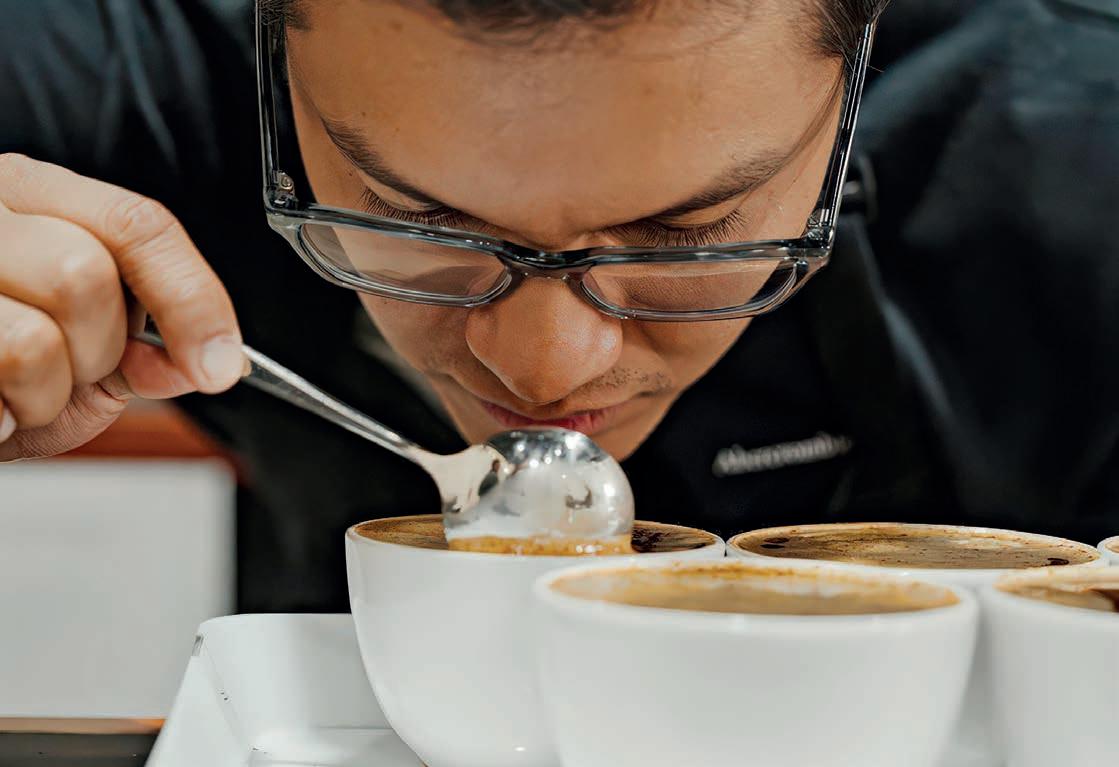



TChanges to the Q Grader program are set to drastically alter how coffee is assessed, but is it for the be er?
HE COFFEE VALUE chain is made up of constantly moving parts. It’s an industry where nothing stays the same for long and innovation reigns.
Sometimes, changes are small in scale and may only impact a solitary farm or individual roaster. Other times, though, they come in the form of sweeping policy reform that changes the landscape.
e announcement of the evolution of the Specialty Co ee Association’s (SCA) Q Grader quali cation falls somewhere around the latter category. Since its implementation in 2004, the licensing process for Q Grader – a globally recognised certi cation for co ee professionals that validates their skills in assessing and evaluating co ee quality –has remained largely untouched despite signi cant industry volatility. Until now.
A er more than 20 years of operation, this change will be one of the largest shi s in the program’s implementation.
Starting from 1 October 2025, the Q Grader program will evolve to be more closely aligned with the SCA’s Co ee Value Assessment (CVA), which was implemented in 2022 to o er a broader and more holistic approach to co ee assessment.
e SCA says while the initial program has played an important role in aligning the global co ee industry, it must adapt to keep up with a rapidly evolving sector.
“At the heart of this shi is a belief in a more equitable value distribution across the supply chain. As the organisation behind the cupping form that became the industry standard 21 years ago, the SCA is in a unique position to lead the evolution of how we evaluate co ee,” the SCA tells Global Co ee Report
“Given the original 2004 cupping form –or versions of it – is still widely used across the industry, we knew introducing a new approach to assessing value would take time and care.
“ e original form played a critical role in establishing a shared sensory language. However, it hasn’t evolved alongside the industry. Today, we recognise it no longer re ects the best practices in sensory science and fails to account for the many factors that in uence the actual value of the co ee.”
is closer alignment to the CVA looks to be a natural progression for the Q Grader, given the SCA’s desire to see its new system adopted across the globe.
e CVA utilises four assessment types to create a more complete picture of

any given co ee, and was developed in consultation with the industry, scientists, and researchers.
ese four assessments – physical, descriptive, a ective, and extrinsic – are, ideally, completed independently of each other to avoid bias.
e SCA started its review of the cupping system back in 2020 to more closely align the Q Grader to address gaps that have emerged in the system as the industry has evolved.
“It o ers a more complete and modern framework – one that brings together sensory analysis, physical quality, market context, and relevance to buyer preferences,” says a spokesperson from the SCA.
“Aligning the Q Grader program with the CVA ensures cuppers are not only experts in avour evaluation but are also equipped to assess co ee in ways that are more re ective of how values are determined in the real world.”
For those currently engaged in receiving their Q Grader licence, or looking to achieve the quali cation prior to 1 October 2025, nothing will change.
e Co ee Quality Institute (CQI) will remain involved in delivering the
curriculum until the changeover date, when the 20-plus years of partnership in delivering the program will end.
At the time of the initial announcement revealing the changes, CQI CEO Michael Sheridan expressed his pride in the organisation’s extended involvement in global co ee assessment.
“We are proud of the role CQI has played in the rst 20 years of the Q, and we are honoured by the way it has been embraced in the co ee industry,” says Sheridan.
Perhaps the largest change, though, is the decreasing importance of the score of the co ee. While scoring will remain an important part of the process, the SCA says the evolution of the industry means more factors must be considered.
“Scoring is still part of the picture, but we’re moving away from treating it like the whole story,” the SCA says.
“ e new program breaks it down – what co ee tastes like, how it was grown or processed, how someone might respond to it emotionally. It’s not about replacing scores, it’s about giving more context to what those numbers mean.
“It gives it a wider lens. Instead of only focusing on avour or chasing a number, it trains cuppers to assess and communicate everything that adds value to a co ee, from its physical traits to its story. It re ects how professionals actually make decisions in the real world, whether they’re a producer, trader, buyer, or quality consultant.”
At the time of writing, the CVA is in the process of being adopted by some of co ee’s largest international production markets, including Brazil, Colombia, and Indonesia.
e Brazilian Specialty Co ee Association, Colombian Co ee Growers Federation, and Specialty Co ee Association of Indonesia have all signed


Memorandums of Understanding with the SCA to implement the CVA.
is means it is in the process of being implemented in three of the four largest co ee producing countries on the planet.
e SCA says the adoption of the program by these nations adds further credibility to the CVA.
“Over the past two years we’ve piloted courses, lectures, and dedicated CVA events, developed comprehensive training materials, and gathered feedback from a global network of cuppers, producers and educators. is deliberate process has helped ensure the CVA is practical, e ective, and globally relevant,” the SCA says.
“When major producers adopt the CVA it’s a sign that this approach works not just in theory but on the ground. It helps producers speak the same quality language as buyers, which can lead to better recognition, better prices, and better alignment across the value chain, and it sets
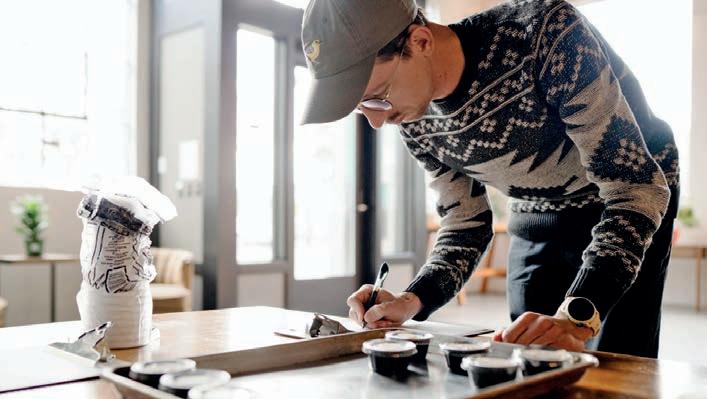
an example other countries can follow.
“Integrating the Q Grader program is about more than just updating content – it’s about aligning the program with what the industry needs today and supporting professionals as they adapt to a more complete and inclusive way of assessing co ee.”
However, the Q Grader assessment will largely remain the same until the October changeover to allow the large-scale coordination of the upcoming changes. ose with certain quali cations, including the SCA Sensory Skills Professional Certi cate, current or lapsed Arabica or Robusta Q Graders, Q Instructors, and Q Assistant Instructors can also fast track their evolved Q Grader licence by completing the CVA for Cuppers course by 31 December 2025.
e SCA emphasises that the transition has been shaped with the global community in mind.
“Changing a program this foundational doesn’t happen overnight—and it shouldn’t,” the SCA says.
“We’ve been listening closely, consulting widely, and working alongside instructors, producers, and cuppers to build a path forward that’s thoughtful, inclusive, and clear.
“ is phased approach was designed to give the community time to adapt, while continuing to o er access to existing courses and creating new, supported entry points into the updated system. It also ensures the nalisation of the new Q Grader curriculum, the onboarding of instructors, and the honouring of all CQI-led courses scheduled through 30 September.”


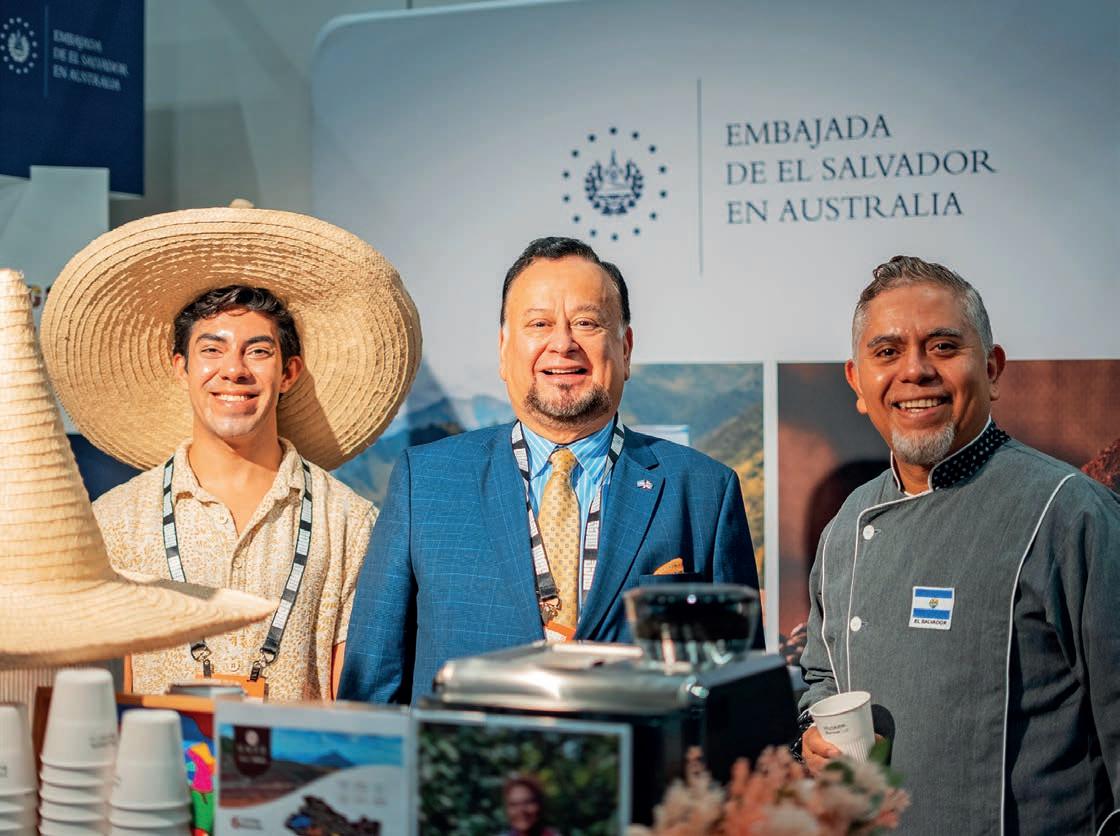

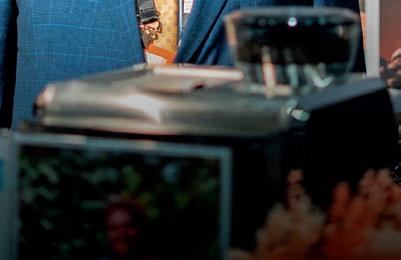
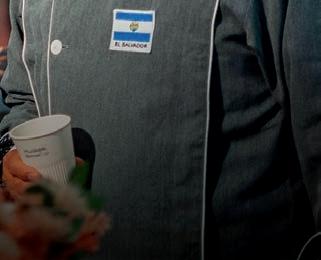
Some of Latin America’s smaller coffee producers took centre stage at MICE2025 and are already preparing to return bigger and be er for next year’s event.
LATIN AMERICA is a powerhouse of global co ee production. It’s the international engine room formed on the bedrock of the Brazilian and Colombian co ee commodity titans.
Five of the world’s top 10 co ee producers come from the region and, between them, produce more than half of the world’s co ee. e harvests from Latin America o en come to de ne the costs and pro tability of the global scene.
Spanning Central and South America –as well as some Caribbean nations – the cluster of countries there are almost all, in some parts at least, situated in the bean belt, from Mexico on the Tropic of Cancer down through to southern Brazil and Peru on the Tropic of Capricorn.
In a time when co ee production challenges continue to impact the sector, the continued growth of these nations shows smaller producers can reach a balancing act between commodity and specialty co ee and thrive in the face of challenging circumstances.
At this year’s Melbourne International Co ee Expo (MICE), the largest co ee-
dedicated tradeshow in the Southern Hemisphere, delegations from El Salvadorian, Costa Rican, Ecuadorian, and Guatemalan embassies and businesses travelled to Melbourne on trade missions in the hope of engaging the international co ee community and furthering the growth of their products.
One such representative was Urku General Manager, Sebastian Pinto, who attended MICE2025 to progress the ambitions of Ecuador’s burgeoning co ee sector.
“Latin American co ee is like a symphony of avours brewed in the heart of the new world,” says Pinto of Urku, an Ecuadorian co ee shop and chocolaterie in Melbourne’s inner south-east. “What truly distinguishes it is the sheer diversity that comes from an incredible combination of microclimates, altitudes, and indigenous knowledge passed down generations.
“You’ve got the nuanced acidity of the high-altitude Guatemalan, the chocolatey body of a good Colombian, and then Ecuador is a kaleidoscope of pro les that makes Latin
American co ee so fascinating.”
Pinto adds the aspects that make Latin American co ee so special are shown to the fullest potential in Ecuador’s rich soil.
“Ecuador o en ies under the radar, but it’s a hidden gem thanks to its volcanic soils and dramatic altitudes, with co ee grown on small, family-owned farms nestled in the Andes,” he says.
“Because of the terrain, farmers are forced to innovate. Even a di erence of 100 metres in elevation in Ecuador will see beans with a totally di erent pro le, even if they’re from the same farm.
“You cannot have at lands of monoculture crops. With the Andes cutting the country in half and the presence of the volcanic soil, you get an incredibly unique co ee aroma and pro le.”
Across Latin America, like the rest of the world, some aspects of co ee farming remain steeped in tradition. But some of the smaller, bolder producers of the region are leading the way in creating a new generation of sustainable, economical, and equitable co ee farming.
Costa Rica is among those producing
countries. Boasting one of the most naturally biodiverse environments in the world, it is at the forefront of new sustainability initiatives to protect its remaining natural beauty from the damages of deforestation.
“Costa Rica is one of the few co ee producing countries that’s aiming for net zero emissions by 2030 in its co ee production,” says Gonzalo Quesada, Deputy Head of Costa Rica’s MICE2025 delegation.
“One of the key policies around co ee farming in Costa Rica is that someone who wants to start a new co ee plantation is not allowed to engage in deforestation, so it must be at a place where a co ee or di erent type of plantation already existed.”
Costa Rica is also making the most of the strength of the industry to improve education and employment outcomes for the families of those embedded in it.
“Our governments, throughout history, have taken into account how important co ee has been for the development of Costa Rica as a nation, so they’ve tried to protect the producers and their families,” Quesada says.
“I believe one of the best things being done in Costa Rica now is continuing to focus on the people behind the product. We have social programs for co ee pickers and their families in the co ee plantations called Casas de Esperanza, which can be translated to ‘Houses of Hope’, where the children of the co ee pickers can attend school and don’t have to move around outside the plantation.”
Also in attendance at MICE2025 was the Latin American Business Council, and representation from El Salvador, who returned to MICE for the rst time since 2015 to proudly display their Café de El Salvador co ee.
As a nation that has consistently earned praise for its tropical and vibrant Pacamara varietal, its government has refocused its support of the co ee production industry to growing its specialty co ee sector and away from commodity co ee.
Counsellor for the Embassy of El Salvador, Cristian Figueroa, says MICE2025 was the perfect landscape in which to both create and improve connections across the global co ee sector.
“In the past few years, we have been moving away from the commodity market and towards the specialty segment, and that change has been strongly supported by our government in El Salvador,” says Figueroa.
“MICE gave us a global stage to tell our story, meet potential partners, and learn from some of the best operators in the business.”
Cristian Figueroa COUNSELLOR, EMBASSY OF EL SALVADOR
“Now we are trying to organise international co ee trade missions to build a real brand identity around Café
El Salvador, which is the brand we are promoting.”
He adds it is important to continue to grow international awareness of El Salvador’s specialty co ee boom.
“MICE gave us a global stage to tell our story, meet potential partners and learn from some of the best operators in the business. It’s a convention where innovation meets tradition, it’s something that is familiar to everyone but there are a lot of new and exciting things in the industry.
“For small producers like El Salvador, it’s a place where we can shine and connect with the broader co ee community.”
Since MICE2025 wrapped on March 22, interest in this year’s Latin American exhibitors has converted into genuine
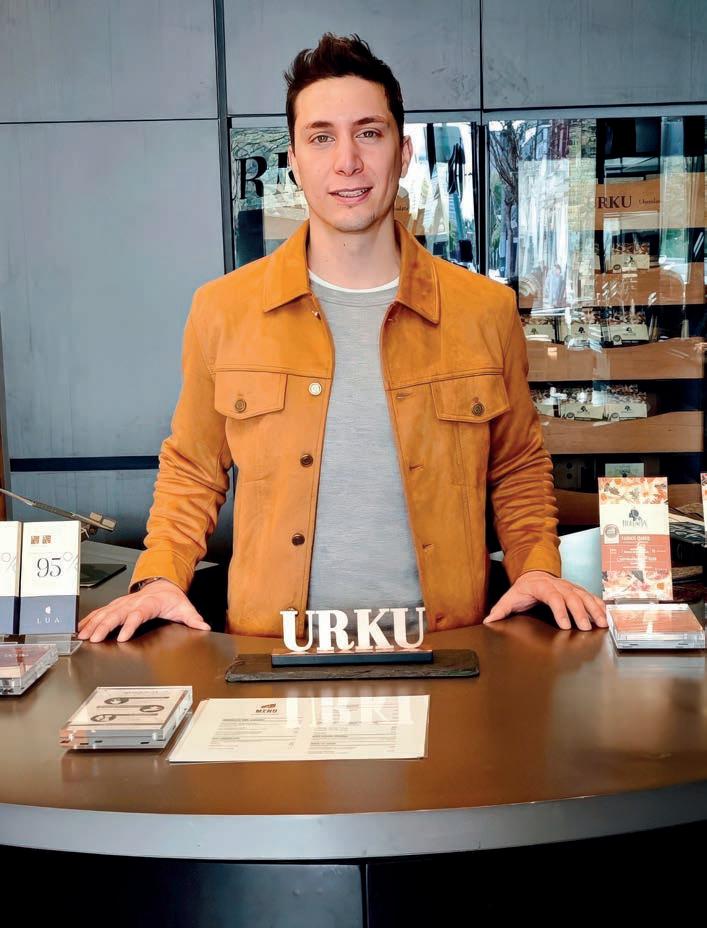

Any new coffee farms in Costa Rica must be built on existing agricultural land. Image: Thomas/stock.adobe.com.
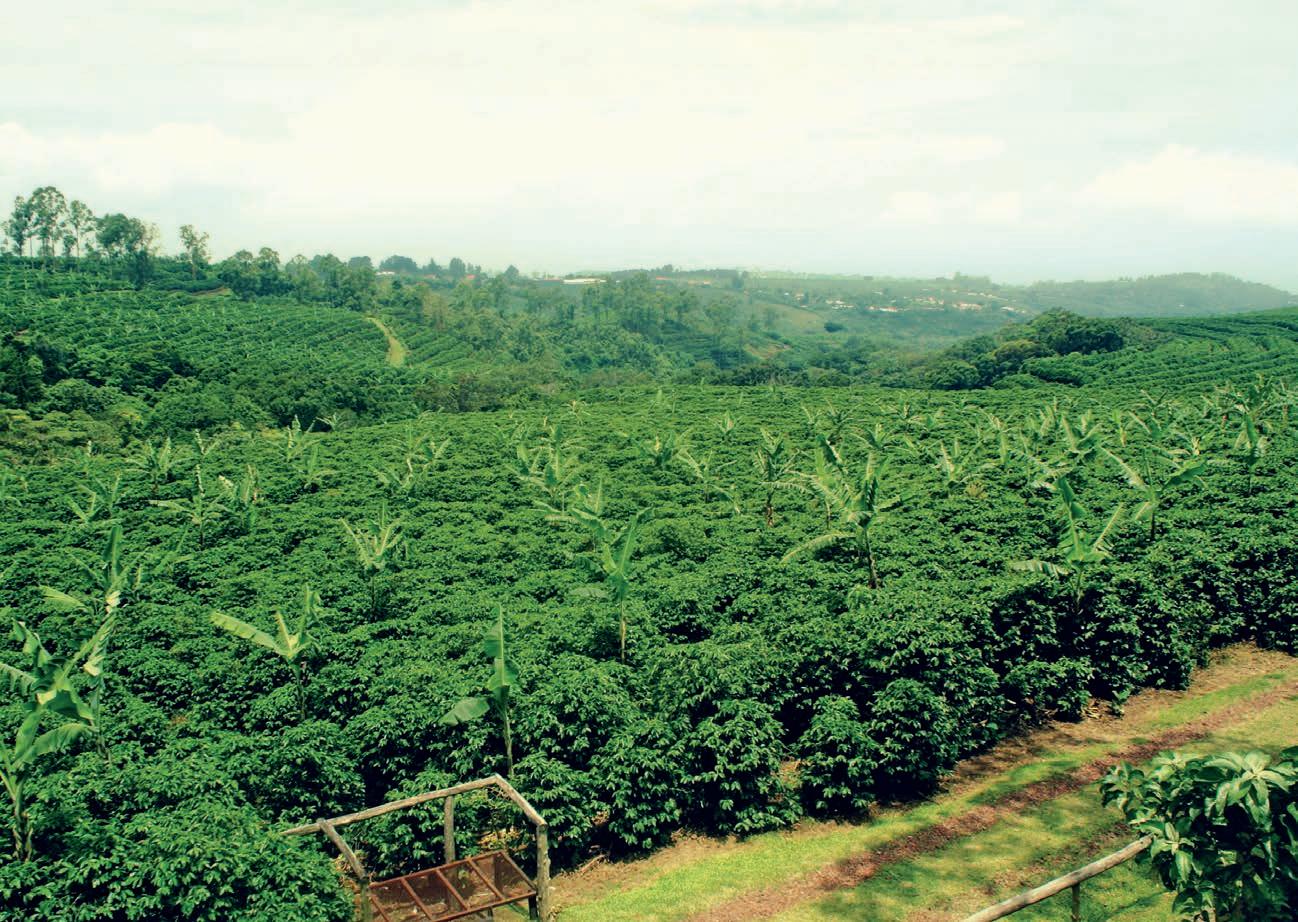
business opportunities for Costa Rican producers and brands, according to Quesada.
“ e embassy was there to support the real experts who came from Costa Rica, and our stand created 86 leads for Costa Rican businesses,” he says.
“ ey took those leads back to Costa Rica. I was speaking with one of them recently and they told me they already have something concrete planned with a roaster here in Australia, so we’re already seeing the results of attending the event.
Quesada says “MICE2025 was amazingly valuable” due to all people from the value chain of co ee production gathering in one place.
“You can nd CEOs of companies, baristas, roasters, and importers – it was a great place to connect with all of them,” he says.
It’s thanks to Melbourne’s discerning co ee culture and audience that the Ecuadorian business experienced great audience engagement.
“ e enthusiasm for farmer-owned enterprises was incredible to witness and people were genuinely interested in the farms, the farmers, and the soil. It was
heartening to see our biodynamic e orts resonate so strongly,” Pinto says.
“People were eager to learn about our processes, why we embrace biodynamic practices, and the communities we represent.”
He adds there was extensive interest in both commodity and specialty co ee from attendees and fellow exhibitors.
“Even the exhibitors who mainly deal in commodity wanted to reach out and access Q-graded beans with scores of 88 and above,” he says.
Onwards and upwards
Over the course of MICE2025, more than 31,000 attendees and 130 exhibitors from the international co ee community led into the Melbourne Convention and Exhibition Centre (MCEC). With the bar set higher than ever before, event organisers are excited about the potential of MICE2026.
Next year’s dates are locked in for 26 to 28 March 2026 at the MCEC.
Producer representation has long-been celebrated at MICE and will become a bigger focus at next year’s event. MICE Events Director Siobhan Rocks says
the next phase in co ee education, and bridging the gap between consumer education of crop to cup, is bringing origin to Melbourne.
“We’re excited to announce the introduction of a new MICE feature called Trip to Origin. is designated area will celebrate the very rst step in the co ee value chain, our co ee farms and farmers. We want to invite our visitors to explore origin without having to travel thousands of kilometres outside of Australia,” says Rocks.
“We envisage a space that transports attendees to origin, surrounded by co ee trees, hessian bags, and educational devices that help explain the detailed and intricate processes of co ee production.”
e new space will be an educational hub demonstrating di erent processing methods, varietals, and co ee innovation at ground level. It will provide a platform for green bean traders, dedicated country embassies, and co ee producers to make new business contacts and partnerships.
e space will also invite co ee lovers and consumers to better understand the co ee value chain through invitational speaking positions and seminars from Australian and international representatives.

“Education and consumer connection with farmers has long been a goal for many co ee roasters, and is as important as ever to celebrate,” Rocks says. “Having a better understanding of the production process and ongoing challenges facing our aging population of farmers is crucial to the wider Australian community understanding the industry’s justi cation for higher co ee cup prices. It is this shared knowledge that can really help bridge that lack of connection, empower co ee drinkers to value the beans in their daily cup, and appreciate this incredible profession.”
Where business comes to play
It’s already con rmed the Latin American Business Council and international delegations from the region will return to MICE in full force.
Pinto says Ecuador is ready to once again to make its presence felt and believes eyes should be on what the nation’s co ee industry has in store over the remainder of 2025, and beyond.
“We’ll be back with even more con dence and ready to share the fruits of our labour. We’ve got some exciting new projects brewing and we’re expecting some amazing discoveries,” he says.
“MICE is more than just a tradeshow, it’s a
“[MICE] is where serious conversations happen, and it’s where producers, roasters, tech innovators, and traders all come together.”
Cristian Figueroa COUNSELLOR, EMBASSY OF EL SALVADOR
dynamic hub for innovation, collaboration, and knowledge sharing. It’s a place where you can discover cutting-edge concepts, connect with like-minded individuals, and explore the best expressions of co ee around the globe.”
Figueroa adds that plans are already in place for El Salvador to present its specialty sector in a more powerful and vocal way.
“We want to more strongly present the role El Salvador can play in terms of providing quality co ee to the world through our Café El Salvador product. Pacamara is our pride and joy. It was
created in the 1950s by Salvadoran geneticists and it has become one of the most awarded co ees in the world,” he says.
“We can see everybody tries to bring something new and di erent to the experience, and we don’t want to fall behind. We are already planning the best way to present our Pacamara co ee and tell the unique stories El Salvador has to o er the international co ee industry.”
Figueroa says there is so much innovation around co ee in Australia, and Melbourne speci cally, adding MICE provides an incredible platform to bring the industry together in a place where everyone is so passionate about co ee.
“It is where serious conversations happen, and it’s where producers, roasters, tech innovators, and traders all come together,” he says. “It drives trends and shapes the future, and gives countries like El Salvador a seat at the table.”
GCR
MICE2026 will take place at the at the Melbourne Convention and Exhibition Centre from 26 to 28 March 2026. For exhibitor inquiries, please contact Mike Wilson at mike.wilson@primecreative.com.au

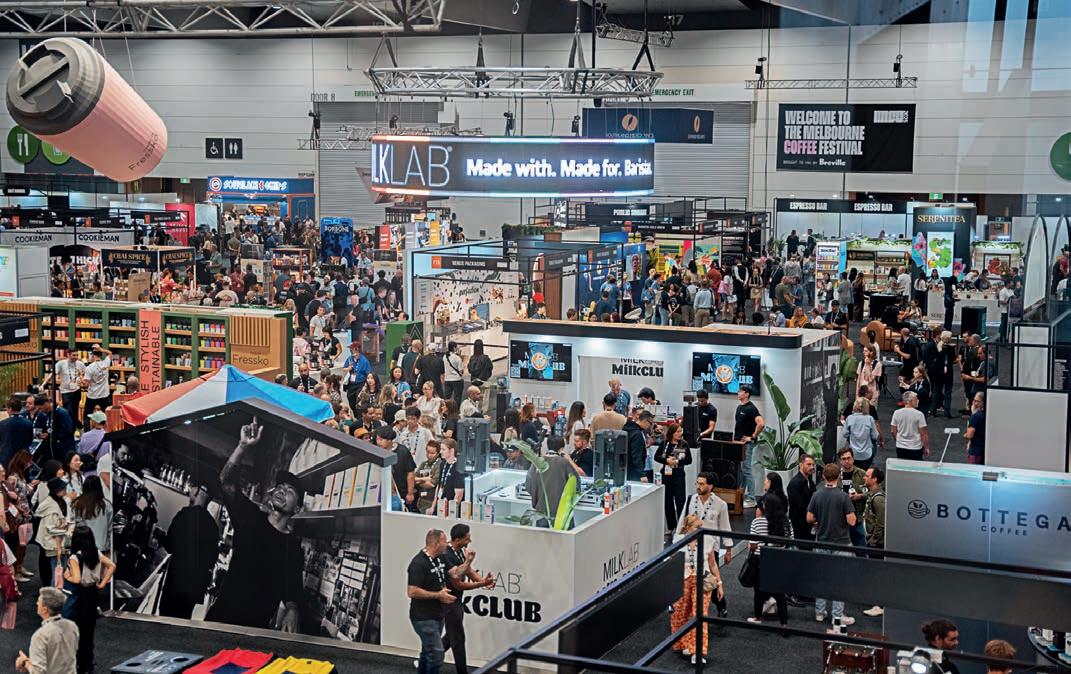


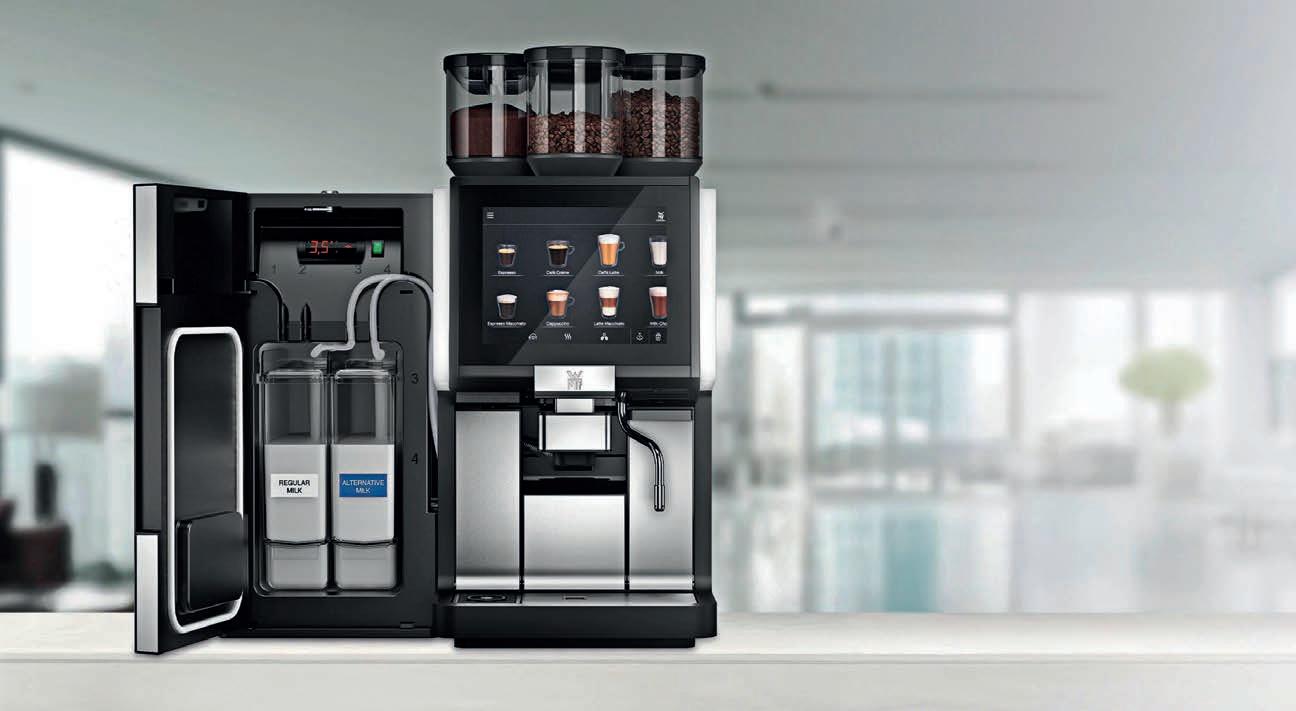



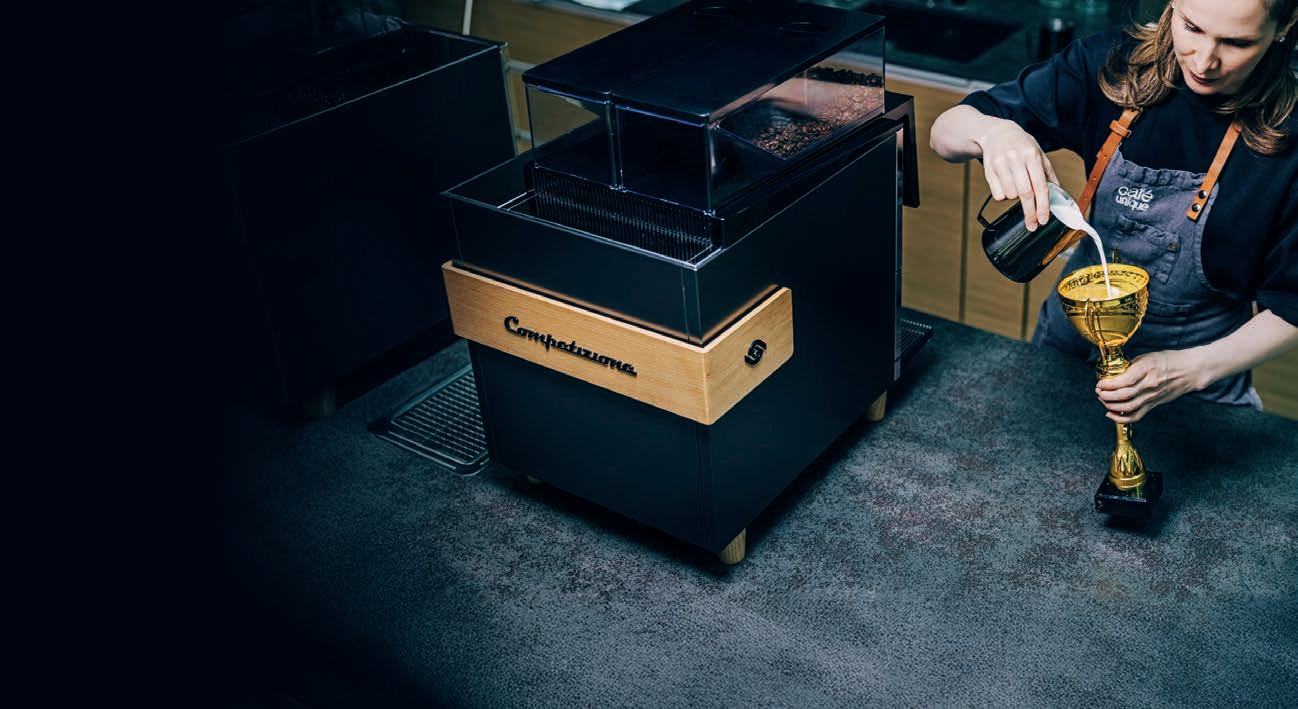



WMF Professional Co ee Machines is extending its 2-Milk-Solution to the WMF 1500 S+ specialty co ee machine. The 2-Milk-Solution enables customers with medium co ee demands to also o er plant-based beverages, while processing dairy alternatives as e ciently as traditional dairy milk to meet evolving customer preferences. Recipes using these alternatives can be easily stored in the machine’s memory and selected with the touch of a button during everyday service. With a recommended daily capacity of 180 cups and three product hoppers for various beans, powders, or toppings, and the 2-Milk-Solution, the WMF S1500 S+ enables business owners to expand the variety of co ee creations they can o er.
For more information, visit wmf-coffeemachines.com


She made history as the first fully automatic co ee machine on stage at the World Latte Art Championships. Chosen by the Specialty Co ee Association for its unmatched precision, the Competizione delivers perfect temperature stability, consistent extraction, and powerful steam performance, even under pressure. Whether its 10 espressos in a row or hours of heavy use, the quality is designed to never waver.
The intelligent steam wand combines two functions: AirSteam for fully automatic milk frothing with customisable settings and AutoSteam for baristas who want full manual control. ISQ Technology can provide top co ee quality, regardless of the operator. Designed for professionals who won’t compromise, it’s available in three elegant finishes: chestnut wood, premium polymer, or durable metal – and can be customised to fit any interior. From world stage to your café: performance that inspires.
For more information, visit thermoplan.ch Thermoplan Black&White4
1 1
PARIS, FRANCE
1 July 2025
Following the success of its inaugural event in 2024, which saw more than 200 international co ee professionals from across the supply chain gather to discuss the industry’s pressing issues, Beantropy returns in July 2025.
e second edition of the specialty-focused event in Paris will feature conferences, masterclasses, tastings, and workshops, and welcome international speakers from around France and the world. Topics to be covered include the Soil of Excellence competition and new business opportunities in the specialty sector. beantropy.com
2
SINGAPORE
16 - 18 July 2025
SIGEP Asia showcases the entire co ee and tea supply chain: from specialty co ee beans and tea leaves to roasters, grinders, and barista equipment. e tradeshow caters to a wide range of processing techniques and tastes.
e chocolate section of the event will bring together the best Italian and international manufacturers in chocolate production, machinery, equipment, and accessories. e exhibition will also celebrate artisan gelato, pastry, and bakery.
sigepasia.com.sg
8
5 6
3
KUALA LUMPUR, MALAYSIA
30 July - 1 August 2025
e 23rd edition of the Malaysian International Food & Beverage Trade Fair will take place at the Kuala Lumpur Convention Centre.
More than 12,000 visitors and 50 exhibitors from more than 50 countries are expected to attend the event, which will feature a tradeshow exhibition, conference talks, expert masterclasses, and more, targeted at a number of industries – including co ee and tea.
mifb.com.my
4
BEIJING, CHINA
29 - 31 August 2025
Established in 2013, Café Show China is a professional co ee exhibition held at the China International Exhibition Center (Chaoyang Hall) in Beijing.
e 2025 edition is expected to welcome more than 300 exhibitors from across the co ee supply chain – from beans to syrups to equipment suppliers. More than 10 delegations from co ee producing countries are also anticipated to attend. Alongside the exhibitors, the event will host a series of barista tasting competitions, roasting competitions, and cup tasting activities.
cafeshow.cn
Let’s Talk Coffee
LIMA, PERU
25 - 27 September 2025
Organised by co ee importer Sustainable Harvest, Let’s Talk Co ee is an annual supply chain gathering. Now in its 20th year, it brings together roasters, growers, and other stakeholders in the co ee supply chain to share knowledge and build relationships in a relaxed setting. e invitation-only event is said to bring together leaders from across the supply chain to learn from each other and do business.
letstalkcoffee.org
host.fieramilano.it 2 3 4 5 6 7 7 8
SAN DIEGO, UNITED STATES 10 - 12 April 2026
In 2026, Specialty Co ee Expo is rebranding to join the stable of World of Co ee tradeshows hosted by the Specialty Co ee Association (SCA). e series will debut in North America as World of Co ee San Diego in April 2026. e show will showcase a wide range of exhibitors, workshops, technology, and international competitions, including the World Latte Art Championships. rough the rebrand, the SCA hopes to further its mission of connecting people in the industry, facilitating partnerships, and providing a platform for professionals to engage with the trends shaping the future of specialty co ee.
coffeeexpo.org
MILAN, ITALY
17 - 21 October 2025
e professional hospitality exhibition returns to Milan in October 2025 for its 44th edition. e biannual event is speci cally aimed at the HoReCa industry and provides a global platform for professionals in the sector to come together. Host Milano attendees will have the opportunity to learn about the industry’s supply chains, consumer trends, and more as the event o ers in-depth analysis on technologies and new innovations to help equip hospitality and catering businesses with the tools to succeed.
Melbourne International Coffee Expo
MELBOURNE, AUSTRALIA
26 - 28 March 2026
Melbourne International Co ee Expo (MICE) is the largest dedicated co ee event in the Asia-Paci c. MICE connects café owners, roasters, equipment manufacturers, service suppliers, and more to facilitate real business opportunities. e 2025 event saw 31,000 visitors attend the three-day expo at the Melbourne Convention and Exhibition Centre. MICE2026 will once again host the Global Co ee Report Leader Symposium and Café Owners Education Series. MICE welcomes the international co ee community to explore the Australian market and maximise growth opportunities.
internationalcoffeeexpo.com




A Venetian café has given a new meaning to ‘a taste of Italy’ by purifying contaminated canal water to craft espresso.
CANAL CAFÉ, located in Venice, Italy, has turned the city’s famous canals into an innovative and climateconscious source for espresso production.
e new café opened during Venice Biennale Architecture 2025, where visitors could order co ee made from puri ed water sourced directly from the Arsenale Lagoon.
e innovative and sustainable invention has cast a new light on urban water systems, through turning a vital resource and popular tourist attraction into one of Italy’s cultural rituals: drinking espresso.
e café was designed by New York rm Diller Sco dio + Renfro, which masterminded a concept that is sure to attract co ee drinkers and tourists – even if just for the novelty.
In an interview with Time Out magazine, Diller Sco dio + Renfro Co-Founder Elizabeth Diller highlighted the signi cance of the project.
‘It’s about combining the sort of pleasure of drinking beautiful espresso while also thinking about the complexity that it takes to actually have potable water,’ says Diller.
‘I will drink the rst cup of espresso, and I will be the guinea pig.’
So how does the system work?
e café, located at the back of the Arsenale site, uses a hybrid naturalarti cial puri cation system developed in collaboration with American water system engineering company Natural Systems Utilities, and the Italian environmental and water engineering company Sodai.
e project was also supported by WeBuild.
A transparent pipe draws canal water into a bio- ltration system that removes sludge, toxins, and pathogens while preserving bene cial minerals.
e process is split into two paths. One stream ows through a living, plant-based system that acts as an arti cial wetland
populated by salt-tolerant halophytes and ‘good’ bacteria that clean the water naturally.
e other stream undergoes reverse osmosis to remove salt and micro-particles, followed by UV disinfection. Finally, the two streams are blended to provide potable water to brew a mineral-rich espresso.
rough this uni cation of pioneering technology and infrastructure, café goers can, quite literally, have a taste of Venice. What makes this co ee experience even more unique is that each step of the ltration process is visible to the public.
e system is trackable and monitored in real time to ensure safety and water quality.
And the ripple e ects could go far beyond co ee. Venice is a UNESCO World Heritage Site and has faced decades of challenges from ooding, pollution, and the pressures of mass tourism.
Due to climate change and rising sea levels, Venice’s MOSE system was installed to protect the city from storm surges.
Director of the 2025 Biennale Carlo Ratti explained in Time Out that Venice will simultaneously be grappling with the challenges of having too much water and

Café goers can sip espresso brewed from canal water. Image: P_edits/stock.adobe.com.


ensuring there is enough drinkable water.
‘We could say that the project is a prototype of the global dilemmas we face in a time of increased climate change when our infrastructures must adapt,’ says Ratti.
ose behind the water ltration system at Canal Café believe it demonstrates a working prototype for micro-scale water puri cation that has the potential for global applications.
At a time when sustainability in co ee is largely focused on sourcing, packaging, and emissions, the team behind the initiative believe it reorients the conversation towards water – a fundamental and o en overlooked element of the co ee equation.
“Every cup of espresso is 90 per cent water,” says one engineer on the team.
“If we rethink water, we can rethink everything.”
While it’s a novel concept, consumers will ultimately vote with their feet – and that comes down to taste.
According to café visitors, the espresso carries a subtle mineral quality, adding a depth to the co ee without compromising the expected avour of a classic Italian double shot.
As the global co ee industry confronts the challenges from water scarcity to climate change, Canal Café has proposed a culturally signi cant and functional blueprint for a sustainable co ee brewing solution.
So it’s perhaps no surprise the installation won the Golden Lion for Best Participation at the 19th International Architecture Exhibition – La Biennale di Venezia, Intelligence. Natural. Arti cial. Collective.
According to judges, it was awarded not only for its excellence in design but also for its reimagining of urban systems and cultural signi cance. GCR
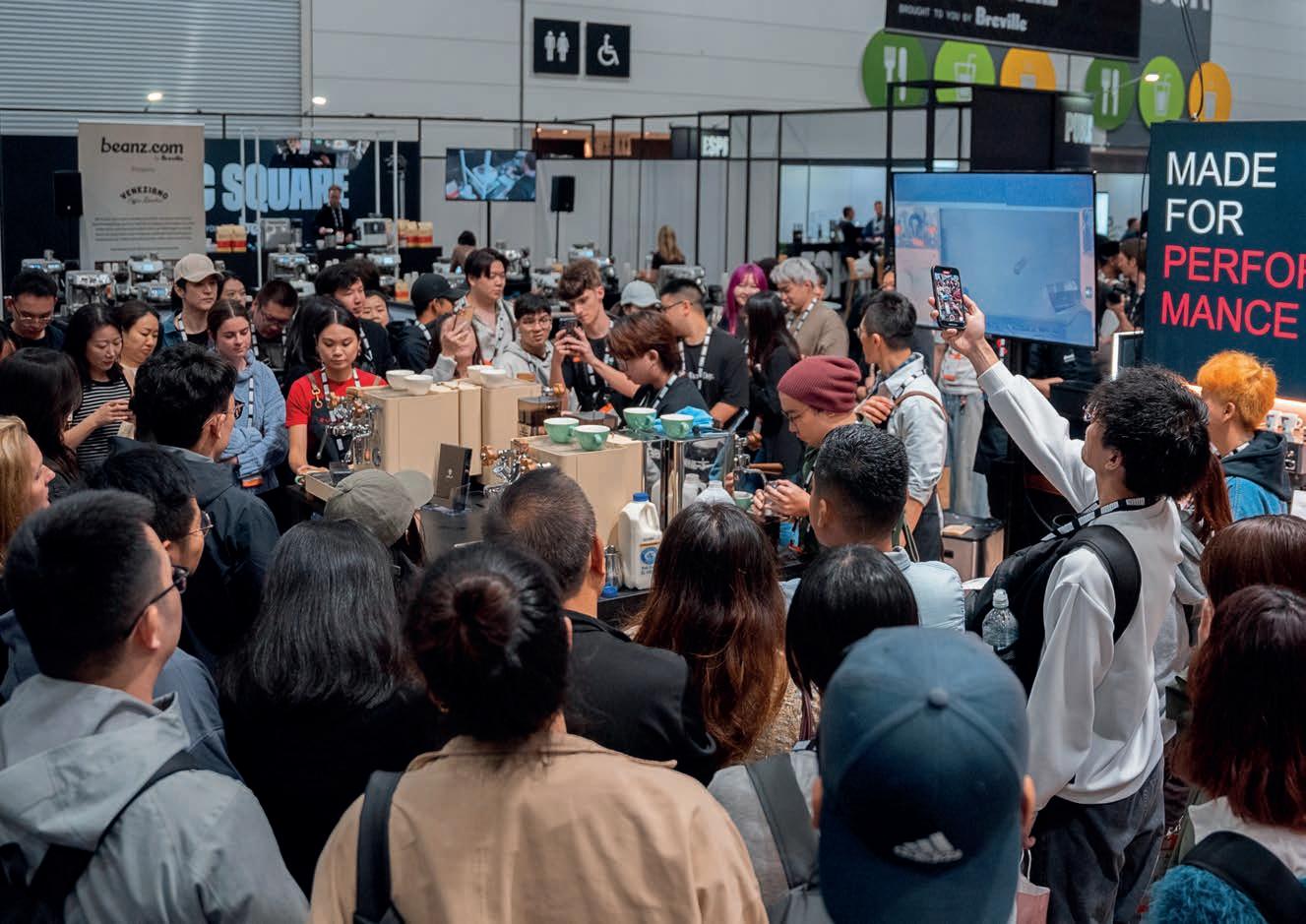

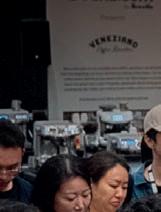


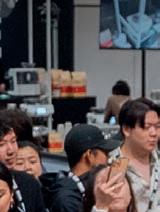
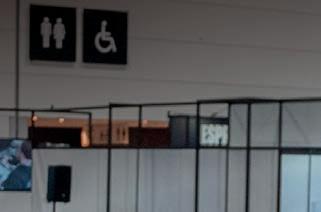




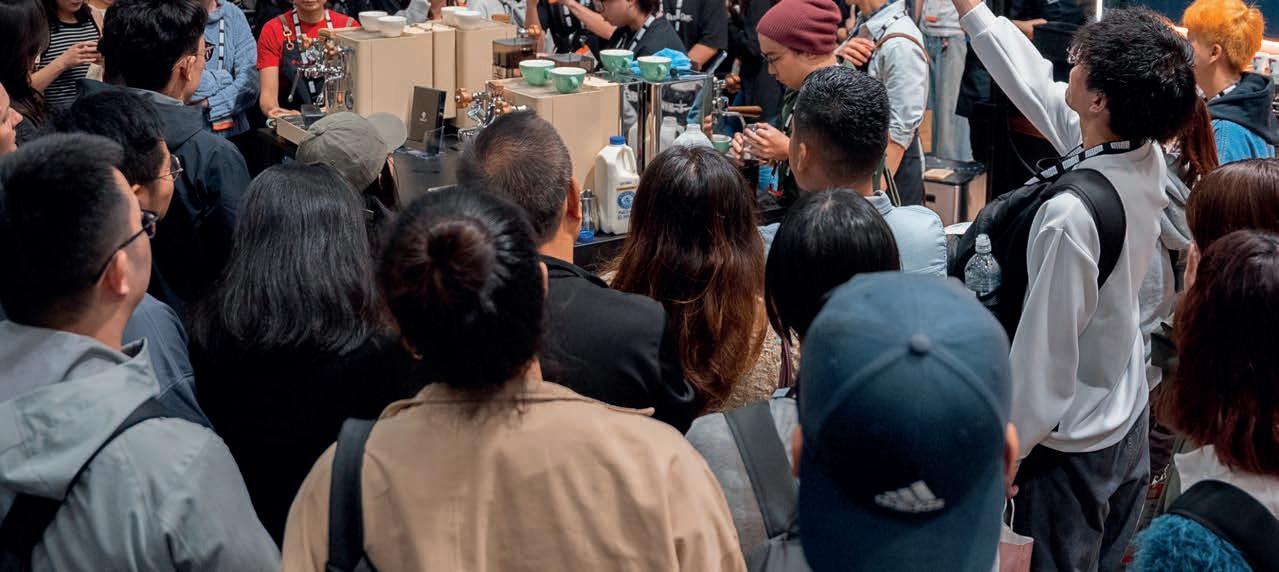

Become a part of the world’s destination for coffee at MICE 2026. Don’t miss out on the opportunity to contribute to the southern hemisphere’s leading coffee event.
Melbourne Convention and Exhibition Centre 26–28 MARCH 2026
